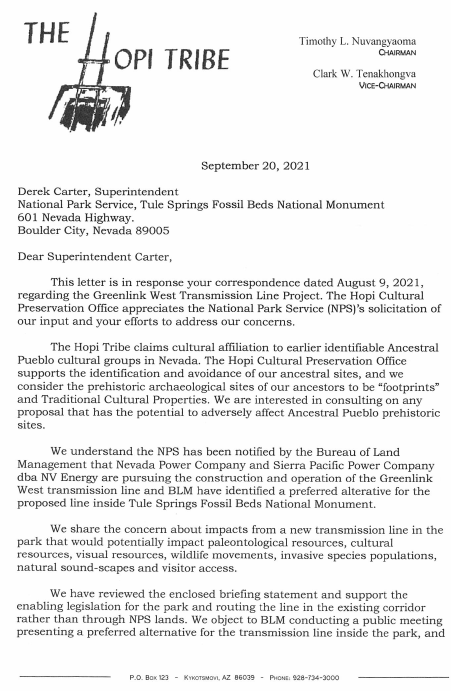Solar Project Applications Pour Into Nevada Outback
August 8, 2023 - Nevada - New large-scale solar project applications are hitting the Nevada Public Utility Commission, in anticipation of possible new high-voltage transmission lines: Greenlink West, Greenlink North, and now a Gridliance upgrade proposal. Agencies tell us these are not connected actions, but these solar applications would not exist were it not for the proposed Greenlink North and West Transmission Projects which seek to open up vast swaths of the Nevada public lands to energy development.
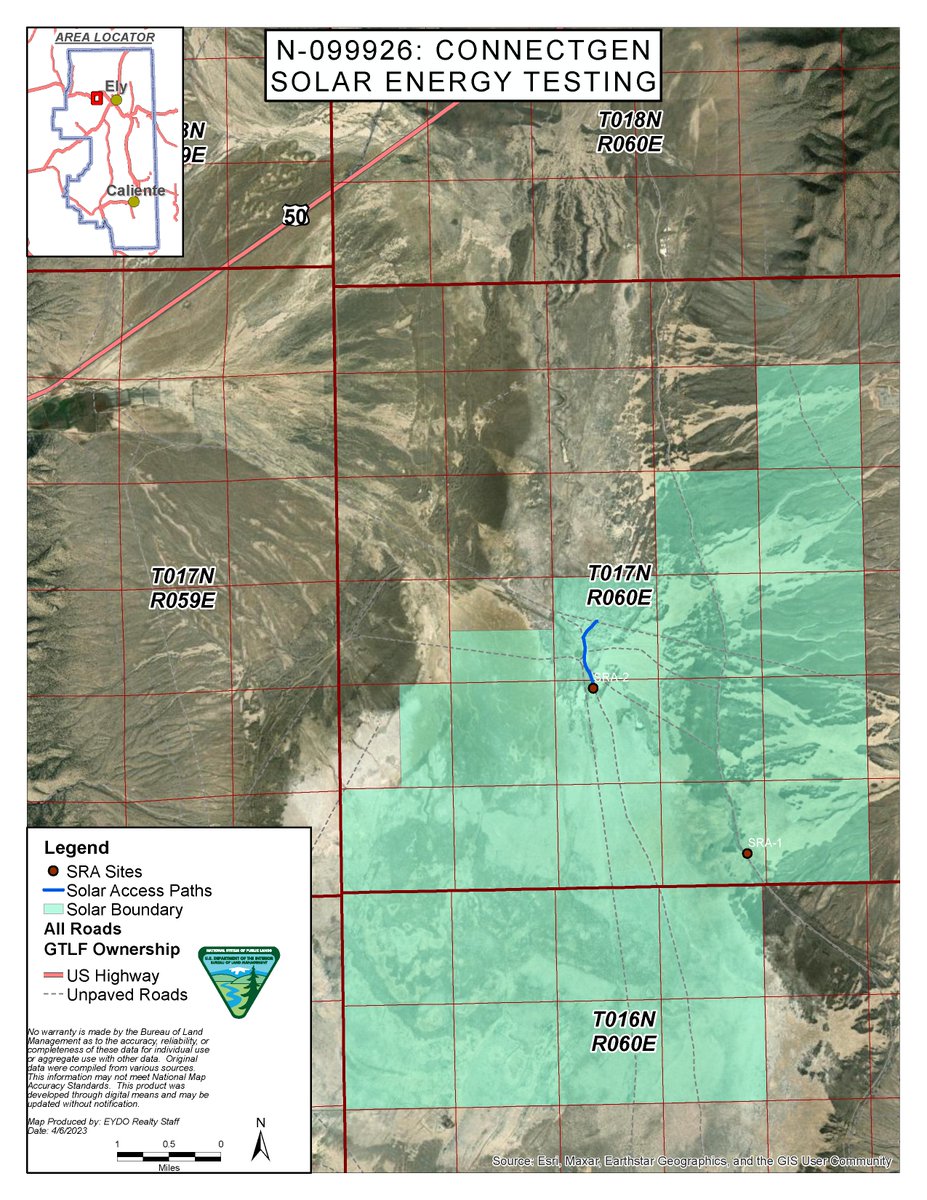
The Robinson Solar Project is a proposed 15,683-acre solar application in Jakes Valley, Nevada, 20 miles from Ely and located in sage grouse habitat - seeking to connect to the proposed Greenlink North Transmission Project. All habitat for the imperiled greater sage grouse is now apparently open to utility-scale solar projects.
https://pucweb1.state.nv.us/PDF/AxImages/DOCKETS_2020_THRU_PRESENT/2023-7/27934.pdf
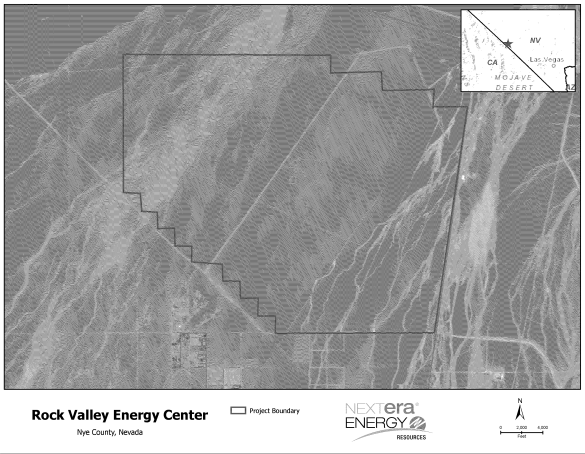
In Amargosa Valley, Rock Valley Solar Energy Center is proposed next to Lathrop Wells, Nevada about 7 miles from Ash Meadows National Wildlife Refuge and Devil's Hole. A project this size would need a one-time construction water use of over 2,000-acre feet. The project is proposed at 10,000 acres, and is on excellent creosote desert habitat with kit foxes and burrowing owls, as well as wildflower displays after rainy winters. Recreational routes cross this area.
In addition, as the above map shows, this project is sited poorly on top of the large acrive wash for the Forty Mile Canyon, which is basically an ephemeral fork of the Amargosa River. After massive and widespread rains in October of 2015, we saw this was flood with a very large amount of water, which flooded the town of Lathrop Wells, and sent a 500-foot-wide river of water into the mainstem of the Amargosa River down to Shoshone, CA, and beyond. We hope the project applicant and Bureau of Land Management seriously consider the surface hydrology in their environmental review.
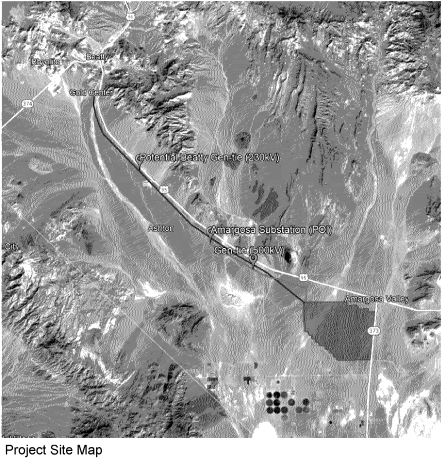
Proposed Greenlink Transmission Lines Would Industrialize Nevada’s Outback and Harm Wildlife
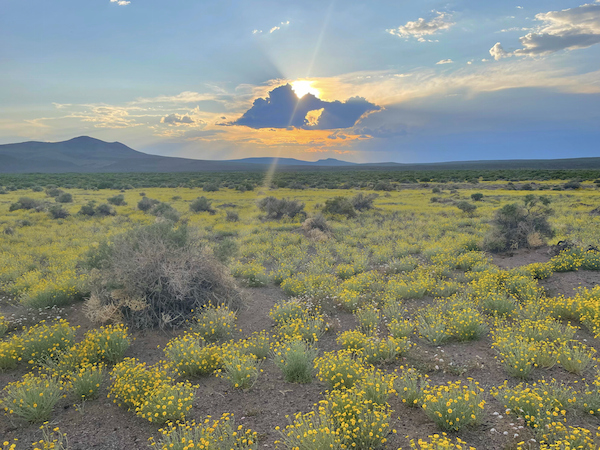
^The upper Amargosa River floodplain covered in woolly baileyas (Baileya pleniradiata) this May. The giant Greenlink West transmission project proposed to cross right about here.
May 30, 2023 - Reno, NV -- The Bureau of Land Management (BLM) has taken the next major step in the environmental review process to advance the construction of 707 miles of two gigantic high-voltage transmission lines in some of Nevada’s most remote, scenic, and biologically significant locations by issuing a Draft Environmental Impact Statement. The Greenlink lines are proposed to be built by the utility NV Energy and would be mostly 525-kilovolt transmission lines that would carry power generated from solar, wind, geothermal, biomass and possibly natural gas generation through wetlands, sage grouse habitat, lands with wilderness characteristics, desert tortoise habitat, pronghorn habitat, culturally significant lands, rare plant habitat, over Joshua tree forests and near tourism-based small communities.
“Both Greenlink projects would open up a Pandora’s Box of large-scale energy impacts in Nevada’s most isolated areas and intact landscapes. These projects would create unacceptable impacts to wildlife, rare plants, cultural resources, small communities, and visual landscapes,” said Kevin Emmerich, Co-founder of Basin and Range Watch. “Instead of celebrating Nevada’s natural and cultural resources and directing green energy to previously disturbed lands, politicians have chosen to industrialize the very landscape that makes our state unique.”
The 471-mile Greenlink West Project is now being reviewed with an Environmental Impact Statement with a 90-day public comment period. The transmission towers would be nearly 200 feet tall starting at the natural gas power plants at the Harry Allen Substation at Apex, near Las Vegas, cross remote areas of wildlife habitat in western Nevada, and finally ending up to mostly supply Lithium battery factories and tech industries in the Reno area. The Greenlink West Project would not only impact lands managed by the BLM, but also National Park Service lands, Tribal lands and reservations, and private lands.
“It would be impossible to avoid significant impacts to biological and cultural resources from these associated large-scale solar applications that need the transmission projects to access these remote lands,” said Laura Cunningham of Western Watersheds Project. “We could prevent these huge impacts by constructing solar in the built environment—on the abundant urban rooftops, over parking lots, on warehouses, and on already-disturbed lands.”
Greenlink West would impact Ice Age megafaunal fossils in 1½ miles of Tule Springs Fossil Beds
National Monument in southern Nevada, and run over populations of many rare plants,
including white-margined penstemon. The line would cut through Mojave desert tortoise and
bi-state sage grouse habitat—sage grouse could be impacted by collision hazards presented by
the giant new transmission project as well as habitat abandonment within 5 miles of the
powerline. The line is proposed to cross sensitive wetlands, endanger bald and golden eagle
populations, be built next to Walker Lake, impair the historic viewscape from Fort Churchill
State Park, and cross private land.
Greenlink West would build new substations in Amargosa Valley and Esmeralda County near
Tonopah, and there are approximately 250 square miles of large-scale solar applications
associated with the project so far.
“The massive cumulative impacts of constructing these long transmission lines on public lands
in the Silver State should not be ignored,” said Cunningham. “Instead of an expensive grid
project that will open up the most remote wildlands to energy development, better planning is
needed now that includes conservation.”
Greenlink North has begun a public scoping review and would be constructed on 235 miles of
BLM and Forest Service land along Highway 50, otherwise known as the “Loneliest Road in
America.”
“To many, this is one of the last great outback areas in Nevada,” Emmerich said. “The line
would run through important greater sage grouse habitat, endanger raptor species and create a
land rush for large-scale solar and wind energy in some of the last unspoiled areas in the West.”
Two substations would allow the development of several thousand acres in the remote areas of
Jake’s Valley near Ely and Big Smoky Valley near Austin. At this point, there are about 55,000
acres of large-scale solar applications associated with Greenlink North and 30,000 acres of wind
energy applications.
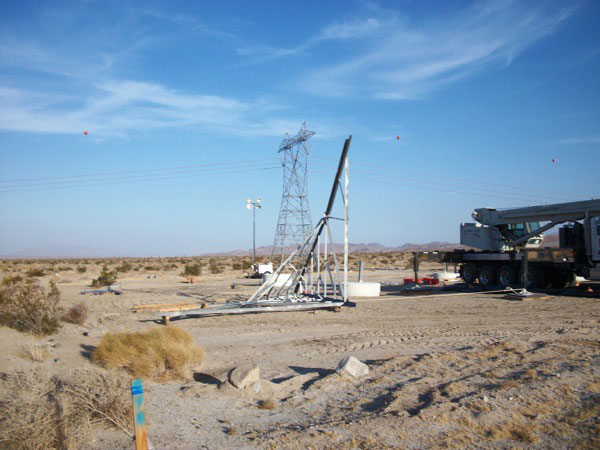
^Construction of Powerlink.
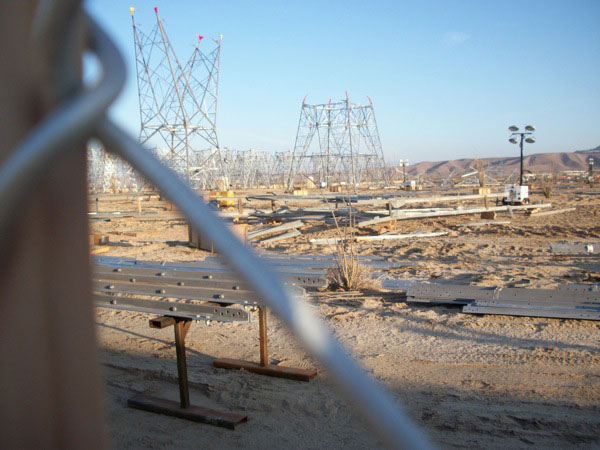
^Greenlink proposes to be a diggerent design than Powerlink was, but the disturbances to wildlands will be similar.
^Pronghorn antelope mother and young, in a wildflower fawning ground in Sarcobatus Flat, Nevada, that is directly in the path of the proposed Greenlink West. Photo: Kevin Emmerich.
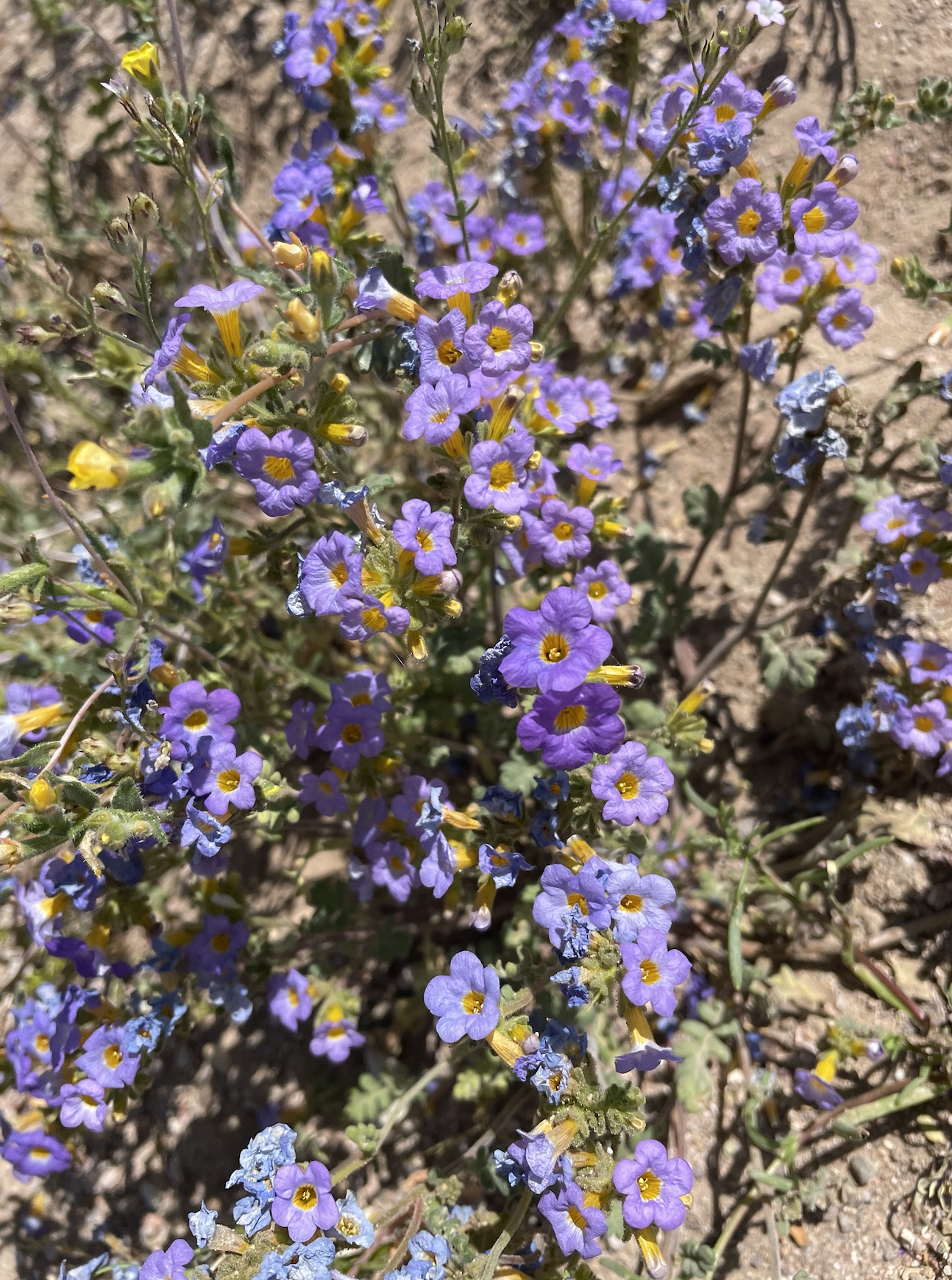
^Fremont phacelia (Phacelia fremontii) blooming in April-May in Amargosa Valley, Nevada.
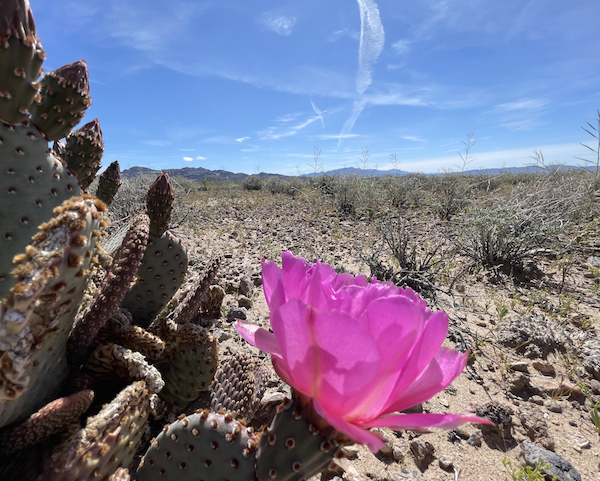
^Beavertail cactus (Opuntia basilaris) in bloom, Amargosa Valley, Nevada.
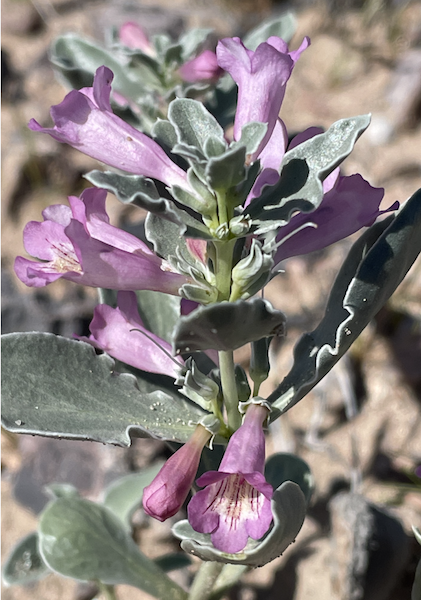
^Rare White margined penstemon (Penstemon albomarginatus) population in the path of the proposed Greenlink West.
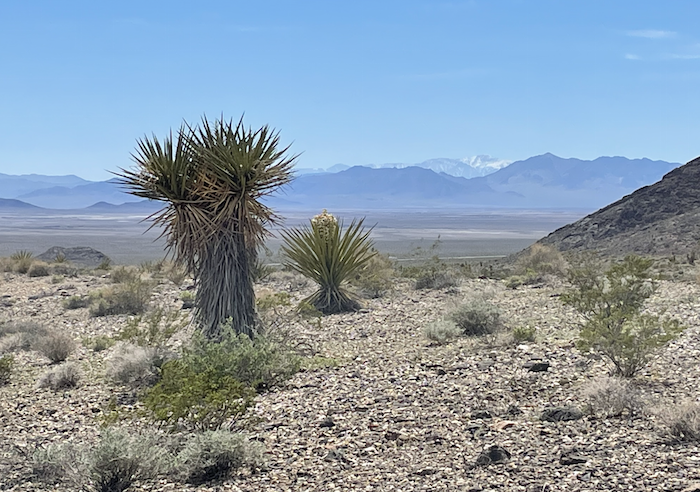
^View of Amargosa Valley with Mojave yuccas, looking westwards towards snowy Telescope Peak in Death Valley National Park, May 2023. This view would be ruined by Greenlink West and associated large-scale build-out of solar projects.
Draft Environmental Impact Statement for Greenlink West Transmission Project is Released for Public Comment
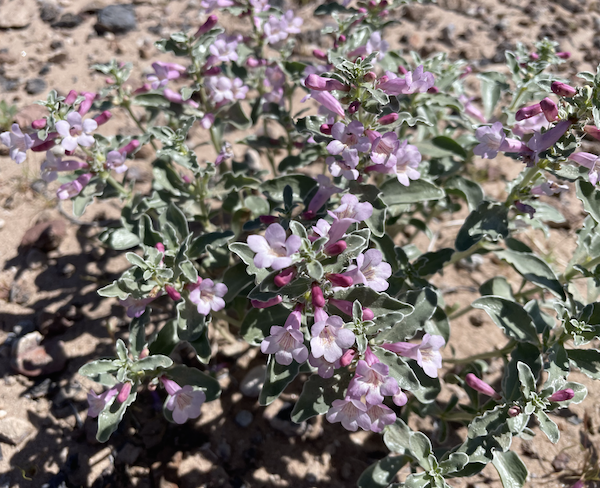
^The rare white-margined penstemon (Penstemon albomarginatus) has populations in sandy areas of the Amargosa valley, nevada, directly in the proposed path of the Greenlink West Transmission proposal. Will giant transmission destroy biodiversity in the Mojave Desert?
May 25, 2023 - Nevada - Today the Bureau of Land Management (BLM) released its Notice of Availability of the Draft Environmental Impact Statement (EIS) and Resource Management Plan Amendments for the Greenlink West Project in Clark, Esmeralda, Lyon, Mineral, Nye, Storey, and Washoe Counties, NV on the public inspection page (https://public-inspection.federalregister.gov/2023-11102.pdf) for hard release tomorrow on the Federal Register.
This notice announces the opening of a 90-day comment period for the Draft EIS. We have been preparing for this day, and we adamantly oppose this over-priced natural gas transmission line hooking into Las Vegas area Apex natural gas baseload power plants that will increase rate-payers' monthly bills all to serve mega-factories in the Reno-Sparks region, such as Tesla, Blockchain, and other energy-intensive California-transplant industries invading Nevada. "Green"link is not meant to help rural or native Nevadans lower their electrical bills, but instead boost profit of out-of-state Billionaires. This fossil-fuel high-voltage transmission boondoggle would cost Nevadans increased utility bills across the state. The cleverly named "green" in the project applications' name foold many people, but not us.
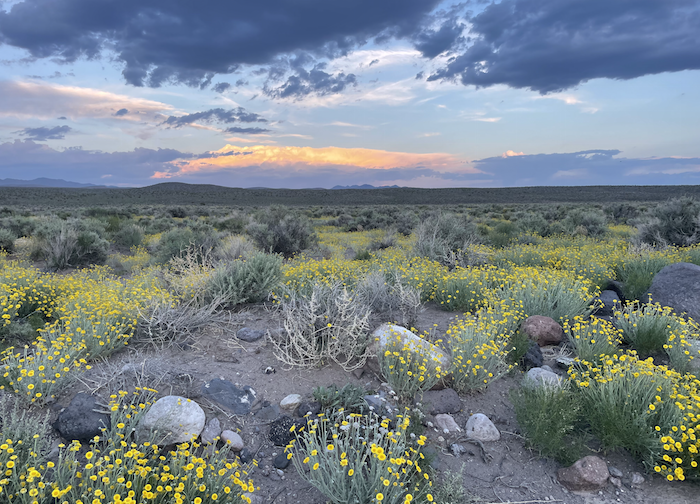
^Greenlink West high-voltage giant transmission project would cross remote and wild deserts in Nye County, Nevada, full of spring wildflowers--here woolly baileya (Baileya pleniradiata).
The BLM will be hosting both virtual and in-person public meetings during the 90-public comment period. The dates and locations of any public meetings will be announced at least 15 days in advance through local media, newspapers, and the BLM website at: https://eplanning.blm.gov/eplanning-ui/project/2017391/510.
ADDRESSES: You may submit comments related to the Greenlink West Project Draft EIS by any of the following methods:
ePlanning Website: https://eplanning.blm.gov/eplanning-ui/project/2017391/510
Email: BLM_NV_greenlinkwest@blm.gov
Mail: BLM Nevada State Office, Attn: Brian Buttazoni, Planning &
Environmental Specialist, Branch of Renewable Energy, BLM Nevada State
Office, 1340 Financial Boulevard, Reno, Nevada 89502
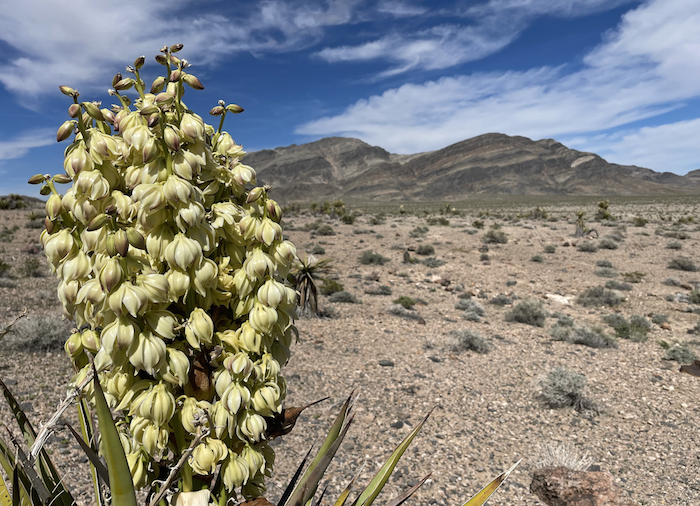
^Mojave yuccas burst into full bloom this spring--Amargosa Valley by the limestone Specter Range. This is directly in the path of the proposed fossil-fuel Greenlink West Transmission Project. The spring of 2023 was epic in Amargosa Valley, Nevada. We had huge rains all winter, and the wildflower display lasted months. We found wildflowers blooming that we had not seen in 20 years of living here. Stay tuned for more photos and reporting on this amazing display.
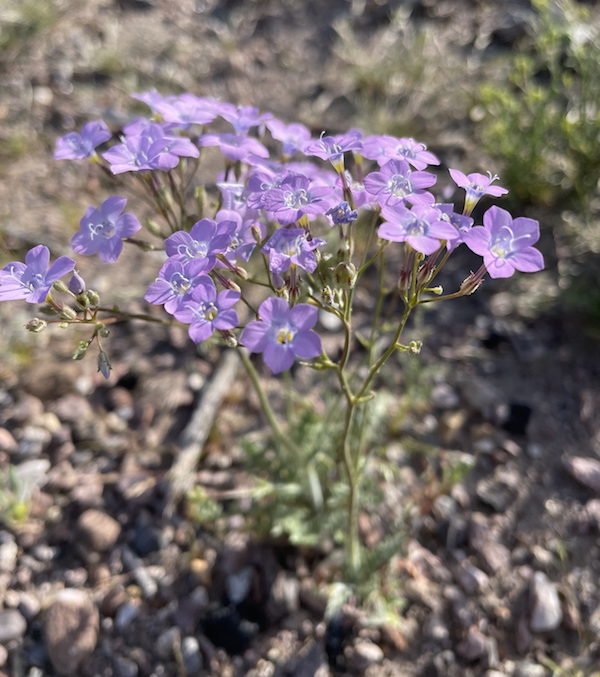
^Showy gilia (Gilia cana) was abundant and widespread in Amargosa Valley, Nevada, this spring.
FOR FURTHER INFORMATION CONTACT: Brian Buttazoni, Planning & Environmental Specialist, telephone (775) 861-6491; address: 1340 Financial Boulevard, Reno, NV 89502; email: blm_nv_greenlinkwest@blm.gov. Individuals in the United States who are deaf, deafblind, hard of hearing, or have a speech disability may dial 711 (TTY, TDD, or TeleBraille) to access telecommunications relay services. Individuals outside the United States should use the relay services offered within their country to make international calls to the point-of-contact in the United States.
SUPPLEMENTARY INFORMATION: On July 22, 2020, Nevada Power Company and Sierra Pacific Power Company dba NV Energy (NV Energy or Proponent) filed an Application for Transportation, Utility Systems, Telecommunications, and Facilities on Federal Lands and Property (Standard Form 299) and a preliminary Plan of Development with the BLM Nevada State Office for a FLPMA Right-of-Way and Short-Term Right- of-Way authorization for the Greenlink West Project (NVN-99863 and NVN-99863-01).
The Draft EIS/RMPA analyzes the environmental impacts of the authorization of a 200-foot-wide right-of-way (ROW) by the BLM for the construction, operations, and decommissioning of the 525- kV line, a 160-foot-wide ROW for the 345-kV lines, and a 600-foot short-term ROW for construction and staging to NV Energy for a 474-mile system of new 525-kilovolt (kV), 345-kV, and 120-kV overhead electric transmission lines. The proposal also includes transmission and distribution lines, substations, microwave radio facilities, amplifier sites, access roads, and construction/material yards. The Draft EIS/RMPA analyzes the impacts of potential RMP amendments together with the impacts of the various alternative routes.
A Notice of Intent to Prepare an EIS for the Greenlink West Project published in the Federal Register on May 2, 2022 (87 FR 25658), providing notice to the public of potential amendments to RMPs, as required by 43 CFR 1610.2(c). The public scoping period closed on June 1, 2022. The BLM held four public scoping meetings and received approximately 81 public scoping comment letters during the 30-day scoping period. The scoping comments focused on biological resources, alternatives development, visual resources, cultural resources, impacts to general and special-status wildlife species, including threatened and endangered species and their habitat, social and economic conditions, vegetation/riparian/noxious and invasive weeds/special status plant species, including threatened and endangered species and their habitat, water resources, wilderness, wilderness study areas, lands with wilderness characteristics, special designations, recreation, socioeconomic concerns, and Native American cultural/sacred sites. The BLM prepared a scoping report, which is available on the project’s ePlanning website - https://eplanning.blm.gov/eplanning-ui/project/2017391/510.
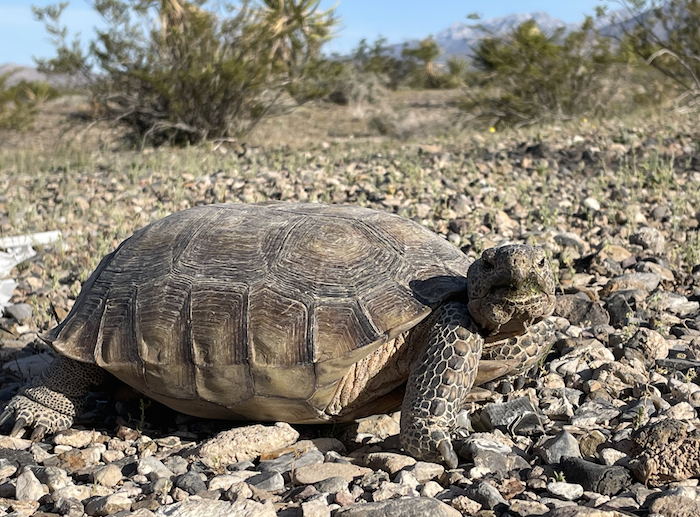
^An adult female Mojave desert tortoise feeds on wildflowers in Clark County, Nevada, on the site of the proposed Bonanza Solar Project along the route of the proposed Greenlink West Transmission Project in remote deserts on the east side of the Spring Range. These old-growth desert intact ecosystems should not be sacrificed for renewable energy development that can easily go into urban built enviromnets.
"Mitigation"
The BLM added an anti-perching/nesting mitigation measure to the Proposed Action to reduce the potential for raven predation on Bi-State sage-grouse and the Mohave desert tortoise through installation of tubular (no-lattice) transmission structures (e.g., tubular H-frame, three-pole dead end, or monopole structures). Perch and nest deterrent devices would also be installed on all transmission and distribution structures within Mojave desert tortoise recovery units and within two miles of Bi-State sage-grouse Priority Areas for Conservation.
Stay tuned for much more on this terrible proposal that could be replaced with a distributed alternative using rooftop and parking lot solar panels and local microgrids. Even better, home-owners and propert-owners could be PAID to generate solar energy from their own local solar panel arrays connected to a public grid that would pay to support local benefits and conserve Carbon-sequestering public lands and ecosystems. We will have much more to say about this better alternative.
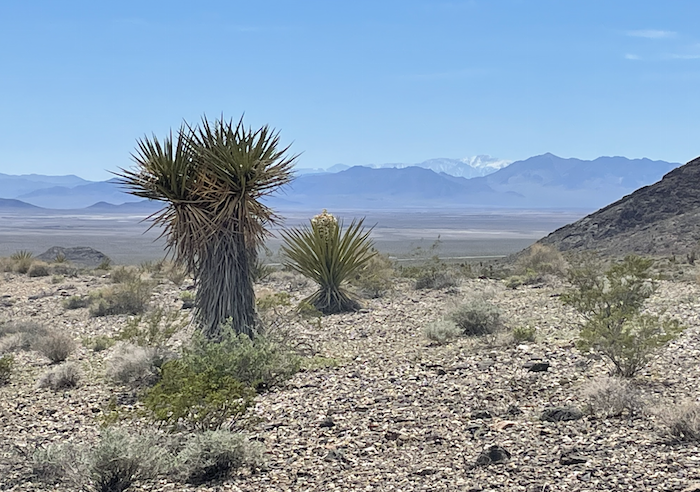
^View of Amargosa Valley, Nevada, with Mojave yuccas in view of the proposed path of the ill-conceived Greenlink West Transmission proposal, looking towards the snowy Telescope Peak in Death Valley National Park. April 2023 during a cold spring.
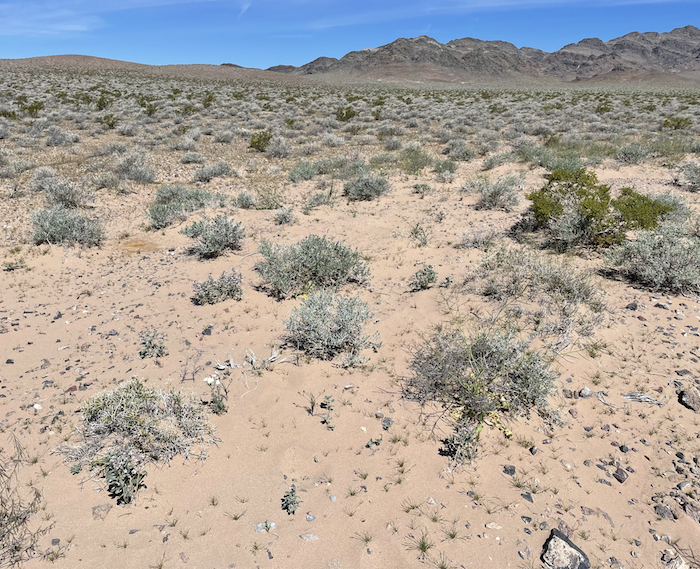
^Sandy habitat in Amargosa Valley with white-margined penstemon plants. The proposed Greenlink would slash right through this population.
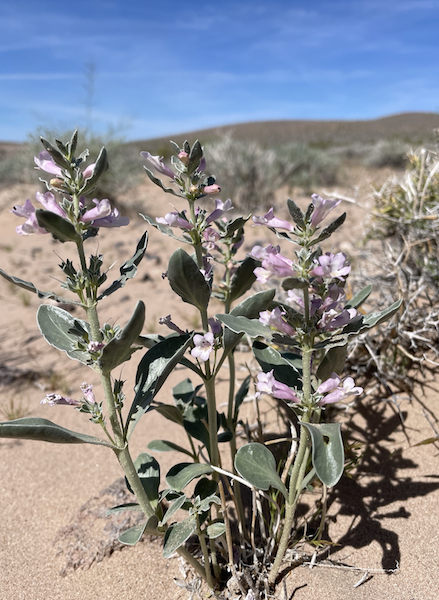
^White-margined penstemon, a rare plant.
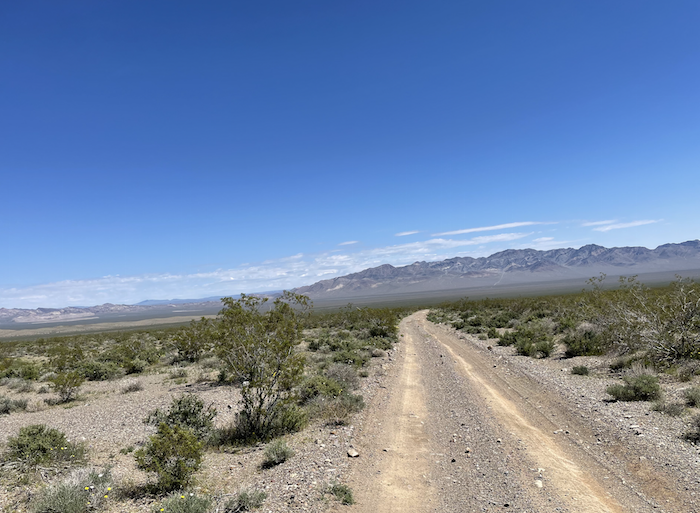
^Recreational 4x4 route to Chloride Cliffs through public lands in northern Amargosa Valley near Beatty, Nevada. The proposed Greenlink West Transmission Project would open up this entire landscape to utility-scale solar projects on tens of thousands of acres which would ruin this view. A solar application would cover this photo with industrial energy development. We oppose this.
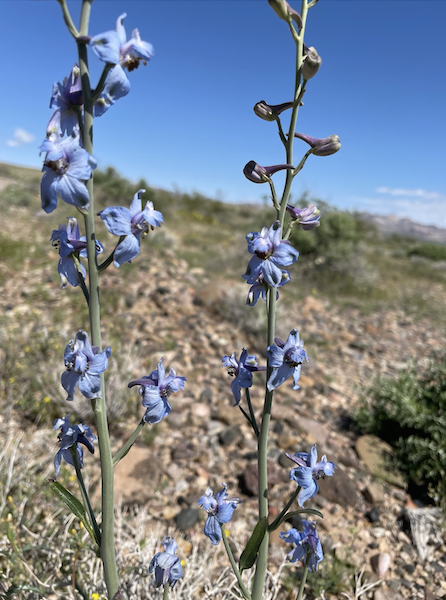
^This spring in Amargosa Valley, Nevada, the desert larkspur (Delphinium parishii) was more abundant than we have ever seen it due to the cool rainy winter and spring locally. Fields of sky-blue larkspur covered valleys and hill slopes and our cameras could not capture the beauty of this desert come alive with above-average rains.
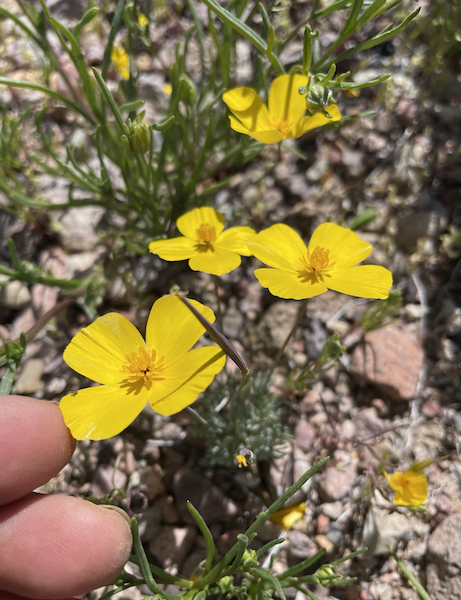
^Desert gold poppy (Eschscholzia glyptosperma) in Amargosa Valley, Nevada, in the path of the ugly transmission proposal.
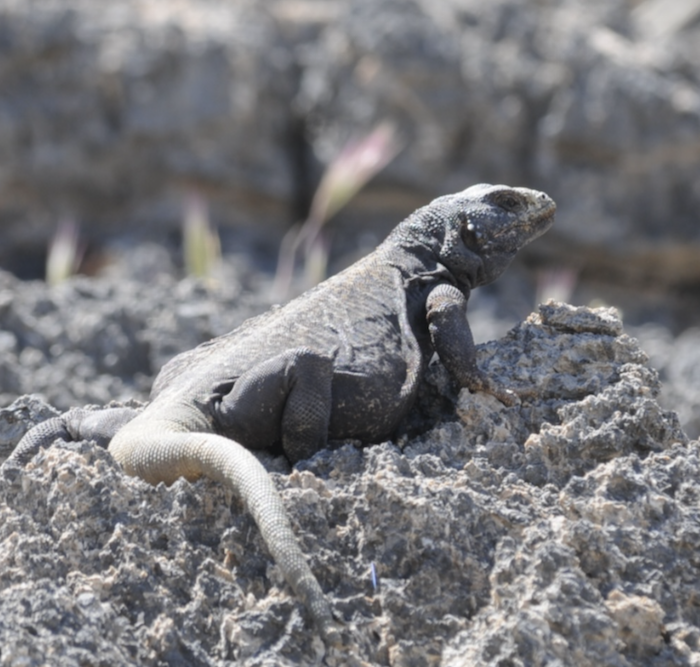
^Chuckwalla (Sauromalus ater) in limestone hills directly in the path of the proposed transmission project slashing through desert ecosystems.
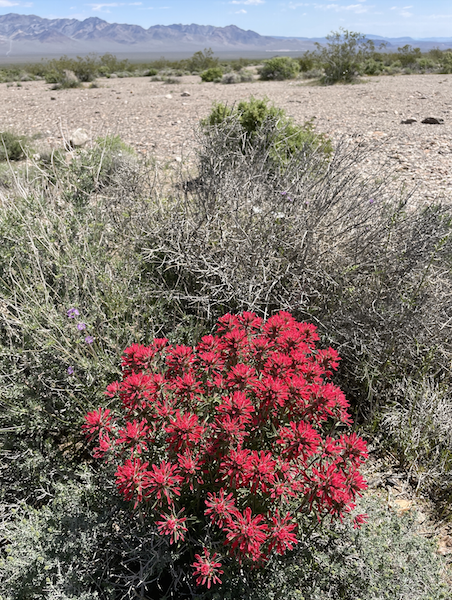
^Paintbrush (Castilleja chromosa) in Amargosa Valley, during the wonderful wildflower bloom of 2023.
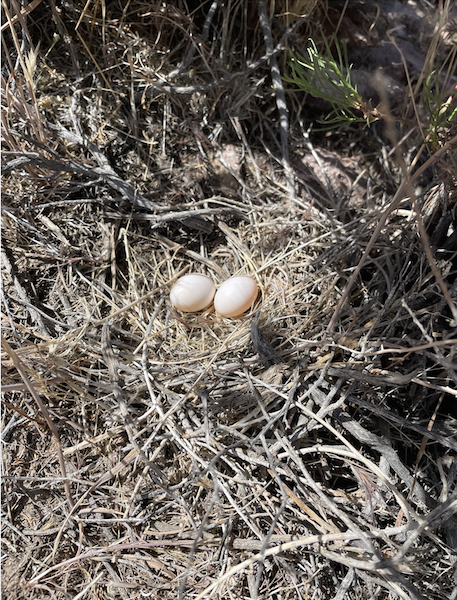
^We found the mourning dove nest with eggs under a bush on the ground, in the path of the proposed Greenlink mess. We took a quick photo and moved away so that the dove could return to her nest.
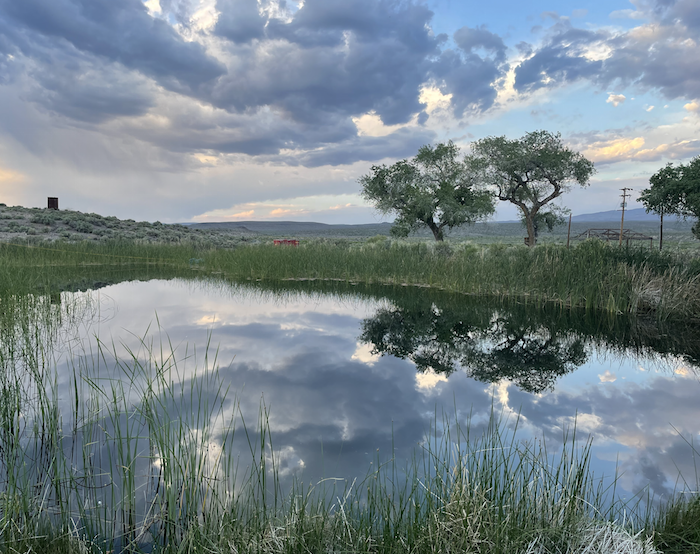
^Important wetlands and ponds are directly in the path of the proposed Greenlink West Transmission Project. We oppose this project and as a reasonable alternative we embrace democratic Distrubuted Renewable Energy projects that benefit everyone in the built enviromnemt, while conserving these remote biodivervse natural lands and waters.
Draft Environmental Impact Statement for Greenlink West Transmission Project is Released for Public Comment
May 25, 2023 - Nevada - Today the Bureau of Land Management released its Notice of Availability of the Draft Environmental Impact Statement (EIS) and Resource Management Plan Amendments for the Greenlink West Project in Clark, Esmeralda, Lyon, Mineral, Nye, Storey, and Washoe Counties, NV on the public inspection page (https://public-inspection.federalregister.gov/2023-11102.pdf) for hard release tomorrow on the Federal Register.
This notice announces the opening of a 90-day comment period for the Draft EIS. We have been preparing for this. Stay tuned for more information and on-the-ground reporting.
The BLM will be hosting both virtual and in-person public meetings during the 90-public comment period. The dates and locations of any public meetings will be announced at least 15 days in advance through local media, newspapers, and the BLM website at: https://eplanning.blm.gov/eplanning-ui/project/2017391/510.
ADDRESSES: You may submit comments related to the Greenlink West Project Draft EIS by any of the following methods:
ePlanning Website: https://eplanning.blm.gov/eplanning-ui/project/2017391/510
Email: BLM_NV_greenlinkwest@blm.gov
Mail: BLM Nevada State Office, Attn: Brian Buttazoni, Planning &
Environmental Specialist, Branch of Renewable Energy, BLM Nevada State
Office, 1340 Financial Boulevard, Reno, Nevada 89502
FOR FURTHER INFORMATION CONTACT: Brian Buttazoni, Planning & Environmental Specialist, telephone (775) 861-6491; address: 1340 Financial Boulevard, Reno, NV 89502; email: blm_nv_greenlinkwest@blm.gov. Individuals in the United States who are deaf, deafblind, hard of hearing, or have a speech disability may dial 711 (TTY, TDD, or TeleBraille) to access telecommunications relay services. Individuals outside the United States should use the relay services offered within their country to make international calls to the point-of-contact in the United States. SUPPLEMENTARY INFORMATION: On July 22, 2020, Nevada Power Company and Sierra Pacific Power Company dba NV Energy (NV Energy or Proponent) filed an Application for Transportation, Utility Systems, Telecommunications, and Facilities on Federal Lands and Property (Standard Form 299) and a preliminary Plan of Development with the BLM Nevada State Office for a FLPMA Right-of-Way and Short-Term Right- of-Way authorization for the Greenlink West Project (NVN-99863 and NVN-99863-01).
The Draft EIS/RMPA analyzes the environmental impacts of the authorization of a 200-foot-wide right-of-way (ROW) by the BLM for the construction, operations, and
decommissioning of the 525- kV line, a 160-foot-wide ROW for the 345-kV lines, and a 600-foot short-term ROW for construction and staging to NV Energy for a 474-mile system of new 525-kilovolt (kV), 345-kV, and 120-kV overhead electric transmission lines. The proposal also includes transmission and distribution lines, substations, microwave radio facilities, amplifier sites, access roads, and construction/material yards. The Draft EIS/RMPA analyzes the impacts of potential RMP amendments together with the impacts of the various alternative routes.
A Notice of Intent to Prepare an EIS for the Greenlink West Project published in the Federal Register on May 2, 2022 (87 FR 25658), providing notice to the public of potential amendments to RMPs, as required by 43 CFR 1610.2(c). The public scoping period closed on June 1, 2022. The BLM held four public scoping meetings and received approximately 81 public scoping comment letters during the 30-day scoping period. The scoping comments focused on biological resources, alternatives development, visual resources, cultural resources, impacts to general and special-status wildlife species, including threatened and endangered species and their habitat, social and economic conditions, vegetation/riparian/noxious and invasive weeds/special status plant species, including threatened and endangered species and their habitat, water resources, wilderness, wilderness study areas, lands with wilderness characteristics, special designations, recreation, socioeconomic concerns, and Native American cultural/sacred sites. The BLM prepared a scoping report, which is available on the project’s ePlanning website - https://eplanning.blm.gov/eplanning-ui/project/2017391/510.
Mitigation
The BLM added an anti-perching/nesting mitigation measure to the Proposed Action to reduce the potential for raven predation on Bi-State sage-grouse and the Mohave desert tortoise through installation of tubular (no-lattice) transmission structures (e.g., tubular H-frame, three-pole dead end, or monopole structures). Perch and nest deterrent devices would also be installed on all transmission and distribution structures within Mojave desert tortoise recovery units and within two miles of Bi-State sage-grouse Priority Areas for Conservation.
Tule Springs Fossil Beds National Monument Paleontological Resources May Block Controversial Greenlink West Transmission Project
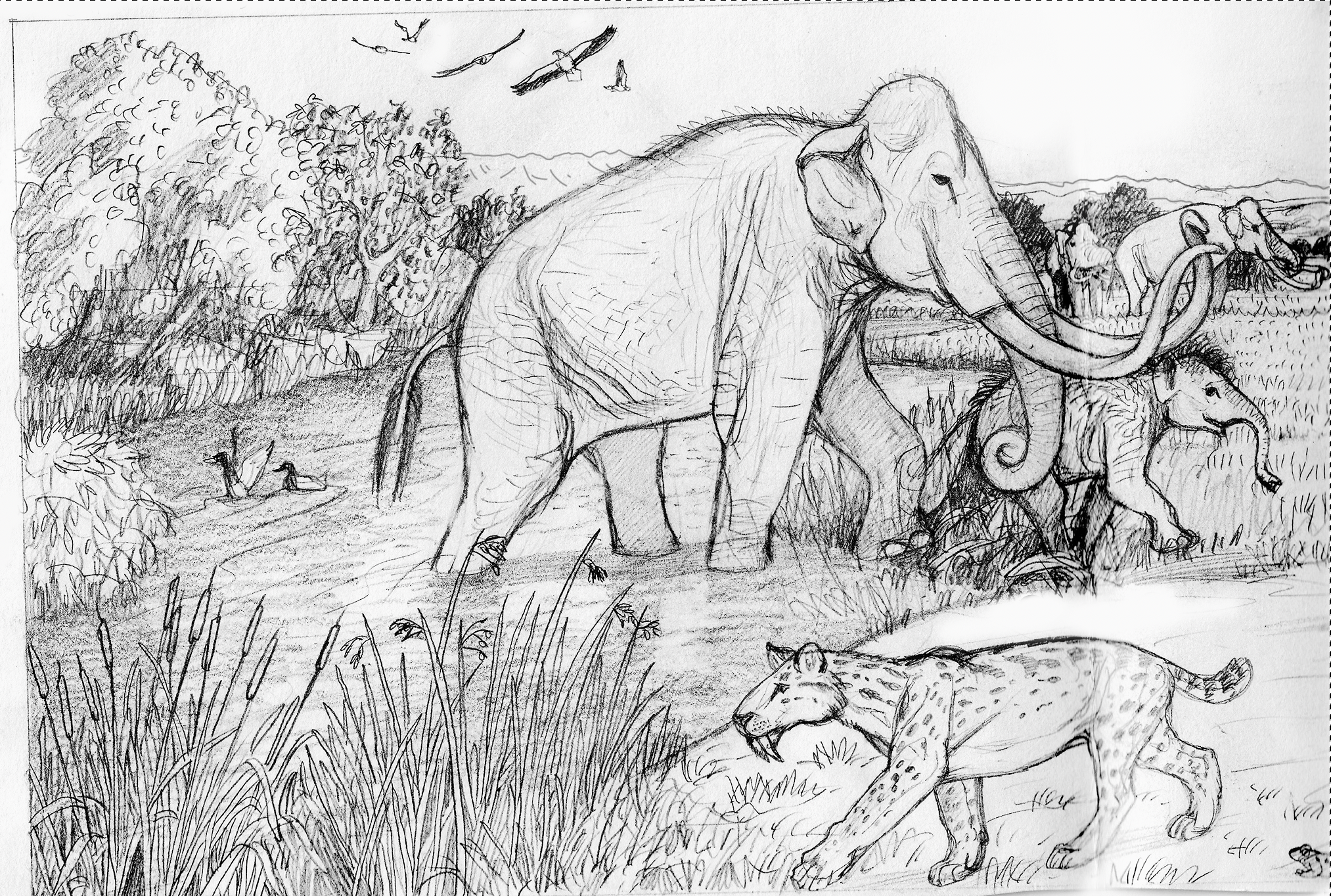
^Columbian mammoths and sabertooth cat in spring wetlands at Tule Springs Fossil Beds National Monument, Nevada, Pleistocene. Drawing by Laura Cunningham, Copyright 2023.
March 8, 2023 - Las Vegas, NV - From Public Employees for Environmental Responsibility (PEER), with help from Basin and Range Watch:
 FOR IMMEDIATE RELEASE: Wednesday, February 15, 2023
FOR IMMEDIATE RELEASE: Wednesday, February 15, 2023
Contact: Jeff Ruch; Chandra Rosenthal
National Park Fossils May Block Big Transmission Line
Tule Springs Paleo Survey Results Complicate Controversial Greenlink Route
Plans for a mega-transmission corridor in Nevada have hit a roadblock in the form of a survey showing that its route through a national park would likely destroy a trove of prehistoric fossils, according to the results of a ground-penetrating survey released today Public Employees for Environmental Responsibility (PEER). The survey of Tule Springs Fossil Beds National Monument found the strong likelihood of “vertebrate skeletal elements” in areas along the proposed right-of-way for the planned “Greenlink West” high-voltage system to transmit power from Las Vegas to Reno.
When Congress created the Tule Springs Fossil Beds National Monument in 2014 near Las Vegas to protect invaluable Ice Age paleontological discoveries, it also authorized a nearby electric transmission corridor (now called Greenlink) to carry “primarily… renewable energy resources.” In the intervening years, two things changed: 1) the Greenlink line corridor will serve natural gas facilities; and 2) it has been rerouted to cross the Monument.
Besides the utility that would build the lines (NV Energy), the right-of-way through federal lands is being pushed by the U.S. Bureau of Land Management (BLM) and its parent agency, the Department of Interior, which also oversees the National Park Service (NPS).
In comments filed last year with BLM, the NPS warned about the adverse impact on Tule Springs fossils:
“The proposed alignment of the Greenlink West Project would pass through fossiliferous deposits in the park as well as east and west of the park. These deposits contain known fossil sites …The construction of the transmission line…will have the potential to impact paleontological resources, including an undetermined number of fossil remains and unrecorded fossil sites… making those sediments and their paleontological resources unavailable for future scientific investigation.”
That protest led to the funding of a ground-penetrating survey to assess potential damage. Those survey results, released to PEER under the Freedom of Information Act, appear to confirm those fears, with findings that areas surveyed –
“…detected anomalies exhibited forms highly suggestive of vertebrate skeletal elements. Barring alternative explanations for these anomalies, the most reasonable explanation is that they are likely caused by the presence of fossils.”
“Less than a decade after Congress created this small monument to preserve prehistoric fossils, it is already under threat of destruction,” stated Rocky Mountain PEER Director Chandra Rosenthal, noting the survey also found “visible mammoth tusks” at one location. “It is beyond ironic that this fossil fuel project will entail the destruction of fossils.”
These survey results present major legal problems for the proposed Greenlink West corridor. The Park Service’s own Organic Act forbids impairment of park resources – and in this case the resource under threat is the one this park was created to protect. In addition, the Paleontological Resources Preservation Act generally forbids the destruction of fossils on federal lands.
“These legal barriers cannot be finessed,” added Pacific PEER Director Jeff Ruch, an attorney who has worked on these issues for more than 30 years, noting that the BLM has yet to release its draft Environmental Impact Report on the Greenlink project. “If BLM persist with its current corridor route, it will be tied up in litigation for years to come.”
###
View 2014 legislation establishing Tule Springs Fossil Beds National Monument
Enabling Legislation - Tule Springs Fossil Beds National Monument (U.S. National Park Service) (nps.gov)
Find out more about the Greenlink project
Greenlink West and Greenlink North | Bureau of Land Management (blm.gov)
Look at the Paleontological Resources Preservation Act
Paleontological Resources Preservation Act.pdf (blm.gov)
Comment Letter by the Hopi Tribe on the Greenlink West Transmission Proposal
May 22, 2022 - Las Vegas NV - We obtained from the National Park Service this public comment from the Hopi Tribe (pdf) describing their concerns with the Greenlink West Transmission Project.
May 2022 Scoping Meetings
May 15, 2022 - Las Vegas NV - See the Bureau of Land Management's Greenlink West Transmission proposal meeting schedule here: https://www.blm.gov/sites/blm.gov/files/docs/2022-05/GLWP_Public_Scoping_Meetings_220502.pdf
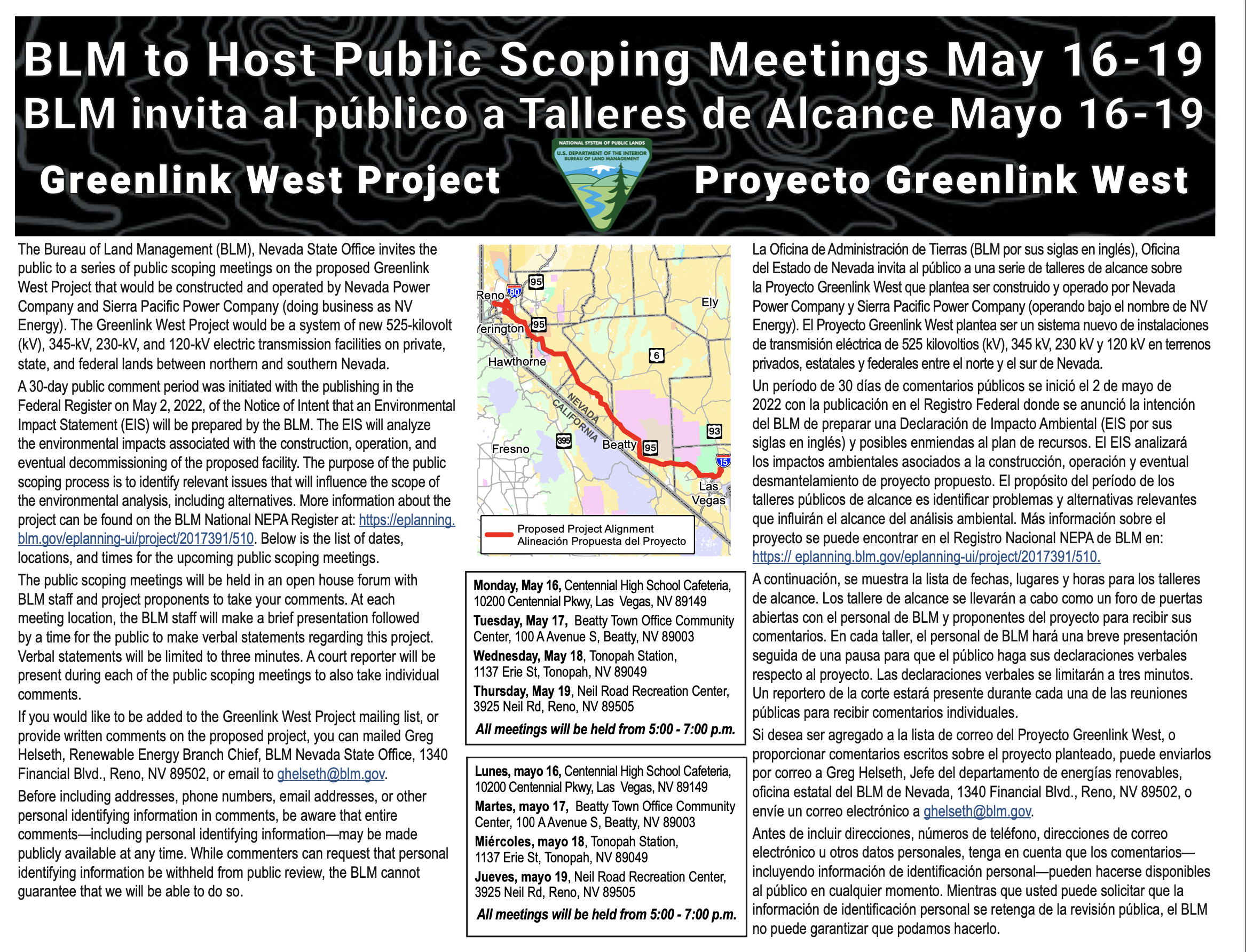
Greenlink West Transmission Project Review Starts May 2
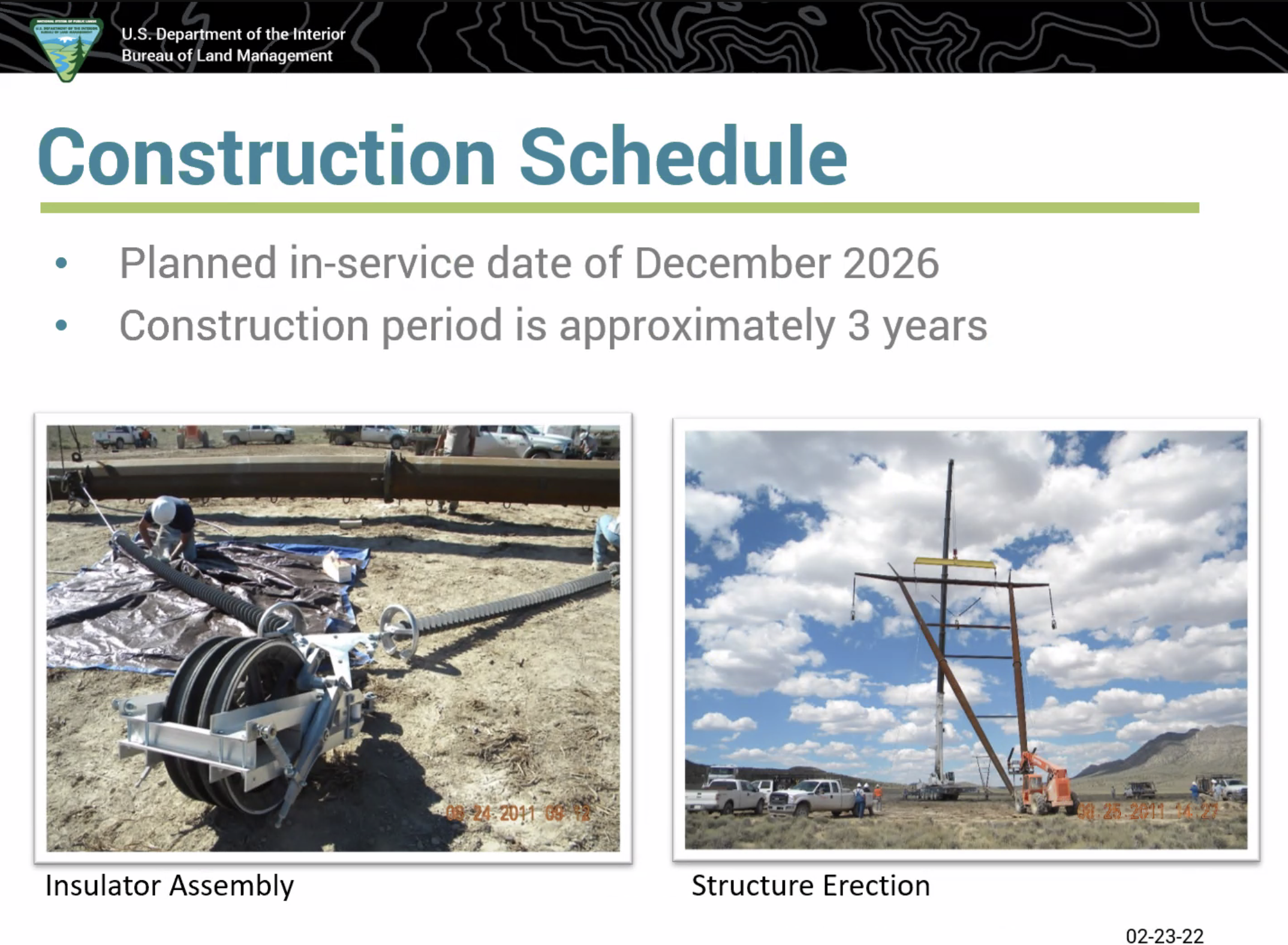
April 29, 2022 - Nevada - This proposed long high-voltage transmission project would open up all of western Nevada to renewable energy development, in some of the most remote basins and ranges. There are already 230 square miles of solar applications that we have tallied and investigated.
https://public-inspection.federalregister.gov/2022-09373.pdf
We will share talking points for you to write your own letter for the 30-day scoping period for public comments.
Greenlink West Transmission Line Project Scoping for Envirommental Impact Statement deadline May 30 for public comments >>BLM
The Bureau of Land Management (BLM) Nevada State Office (NVSO) intends to prepare an Environmental Impact Statement (EIS) and potential associated Amendments to the 2001 Carson City Consolidated Resource Management Plan (RMP).
From the Federal Register notice:
The Bureau of Land Management (BLM) Nevada State Office (NVSO) intends to prepare an Environmental Impact Statement (EIS) and potential associated Amendments to the 2001 Carson City Consolidated Resource Management Plan (RMP), 1998 Las Vegas Field Office RMP, and the 1997 Tonopah RMP for the proposed electrical transmission facilities referred to as the Greenlink West Project. Nevada Power Company and Sierra Pacific Power Company, doing business as NV Energy (Proponent), are proposing to build the Greenlink West Project in Clark, Nye, Esmeralda, Mineral, Lyon, Storey, and Washoe counties in Nevada.
-
The Greenlink West Project, as proposed, is an approximately 474-mile system of new 525-kilovolt (kV) and 345-kV overhead electric transmission lines and includes transmission and distribution lines, substations, microwave radio facilities, amplifier sites, access roads, and construction/material yards. In the application to the BLM, NV Energy has applied for a 600-foot-wide temporary right-of-way (ROW) for construction and a 200-foot-wide permanent ROW for operations and maintenance of the 525-kV line and a 160-foot-wide permanent ROW for the 345-kV lines.
The proposed transmission facilities would include approximately 13,767 acres land of which approximately 10,438 acres are public lands administered by the BLM. The remaining lands in the project area are managed by the Bureau of Indian Affairs, Clark County, Department of Defense, Department of Energy, National Park Service, Nevada Division of State Lands, U.S. Fish and Wildlife Service, U.S. Forest Service, and private landowners.
The power would not help rural Nevada, but go to tech companies and warehouses, servers in Reno/Sparks, as the Federal Register notice admits:
The power demand in northern Nevada is forecast to increase by more than 700 MW within 10 years. New transmission infrastructures are required to deliver the anticipated electric power demand.
The BLM also requests assistance with identifying potential alternatives to the Proposed Action. As alternatives should resolve a problem with the Proposed Action, please indicate the purpose of the suggested alternative. In addition, the BLM requests the identification of potential impacts that should be analyzed. Impacts should be a result of the action; therefore, please identify the activity along with the potential impact. Information that reviewers have that would assist in the development of alternatives or analysis of resources issues is also helpful.
-
Any plan amendments will be completed in compliance with FLPMA, NEPA, and all other relevant Federal laws, executive orders, and BLM polices.
-
Actions not relevant to the Greenlink West Project include considerations of Areas of Critical Environmental Concern for nomination or recommendations. Permanent closure of public land to hunting, fishing, or recreational shooting are also not proposed as part of the Greenlink West Project and therefore a shooting “notice of intent” is not applicable under this Notice.
COMMENTS:
You may submit comments or resource information related to the project by any of the following methods:
-
Website: https://eplanning.blm.gov/eplanning-ui/project/2017391/510
-
Mail: Gregory L. Helseth, Branch Chief Renewable Energy, BLM Nevada State Office, Greenlink West Project, 1340 Financial Blvd., Reno, NV 89520
-
For further information and/or to have your name added to our mailing list, please contact Rita Henderson, Public Affairs Specialist, BLM Nevada State Office, 1340 Financial Boulevard, Reno, NV 89520; phone (775) 461-6753; or email ritahenderson@blm.gov.
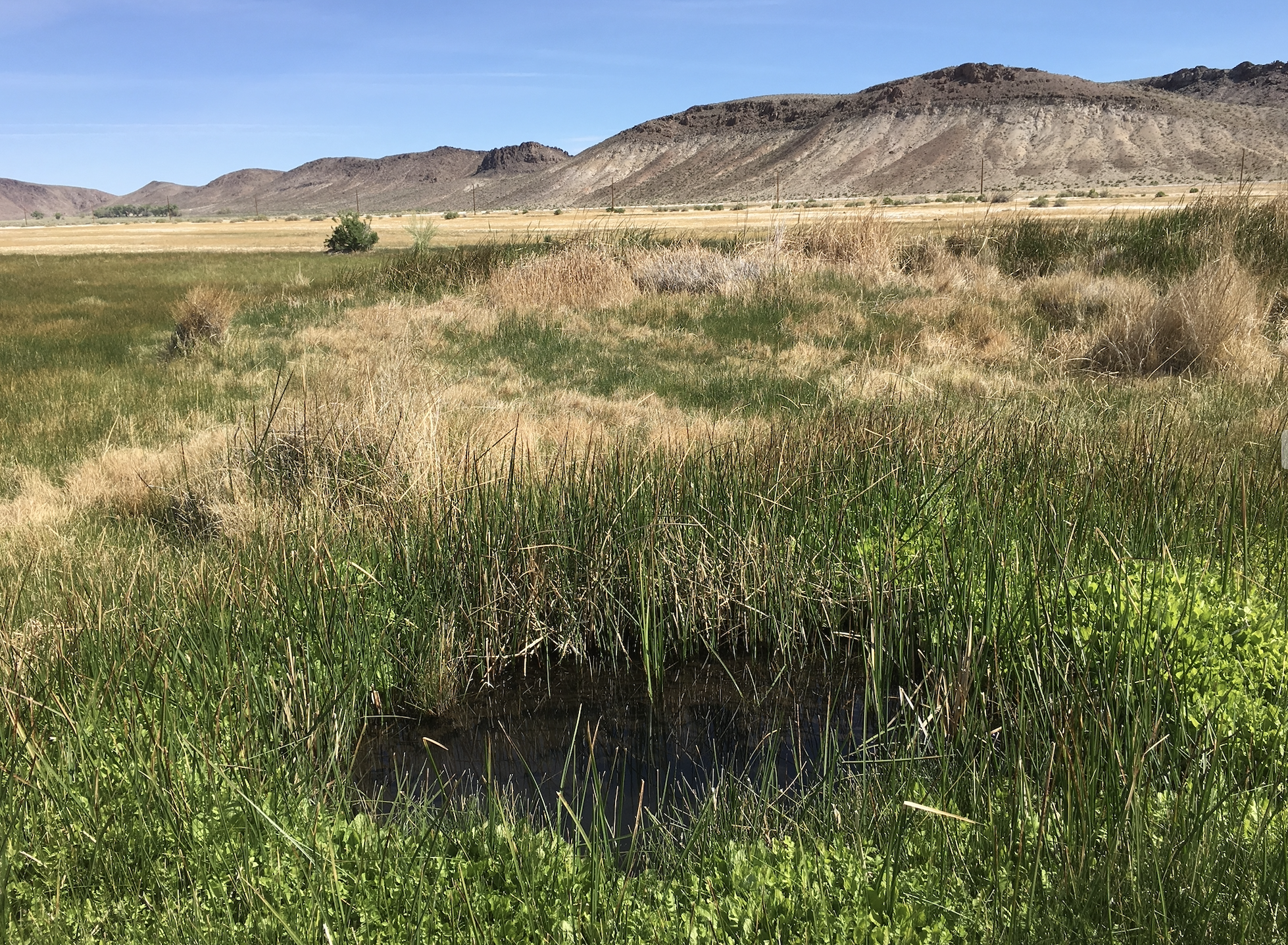
^Alternative K proposed recently (see map below) would cross over and run along Oasis Valley, Nevada, a rich wetland and riparian area bubbling with springs that form the headwaters of the Amargosa Valley. This is unacceptable.
-
February 2022 Zoom Presentation
February 24, 2022 - Reno, NV - Greg Helseth, Renewable Energy Coordinator for Bureau of Land Management (BLM) hosts this Zoom presentation on the proposed Greenlink West Transmission Project.
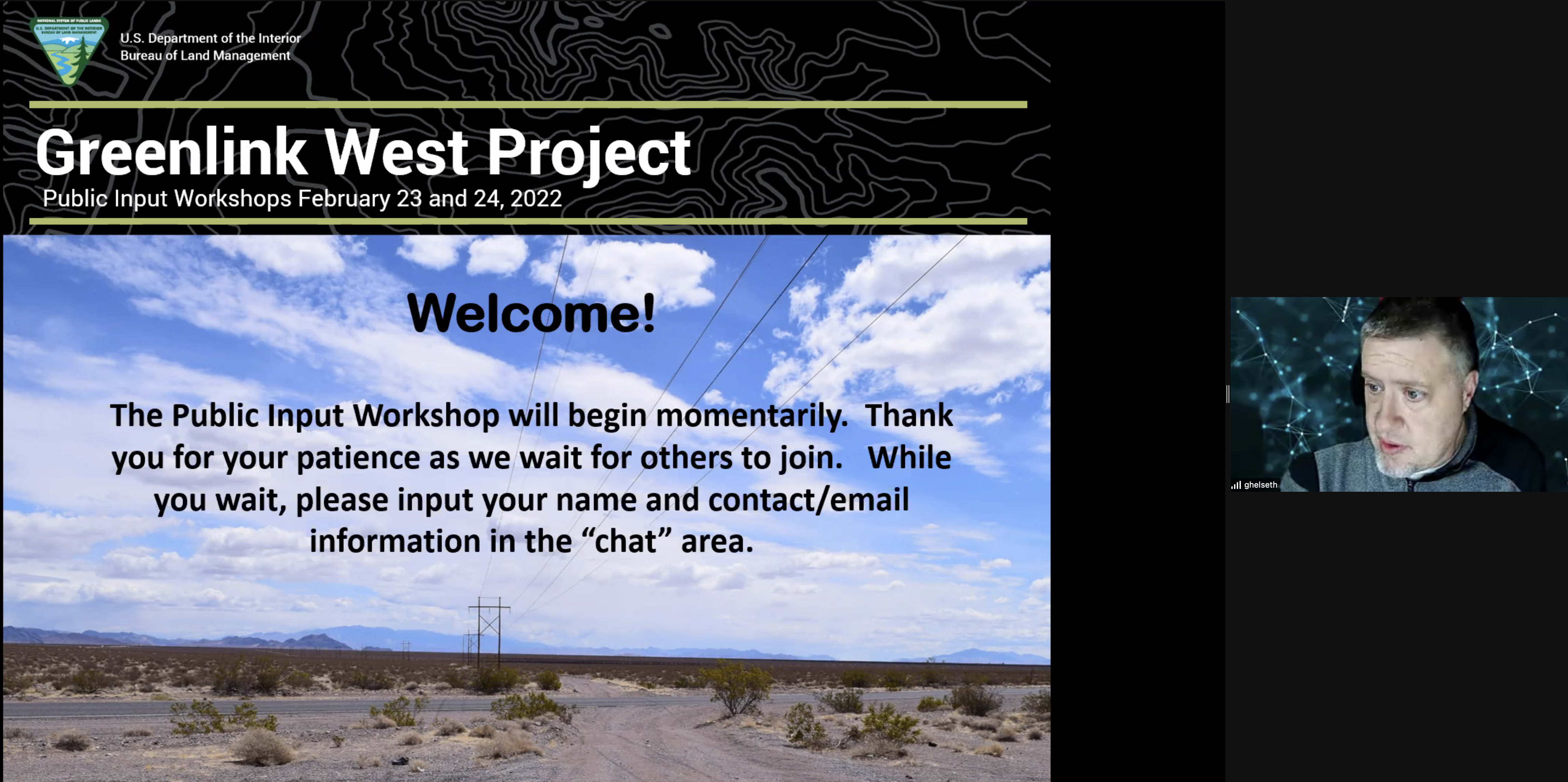
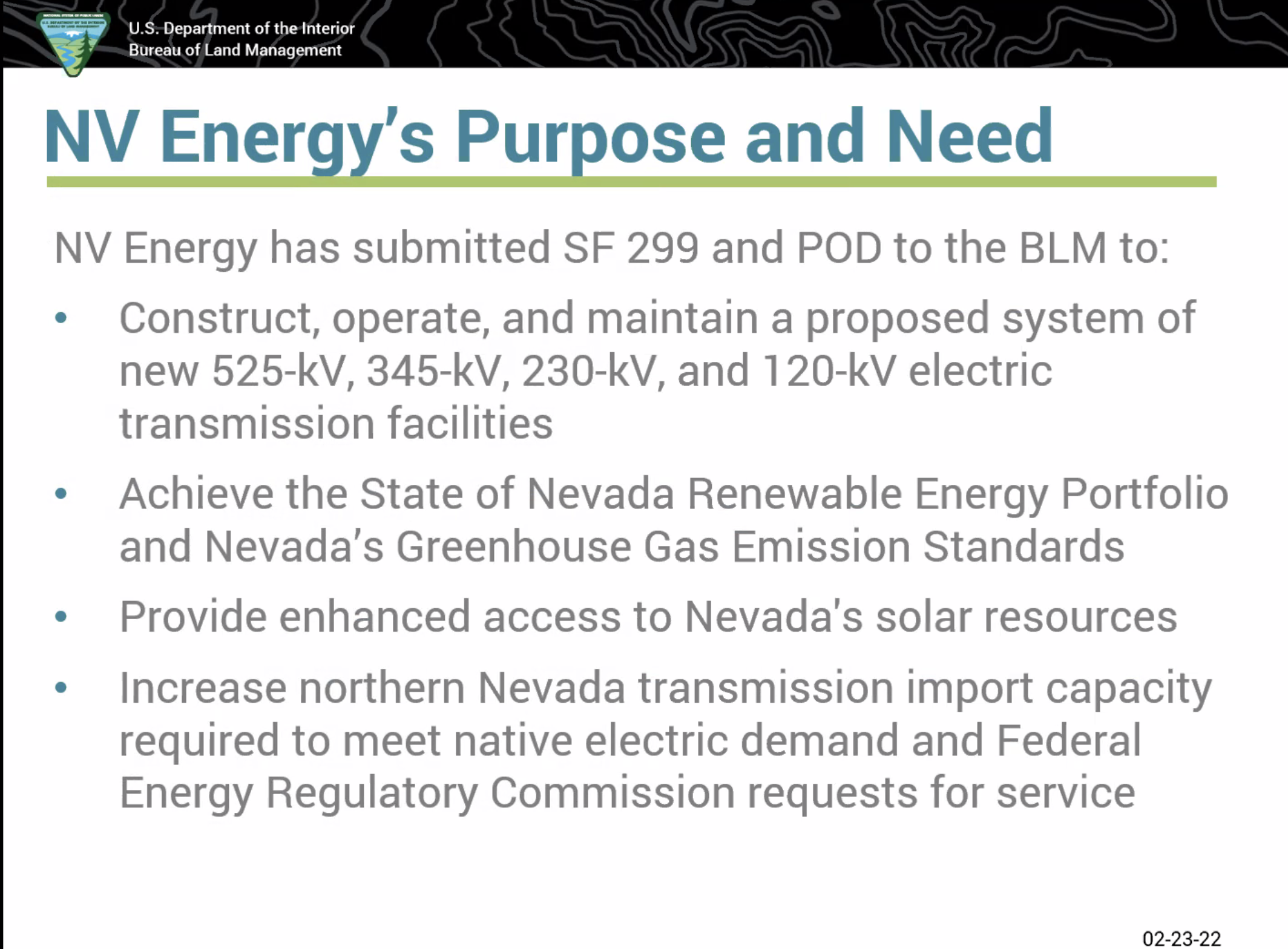
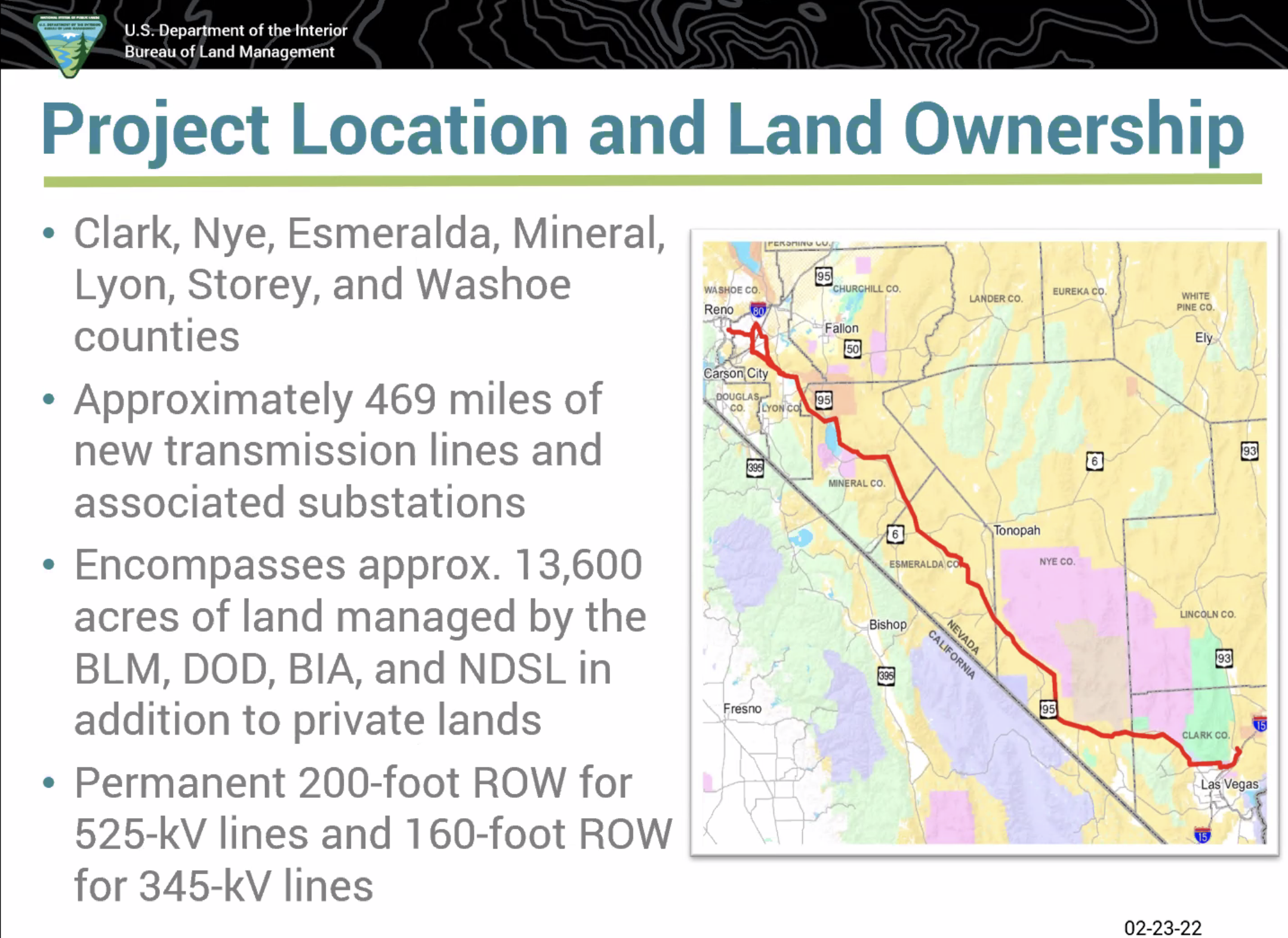
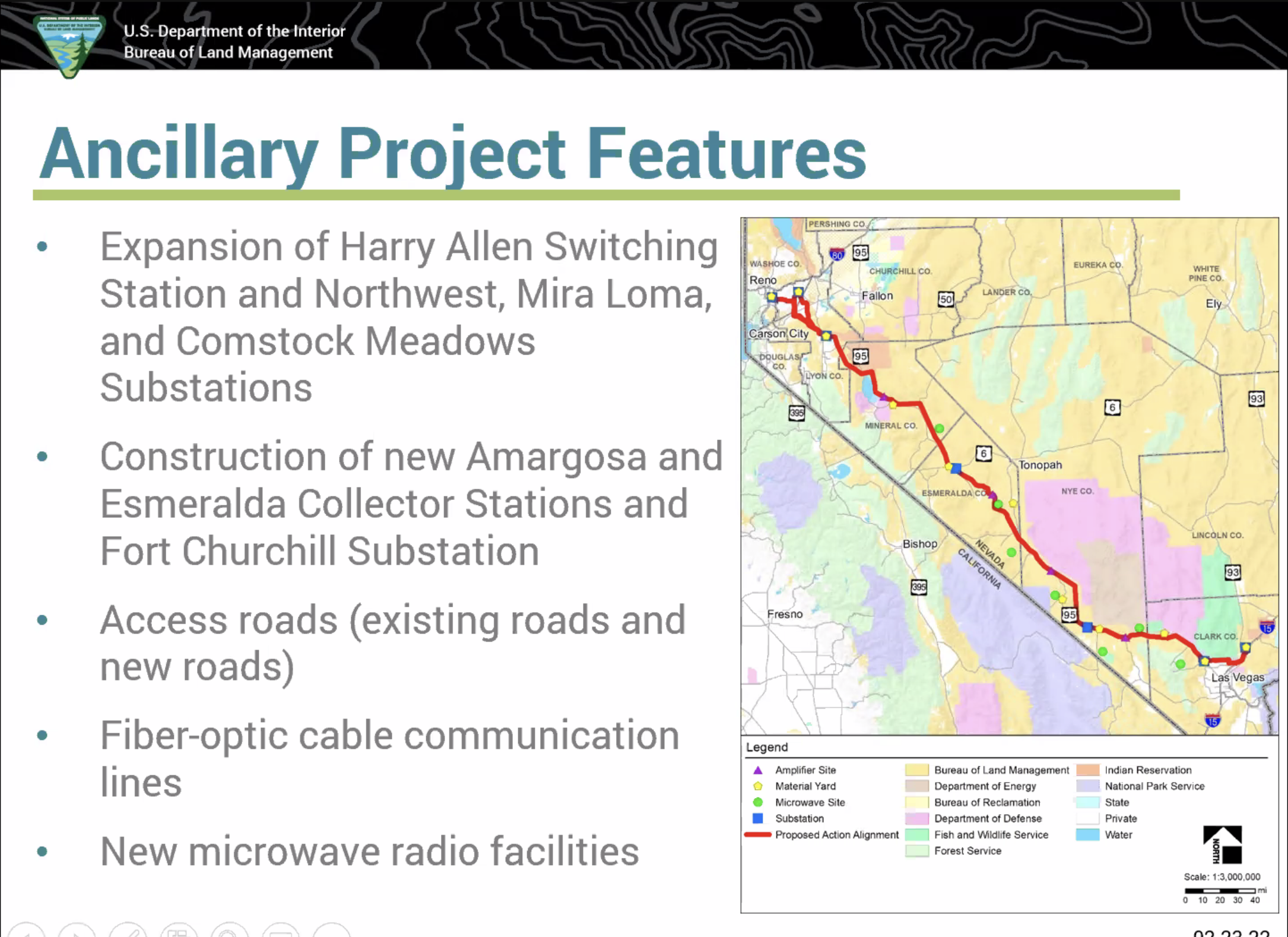
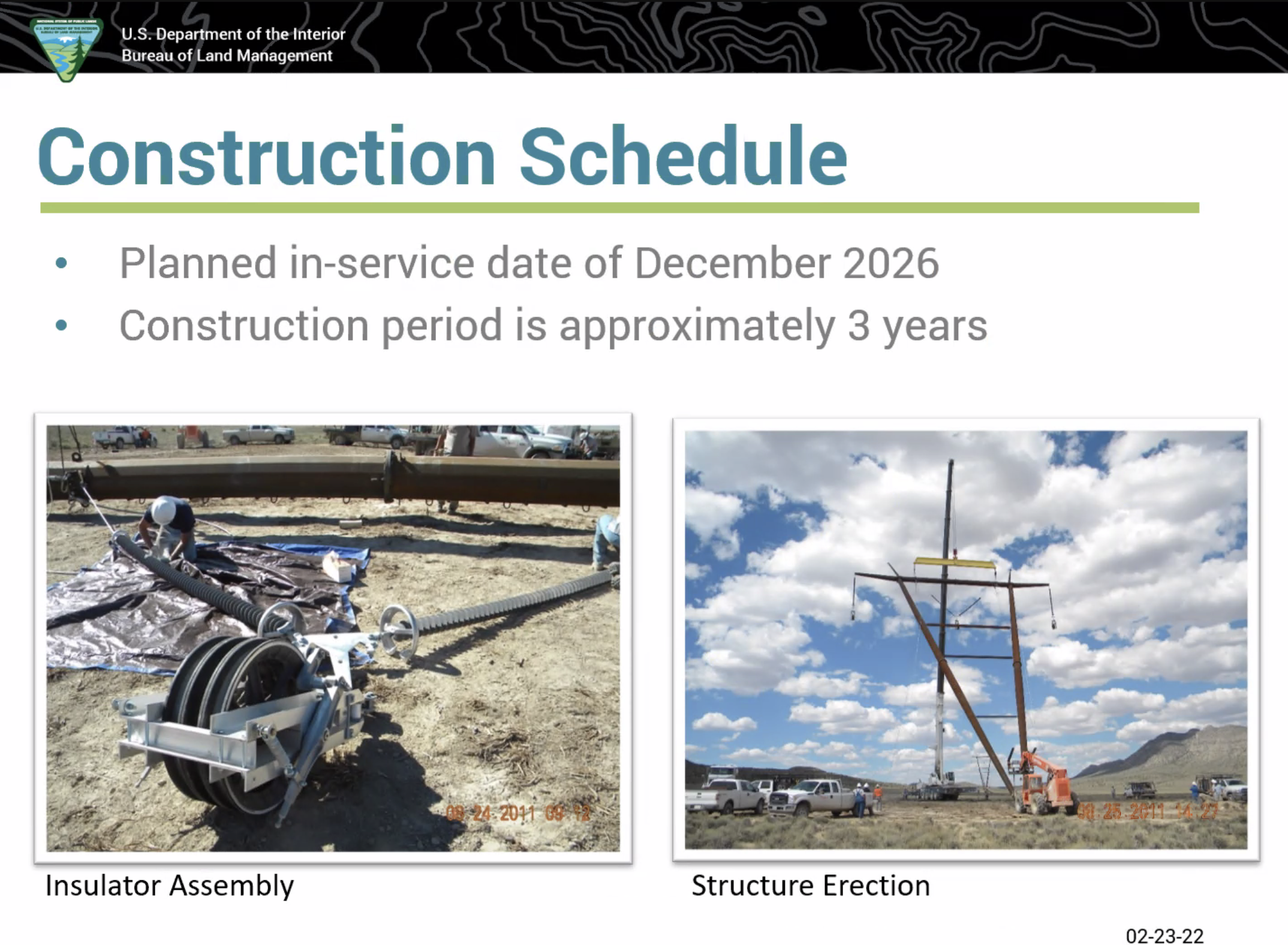
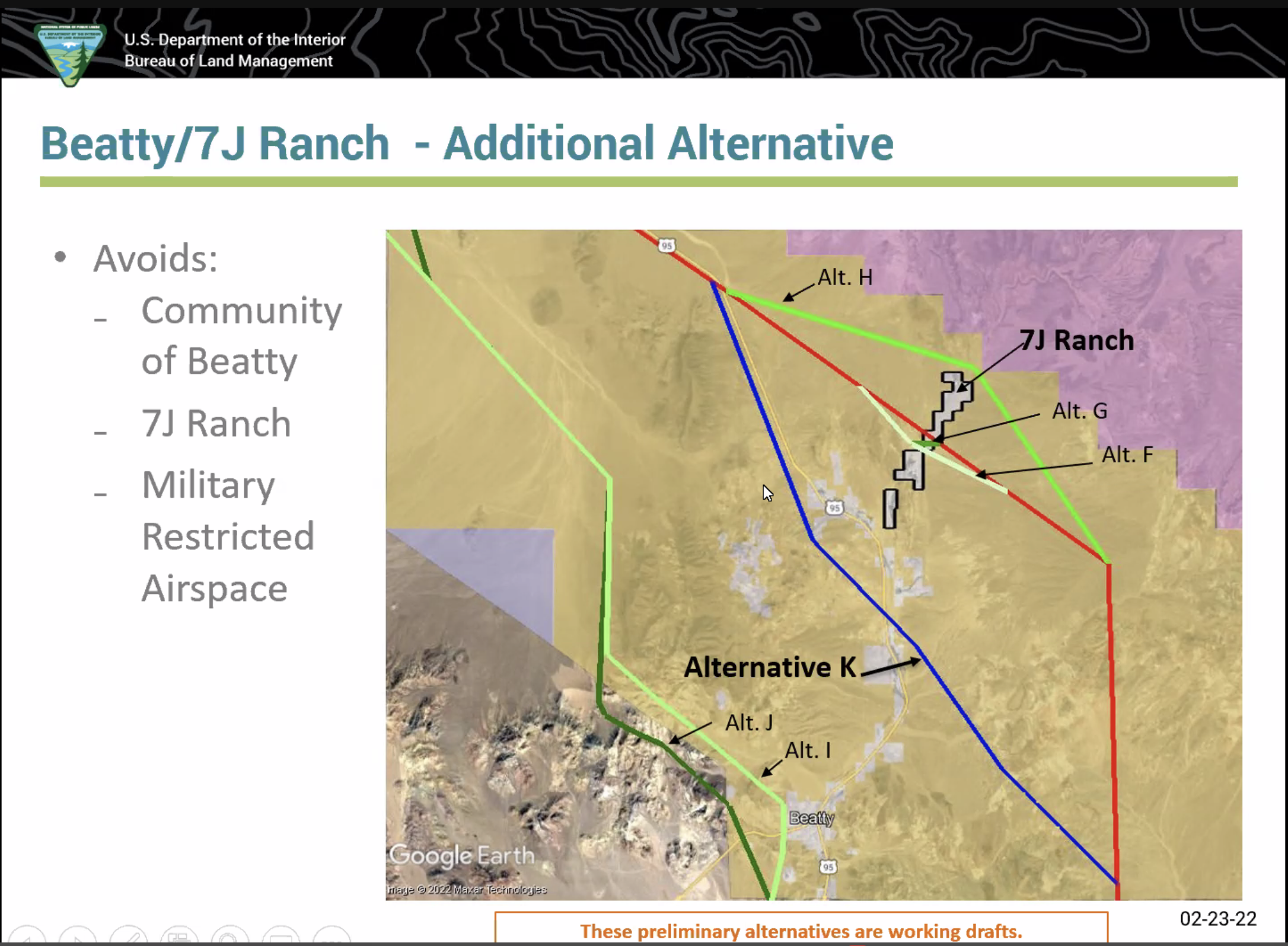
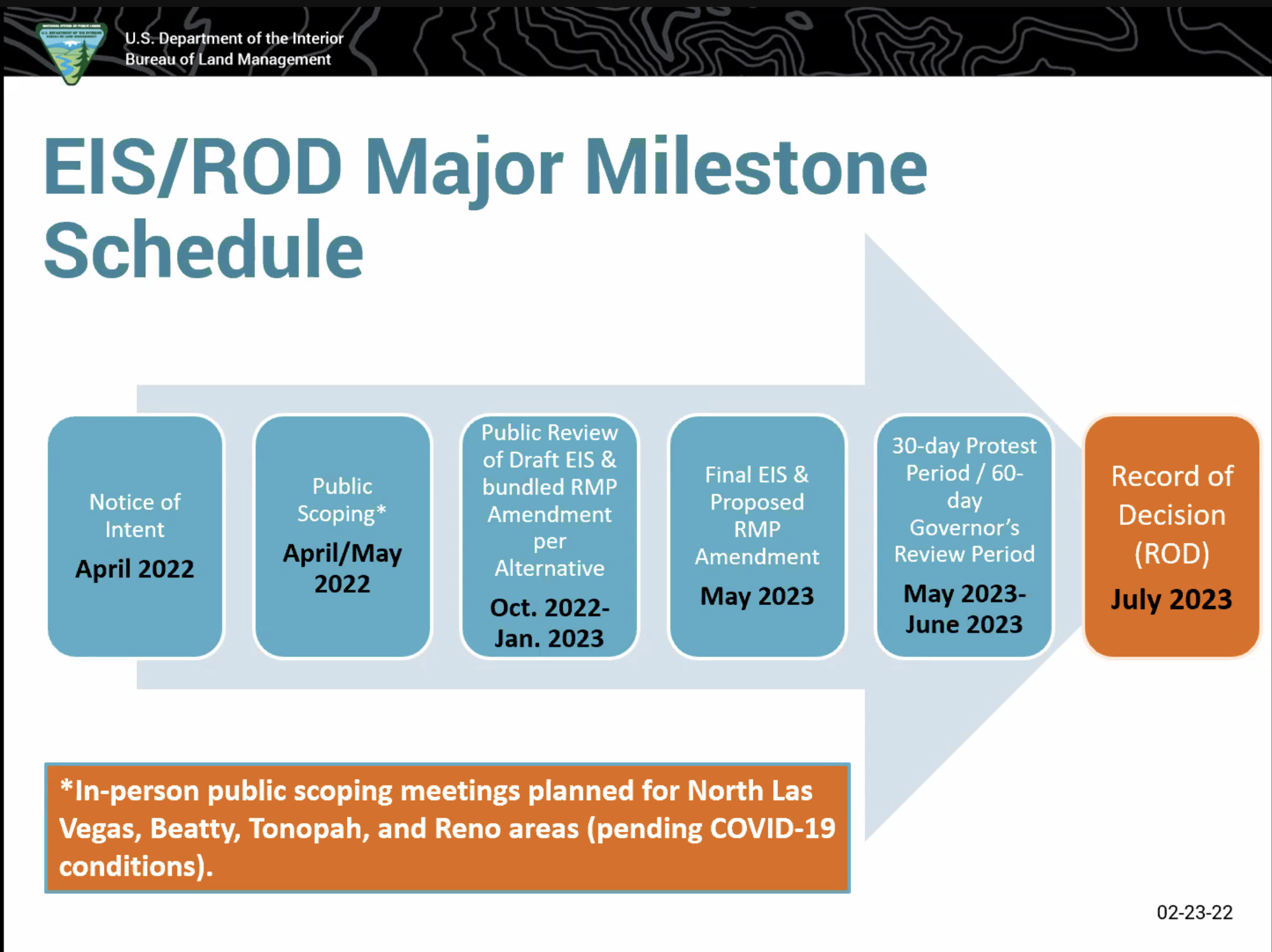
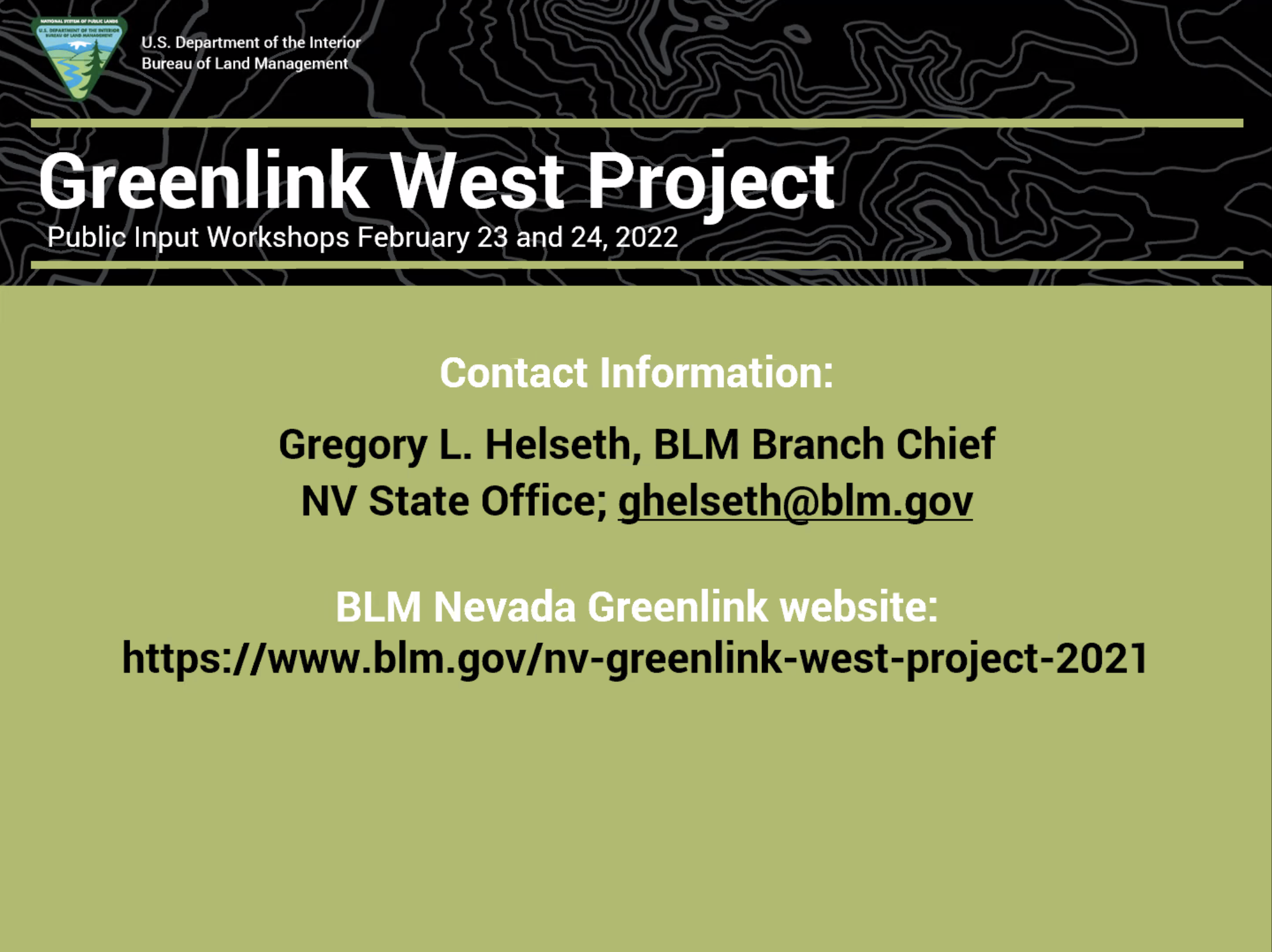
More Greenlink West Transmission Project Public Meetings
February 1, 2022-
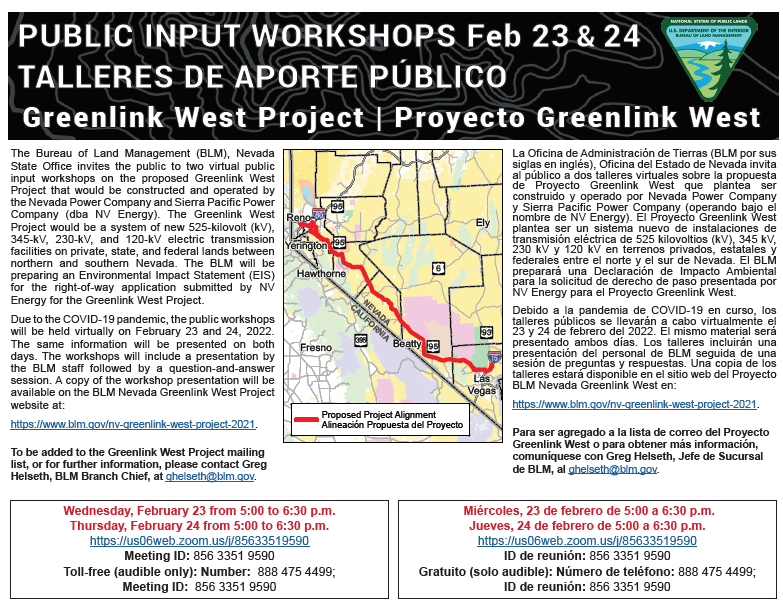
To join the Zoom: https://us06web.zoom.us/j/85633519590
Bureau of Land Management page: https://www.blm.gov/nv-greenlink-west-project-2021
November 2021 Public Meetings: Fossil Fuel Transmission Project Greenwashed For Utility and Silicon Valley Profit
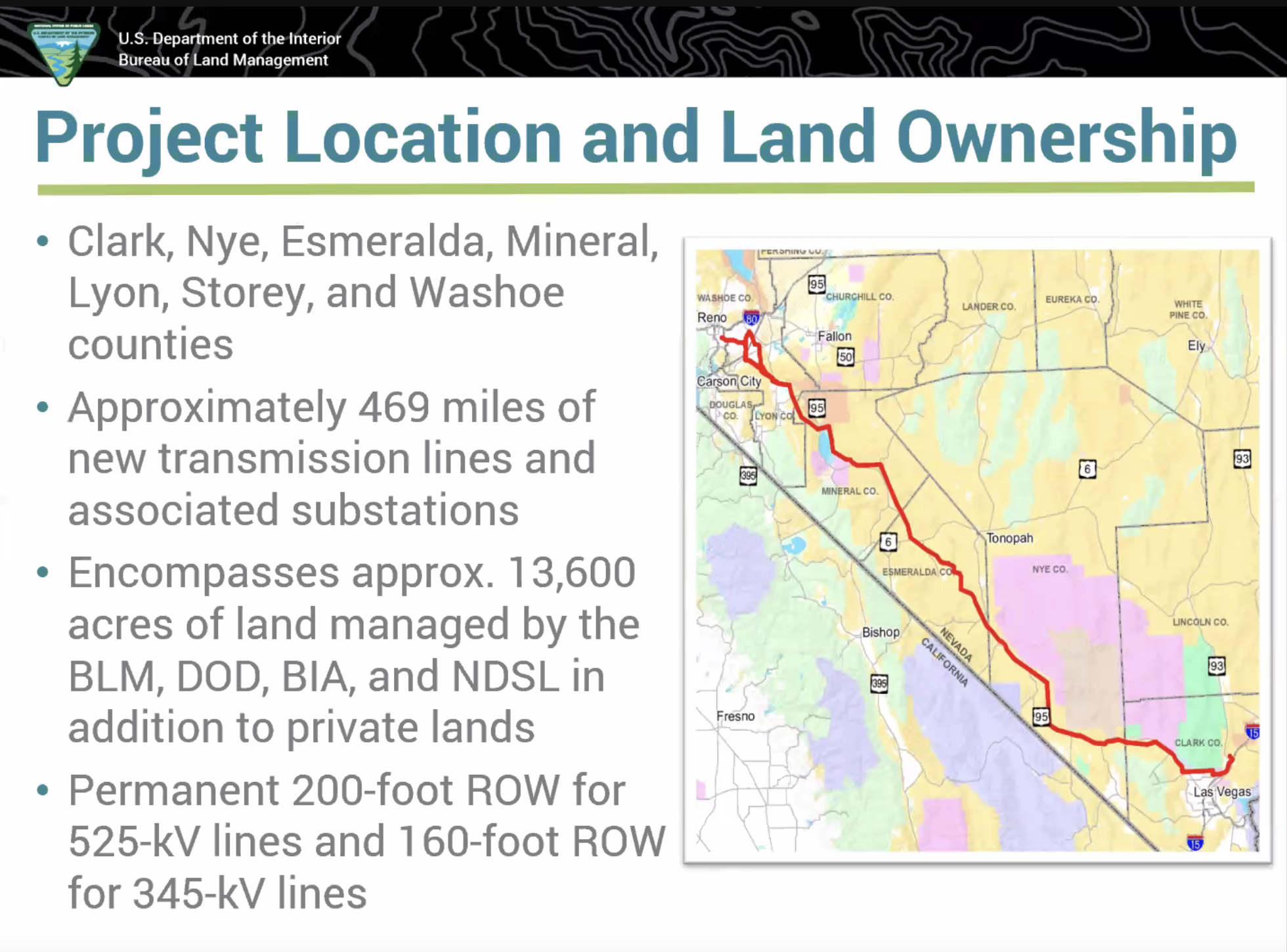
November 26, 2021 - Reno, Nevada - We attended an online public meeting for the proposed Greenlink West Transmission Project hosted by Greg Helseth, Renewable Energy Coordinator for Bureau of Land Management (BLM), out of Reno, NV on November 17 and 18.
The giant high-voltage transmission project pushed by Warren Buffet's NV Energy is proposed to connect Reno with Las Vegas, and develop tens of thousands of acres of utility-scale solar projecst on undisturbed habitats on public lands in western Nevada's wild and rural outback. The solar applications are already pouring in, even though the Greenlink West Transmission project has not yet begun the formal environmental review process. Proposed projects like the Beatty Solar Energy Center and Sawtooth Solar Project need the Greenlink West Transmission Project to be built in order for their applications to move forward and supply tech companies in Sparks, NV, with energy. But there are less destructive and less costly alternatives.
Our opinions and interpretations of the public meetings are discussed below, then following are the details of the BLM meetings with specifics and alternatives of where the prosposed Greenlink West Trasnmission Project would possibly be built.
Many organizations and groups have lamented that this giant transmission project is "inevitable." This project to open up vast solar developent in Nevada is most definitely not inevitable. Especially when you learn the dirty secrets behind it. We are oppsing this destructive transmission project.
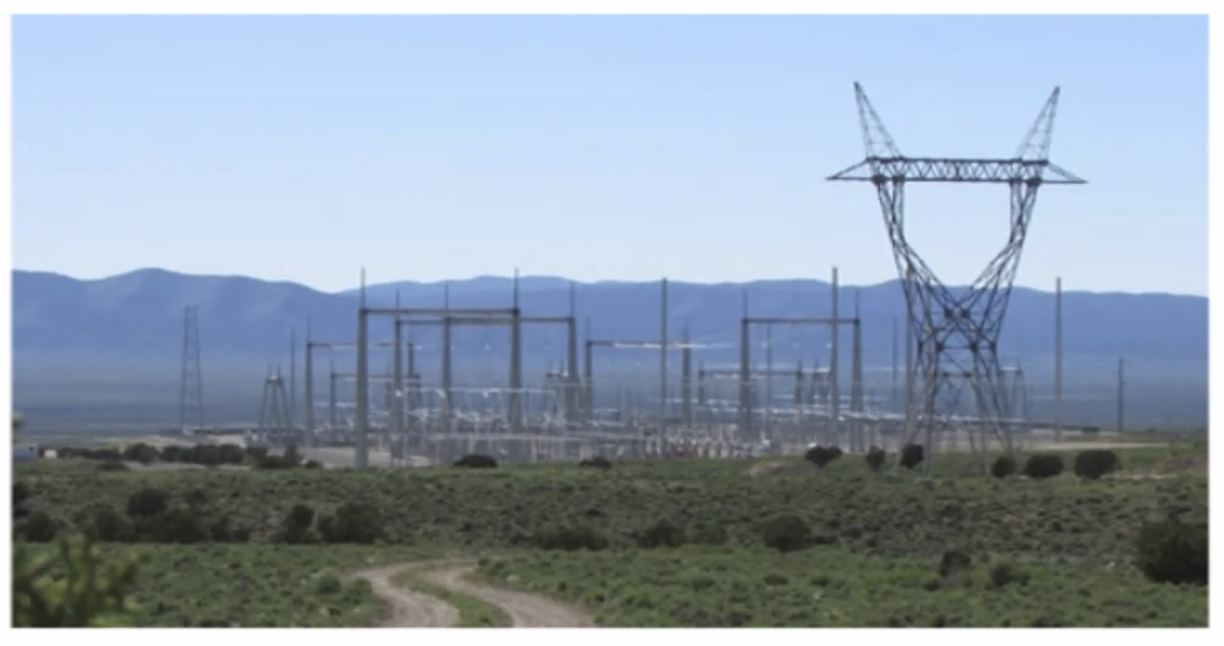
^High-voltage transmission project and substation.
Greenlink West To Serve Silicon Valley Tech Billionaires
The Greenlink West Transmission Project has been billed as a way to fight climate change, yet Basin and Range Watch first ferreted out that most of the power would be sent northward to the Silicon Valley tech companies now using Sparks, Nevada, as a cheaper hub away from their expensive San Jose home in California, with skyrocketing real estate costs and high taxes: the Tesla Gigafactory, Amazon warehouse, Switch servers, Microsoft and Google facilities. These energy-intensive tech factories have needed more power as they grow outside of Reno, Nevada.
Rather than contributing to sustainable living and lowering emissions, these tech facilities have been accused of poor working conditions in warehouses, unsustainable Lithium mining, and energy-intensive social media servers and data centers, in our own words: housing mountains of digital photos of kittens and puppies at an extremely high energy cost. Is this green?
Companies using blockchain technoloy are also setting up shop in the Reno area. Bitcoin mining, where specialized companies use complex computer blockchain algorithms to crack codes that access lucrative Bitcoins, are using increasingly gargantuan amounts of energy. Recently one Bitcoin was worth $59,000. Yet the enormous energy required by this advanced-level computing power can require entire power plants simply to maintain the digital high-grade frenzy. This is definitely not "green", and more "greed" than anything we have seen to date.
Yet the "Greenlink" West Transmission Project would deliver power generated across rural Nevada to these for-profit companies that seem to have nothing to do with sustainability or climate change, and more about huge profirs funneled towards launching personal rockets into near-space luxury trips.
Greenlink West is Actually "Gaslink" West Transmission Project
But what was amazing was how Greg Helseth of BLM admitted during these November meetings that the end-point of Greenlink West Transmission Project would be Apex, Nevada, and three natural gas generating facilities--the fossil fuel baseload truly needed to power the tech companies in Sparks and Reno.
The last time we checked, natural gas was a dirty fossil fuel.
Apex Industrial Park just north of Las Vegas has 2,250 megawatts (MW) of baseload fossil fuel generation, which is still very important to balance out intermittent renewable energy: the Harry Allen Generating System (628 MW), Silverhawk Generating Station (520 MW), and Chuck Lenzie Generating Station (1,102 MW)--all owned and operated by NV Energy.
NV Energy seems to be driving this entire Greenlink transmission and solar project plus natural gas connection project, in order to increase their profits, their monopoly, and hold on Nevada ratepayers. Trasnsmission projects are rate-based and ratepayers will shoulder the cost of this long, expensive powerline. Rooftop solar and Net Energy Metering policies simply do not fit into their for-profit investor-owned business structure.
Yet rural Nevada communities, public lands, and wildlife will suffer if this is built, bringing with it thousands of acres of utility-scale solar energy projects along the transmission line in relatively pristine habitats, tribal cultural landscapes, and recreational areas.
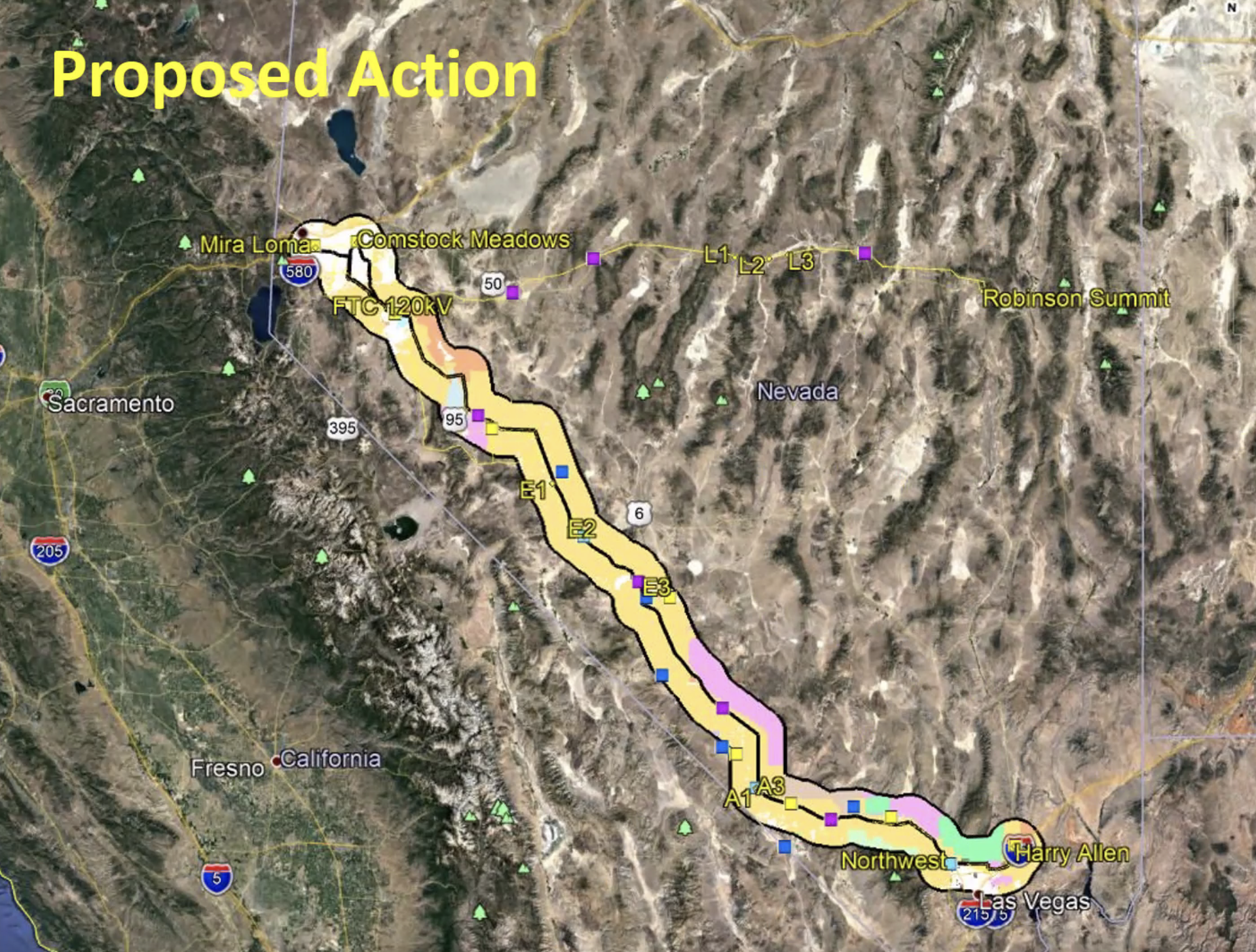
^Map from the Bureau of Land Management November presentations on Greenlink West proposed high-voltage transmission line, screenshot of the PowerPoint presentation by Greg Helseth. The Harry Allen natural gas power plant is named at Apex, connecting up to the Comstock Meadows Substation, which serves theTtesla Gigafactory and other tech company facilities in Sparks, NV. No mistaking it: this is a fossil fuel transmission project being sold as a "green" transmission line.
More Efficient Alternatives?
The Federal Energy Regulatory Commission (FERC) actually suggested various alternatives early on for supplying the Silicon Valley tech companies in Reno-Sparks with more power.
One suggested alternative was to convert the pre-existing transmission infrastructure to the nearby Valmy coal plant into a natural gas generating facility. FERC rejected this alternative in favor of the giant greenwashed boondoggle of building a very long Greenlink West Transmission Project all the way south to Apex, Nevada, and link to the existing natural gas power plants clustered there that feed power to Las Vegas. Cleverly, the transmission project is greenwashed as proposing many solar projects along the way. But we can plainly see the original intent.
One wonders if a more climate-friendly alternative would actually be one of these original proposals. We might suggest an alternative to Greenlink West that can much more cheaply power the Sparks Silicon Valley tech factories there, using existing transmission lines that go a relatively short distance east to the existing Valmy coal plant. A "cleaner greener" alternative might actually be to convert this Valmy coal plant into a super-efficient modern combined cycle natural gas generating facility with Carbon capture technology, much closer to the load center at Sparks-Reno. Rather than inefficiently building huge new expensive tramission lines 400-plus miles south to other natural gas power plants.
So Greenlink West is not actually "green"--it is brown, fossil fuel, "Gaslink West" project! The solar project applications along it are just greenwashing a fossil fuel transmission project.
This reminds us of how the Ivanpah Solar power towers were supposed to be so great, but actually rely heavily on inefficient natural gas boilers tapped into the Kern River 2 natural gas pipeline which traverses Ivanpah Valley in the northern part. Natural gas boilers are very inefficient and archaic. A modern combined cycle natural gas plant with a hybrid solar thermal field attached to it would have been much more efficient at producing reliable energy and baseload at Valmy, to supply Sparks tech facilities, and a solar thermal hybrid technology would lessen the burning of fossil fuels during sunny peaks hours. But these early proposals got shot down.
We are left with an ever-increasing greenwashing of solar power projects that are actually relying on ineffienct primitive and costly fossil fuel back-ups.
Greenlink West seems to be similar to the Ivanpah Solar Electric Generating System (relying on natural gas) --instead of converting a closed coal plant near to Sparks, and making it into a modern super-efficient baseload combined cycle natural gas plant with advanced Carbon capture technology, or even a hybrid solar thermal plant, NV Energy is pushing a 350-mile long transmission project that it can profit off of, connecting to their fossil fuel plants very far away from the load centers to the natural gas plants. There is an estimated 11% line-loss of energy through long-distance transmission lines from generating sources to load centers. This is not green.
Public Meeting Discussions on Where to Put This Transmission Line
The bulk of the November 17 and 18 meetings hosted by BLM were concerning proposed alternatives to get around trouble areas in order to keep the Greenlink West Trasnmission Project moving forward. We learned how many problem areas there still area, and many alternatives that will need to be analyzed in the future environmental review under the National Environmental Policy Act (NEPA).
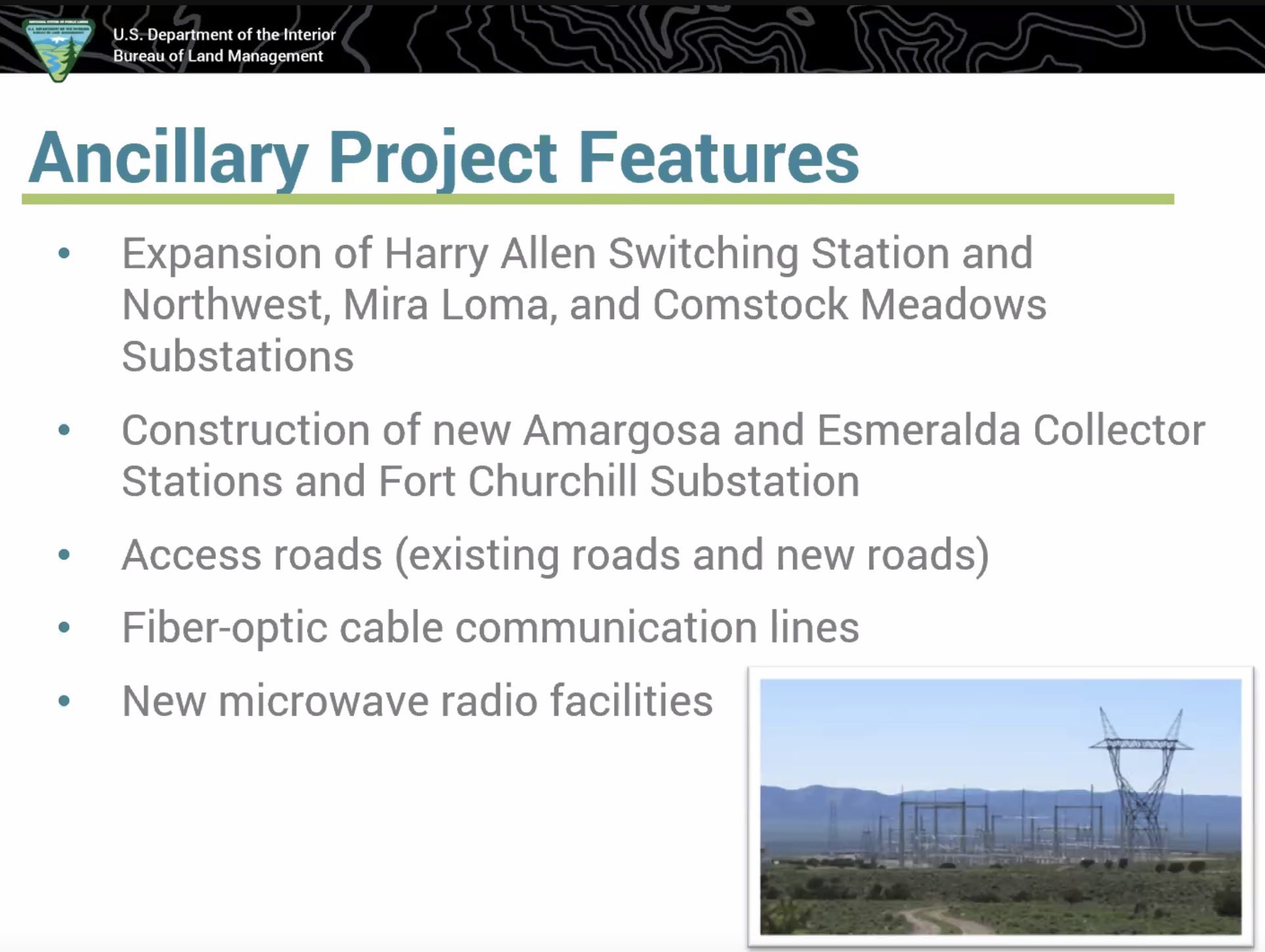
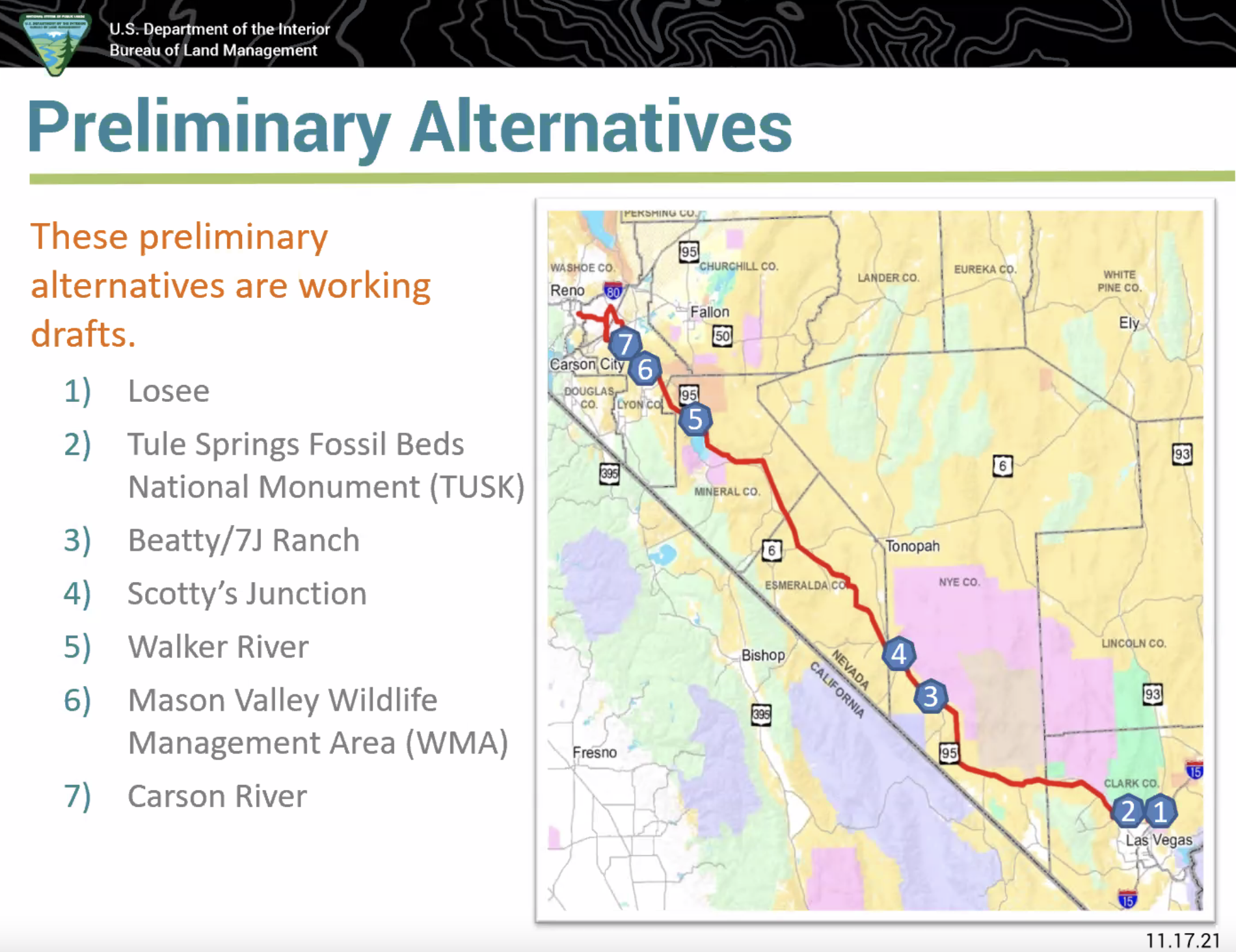
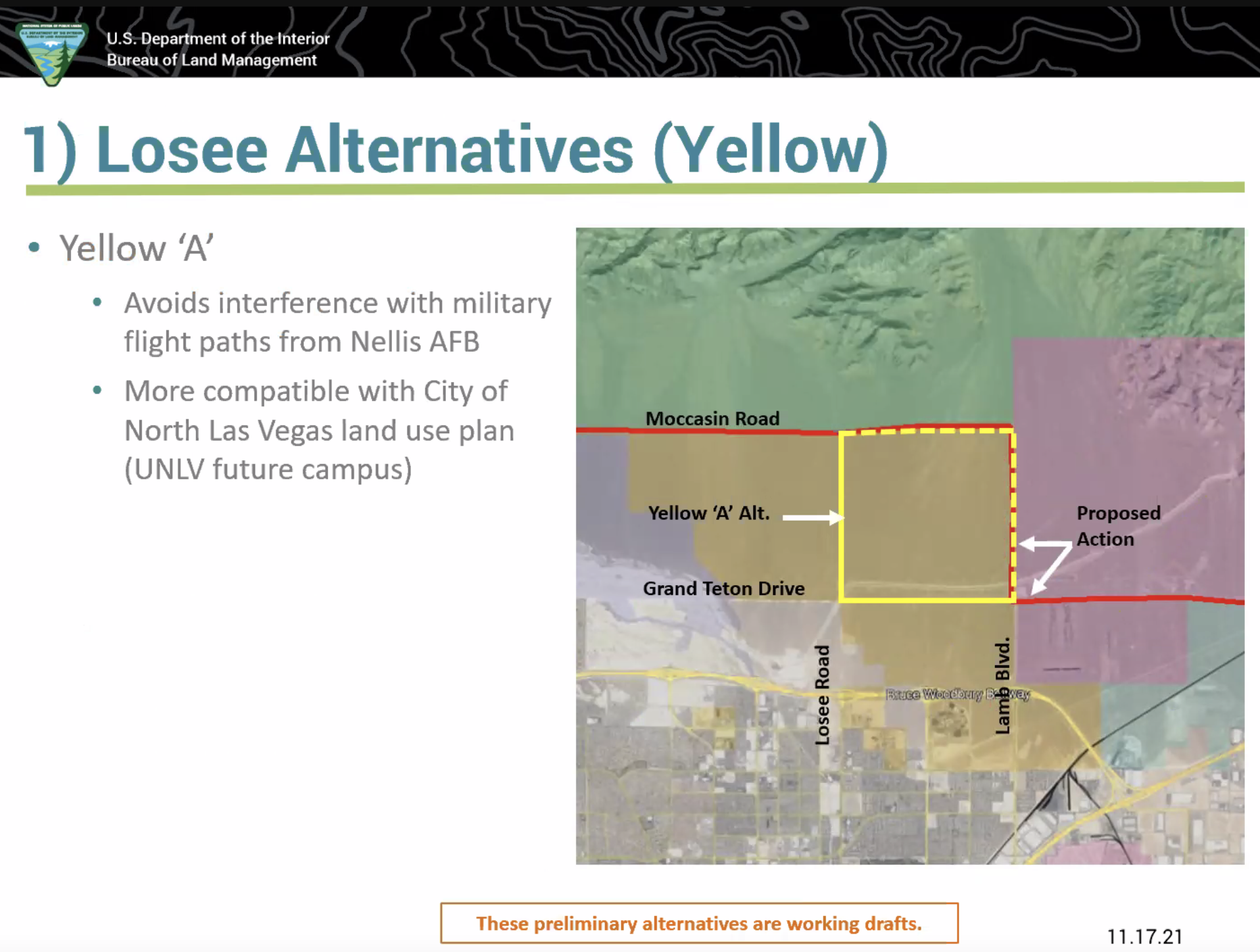
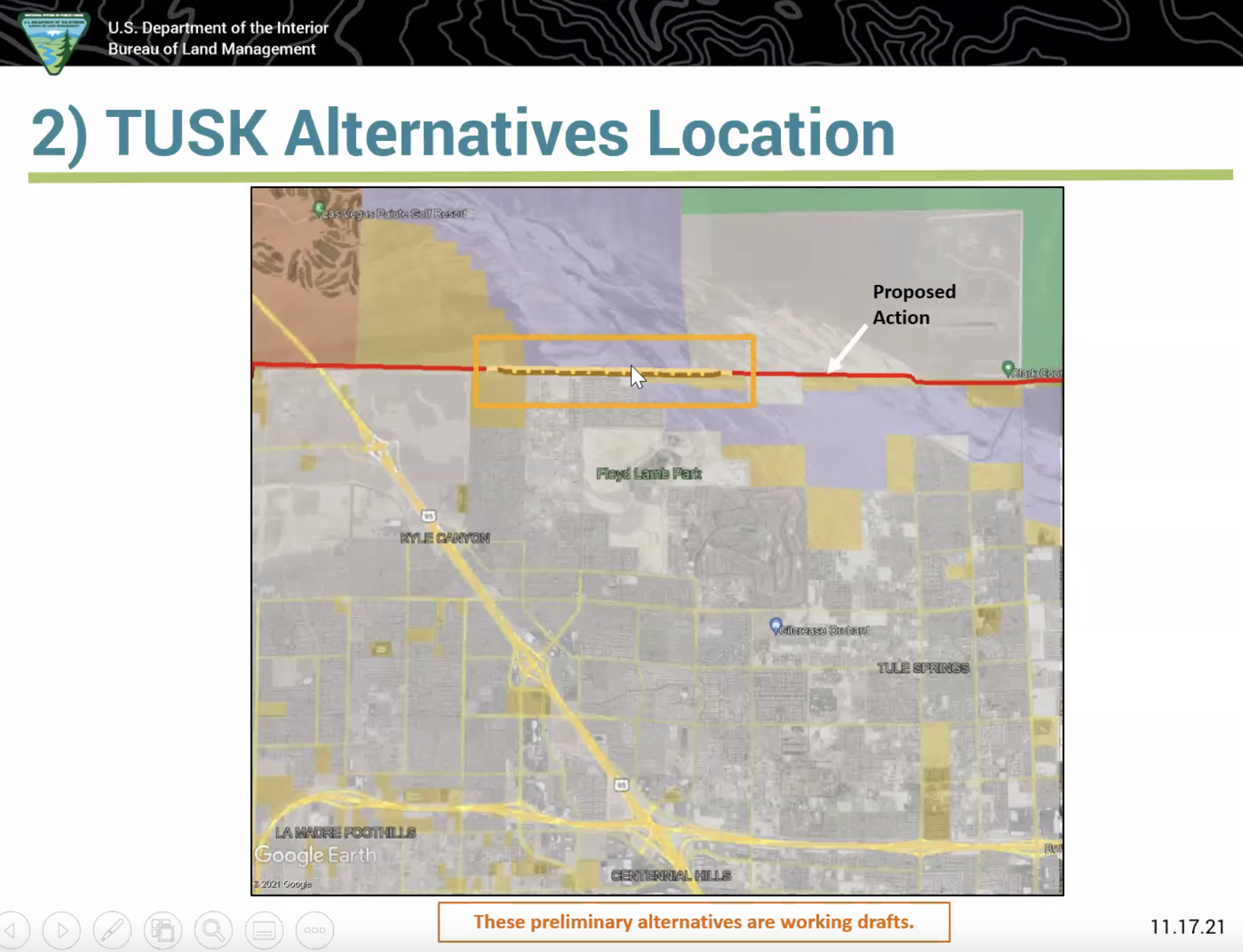
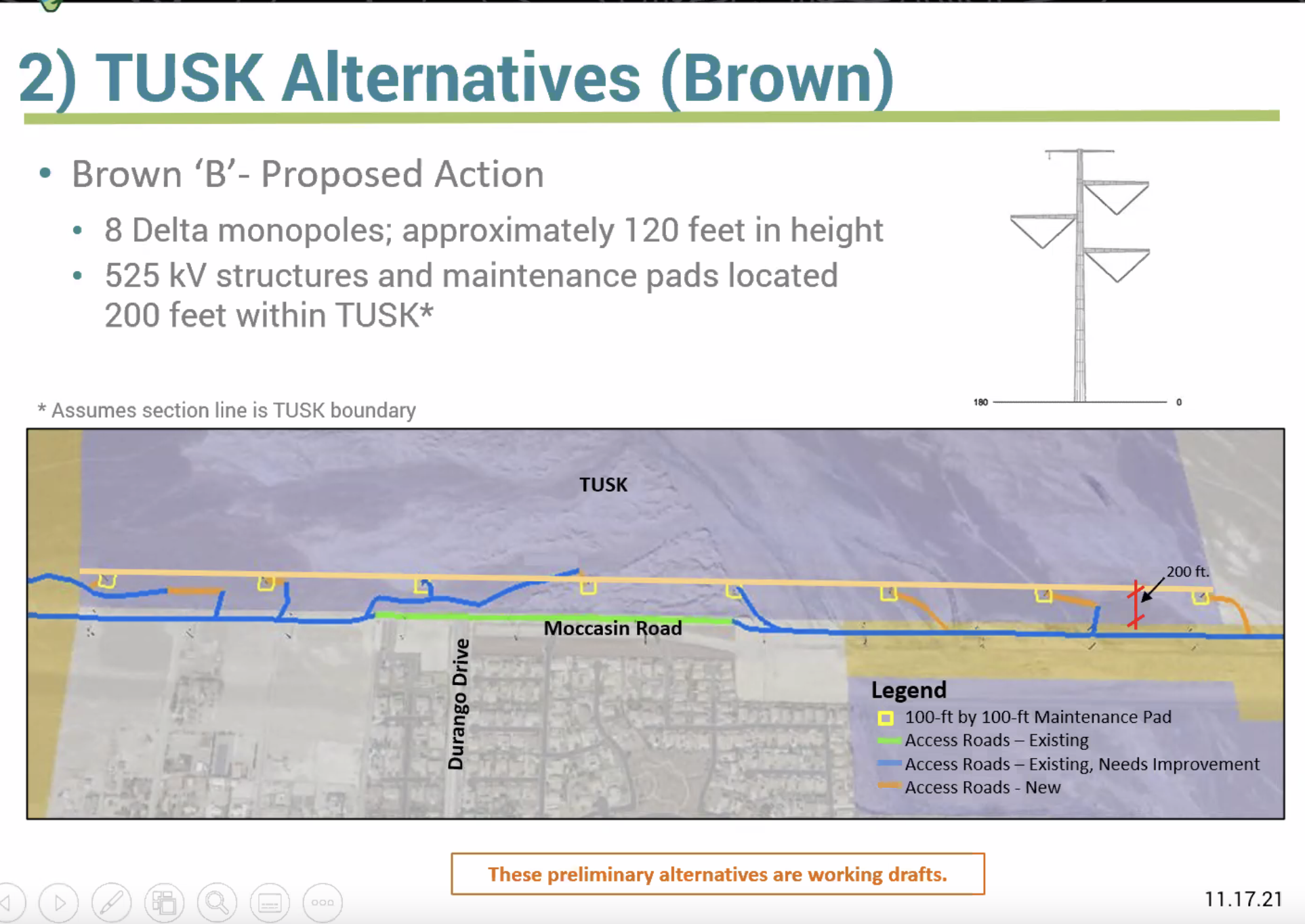
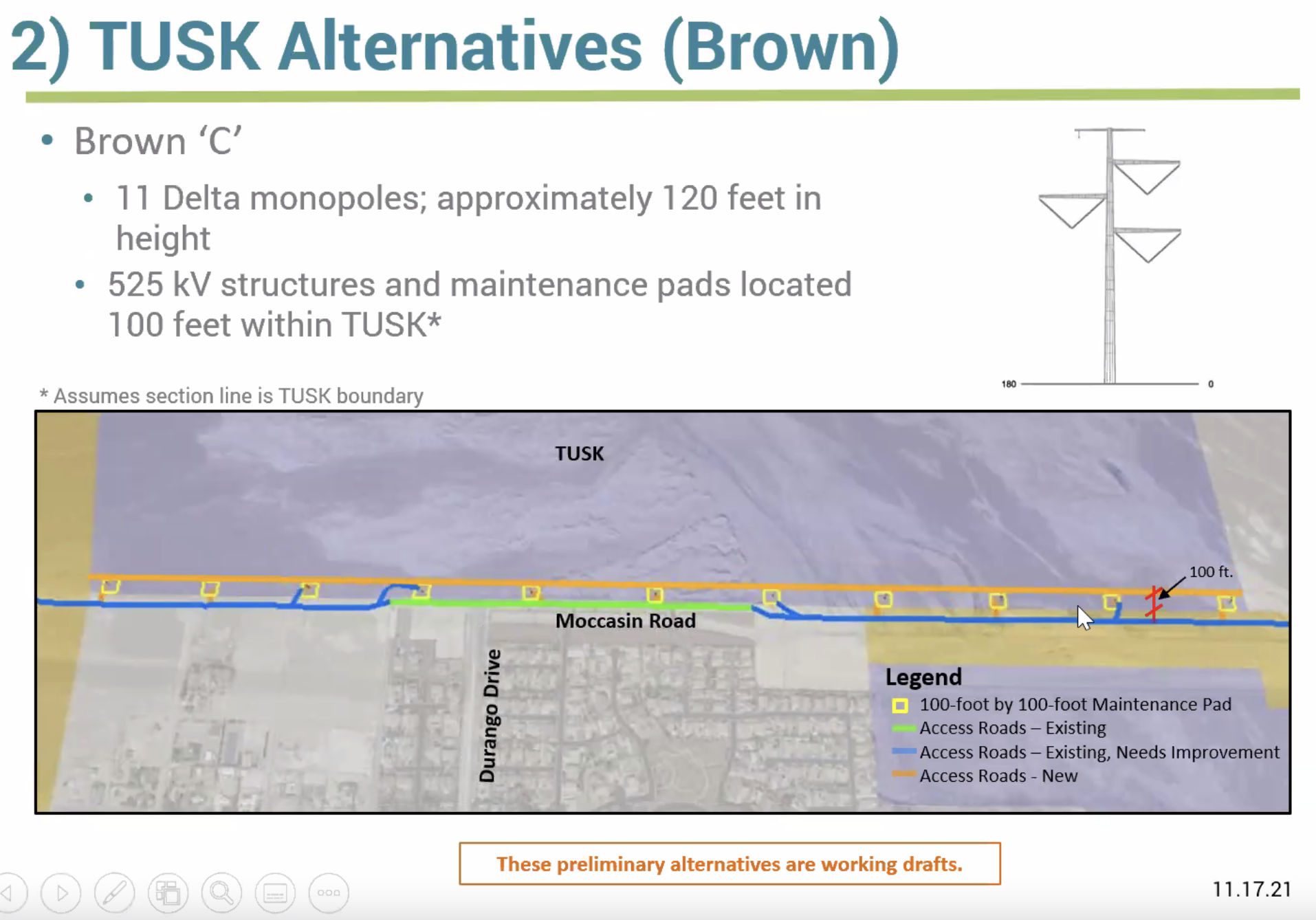
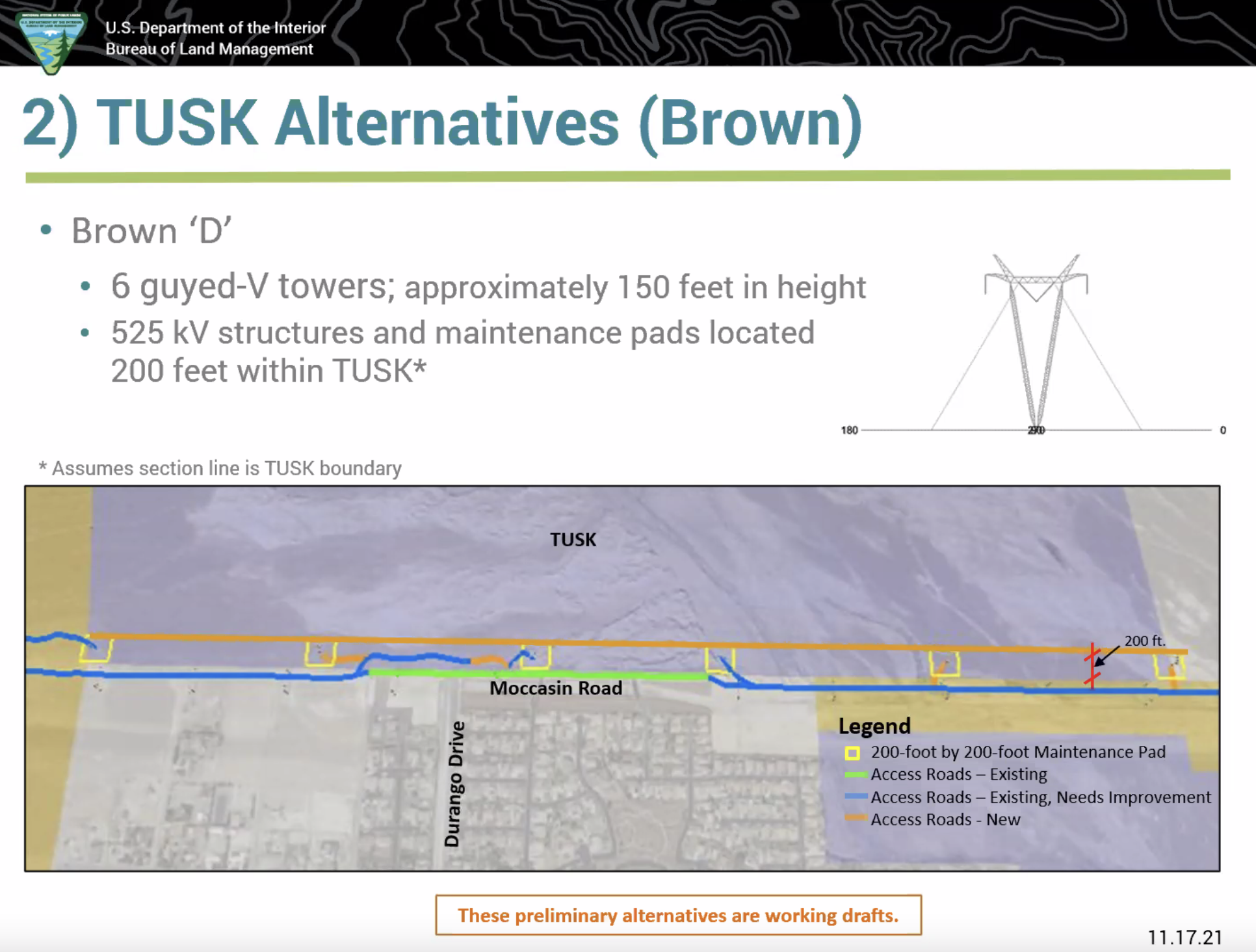
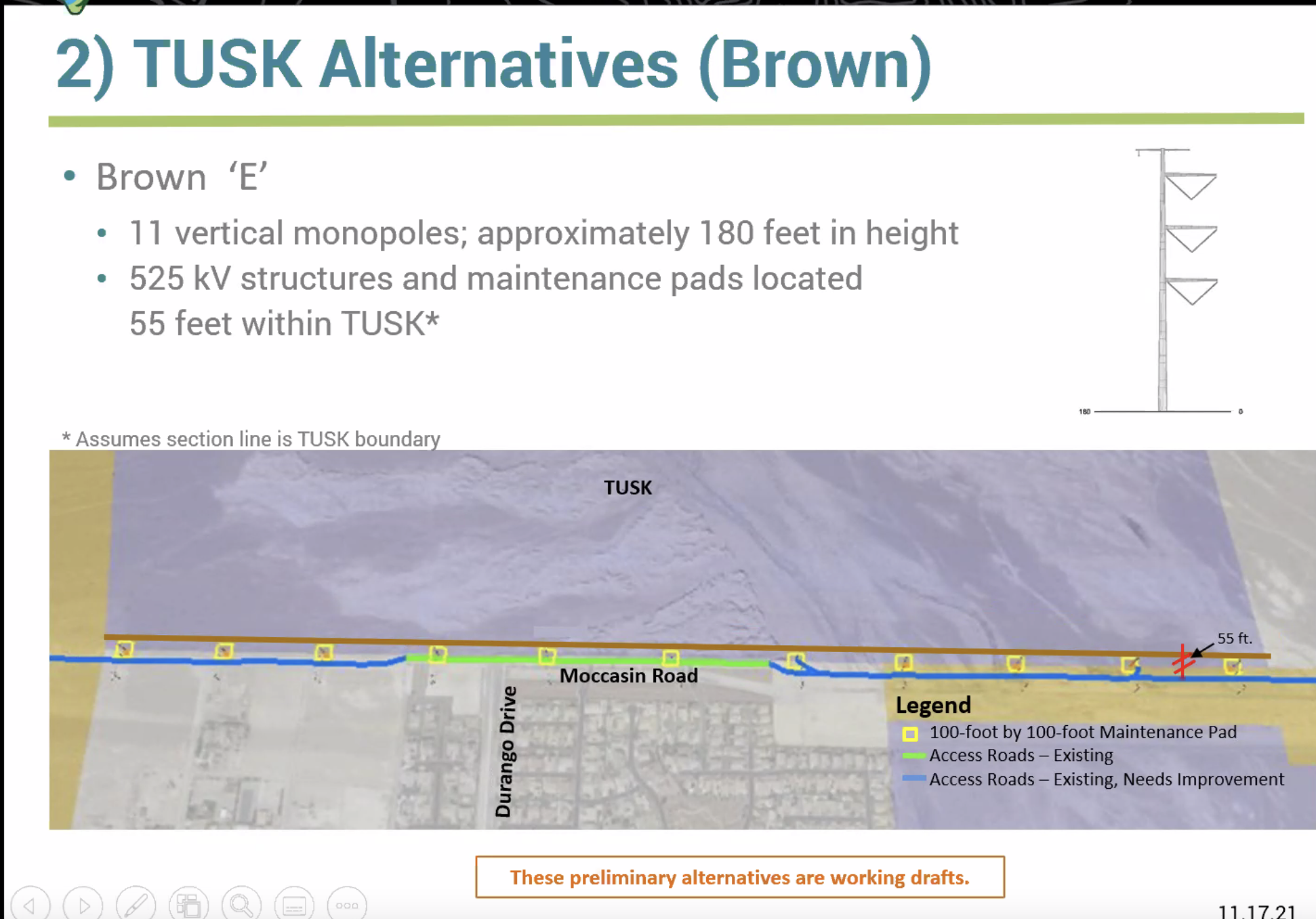
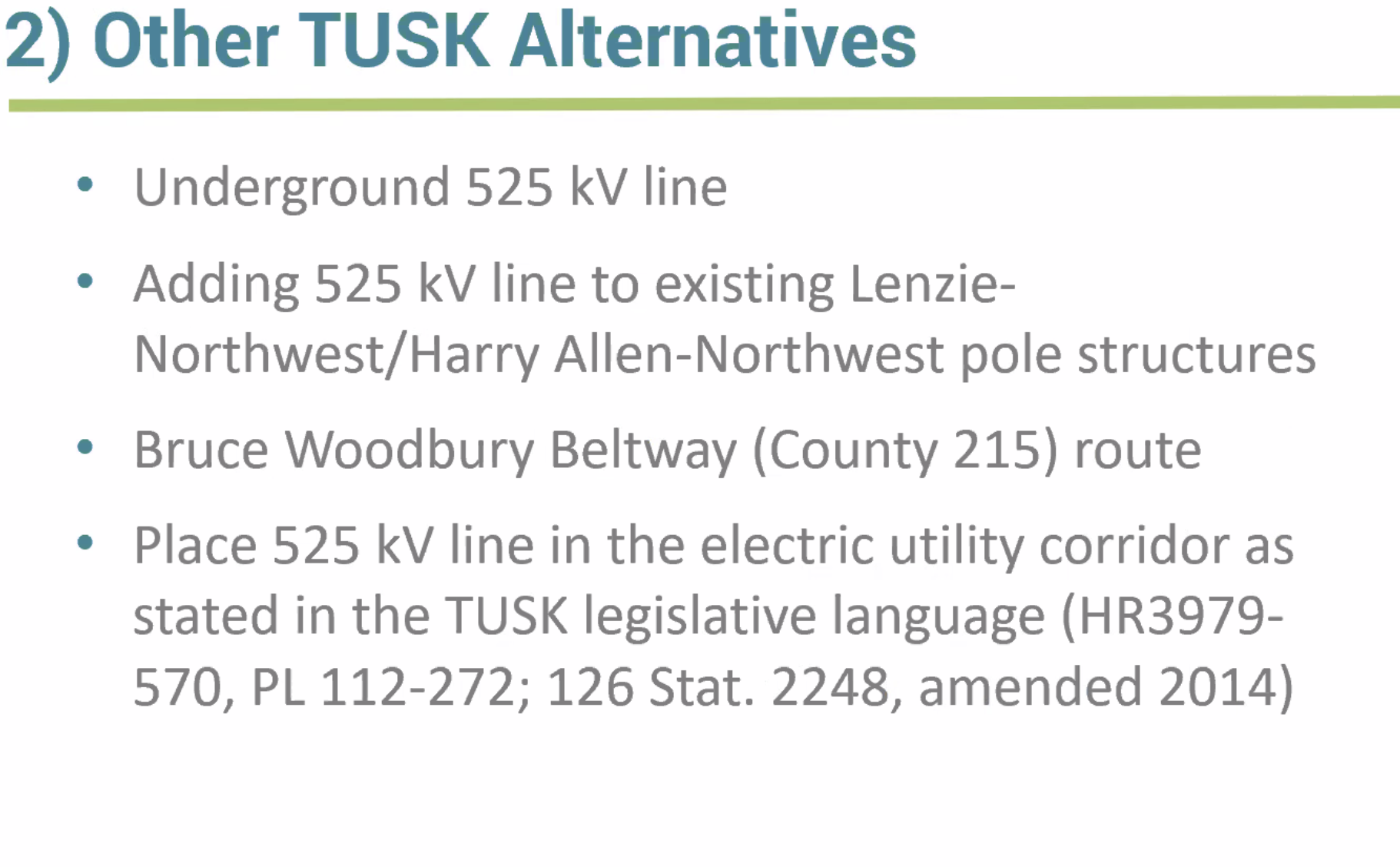
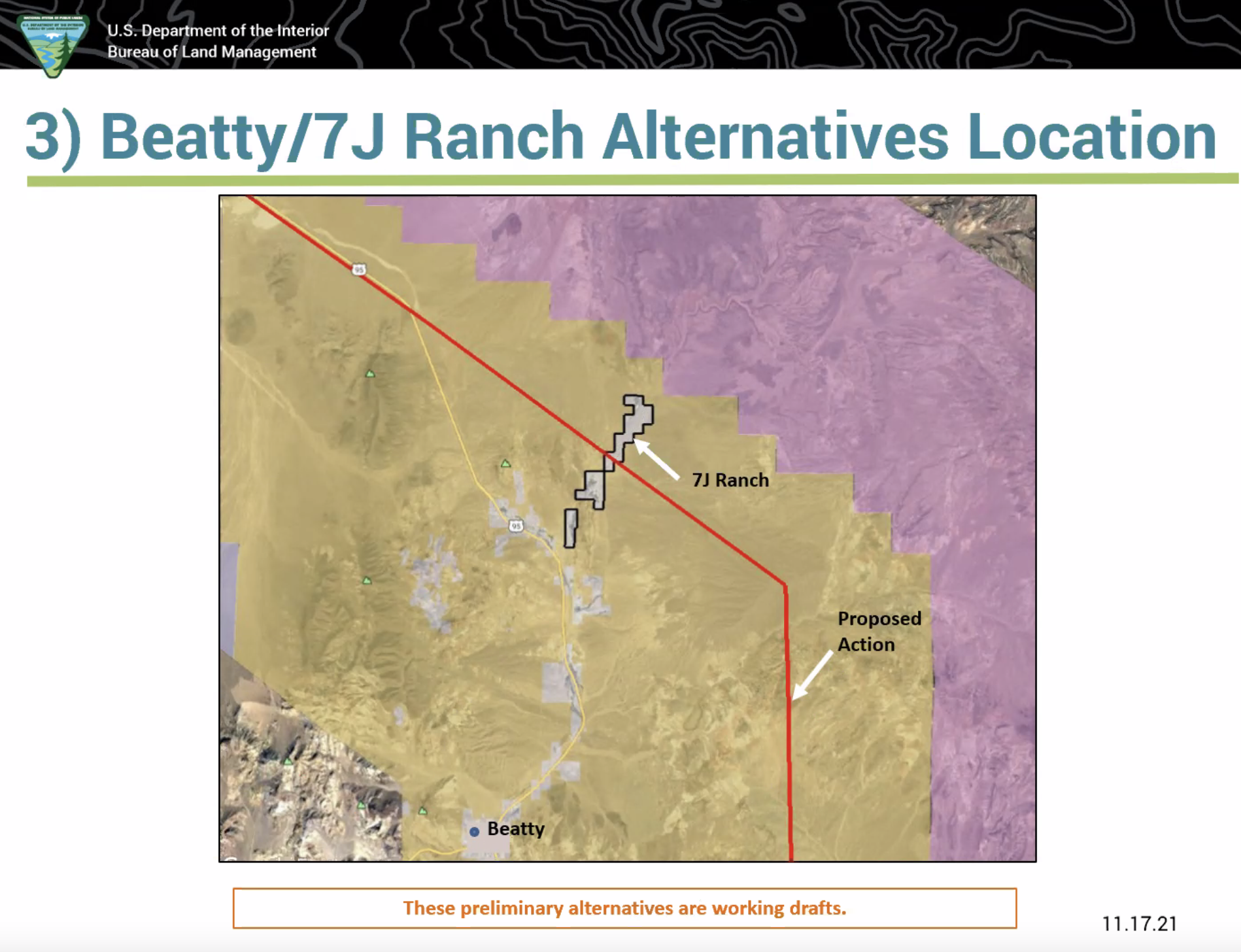
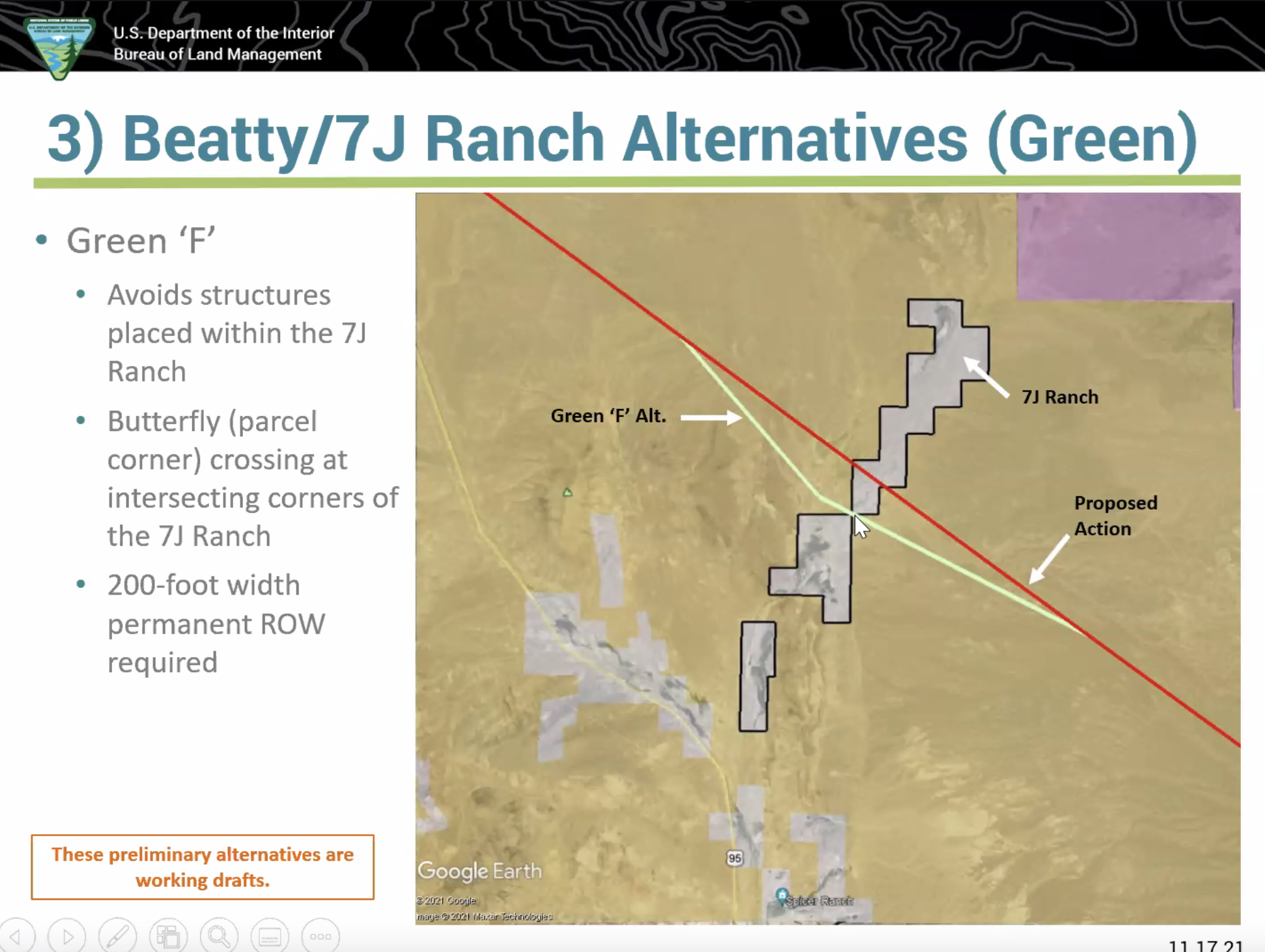
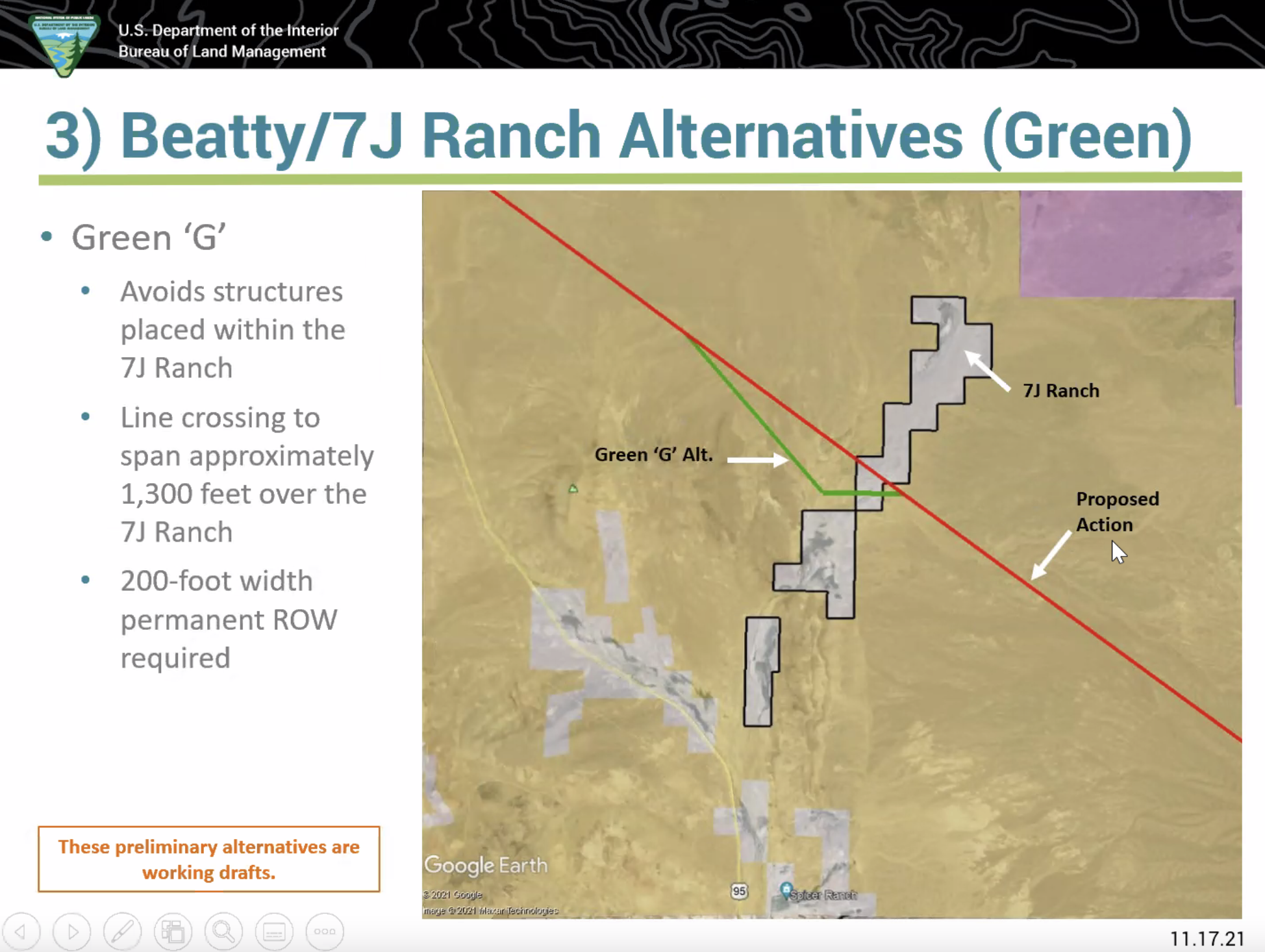
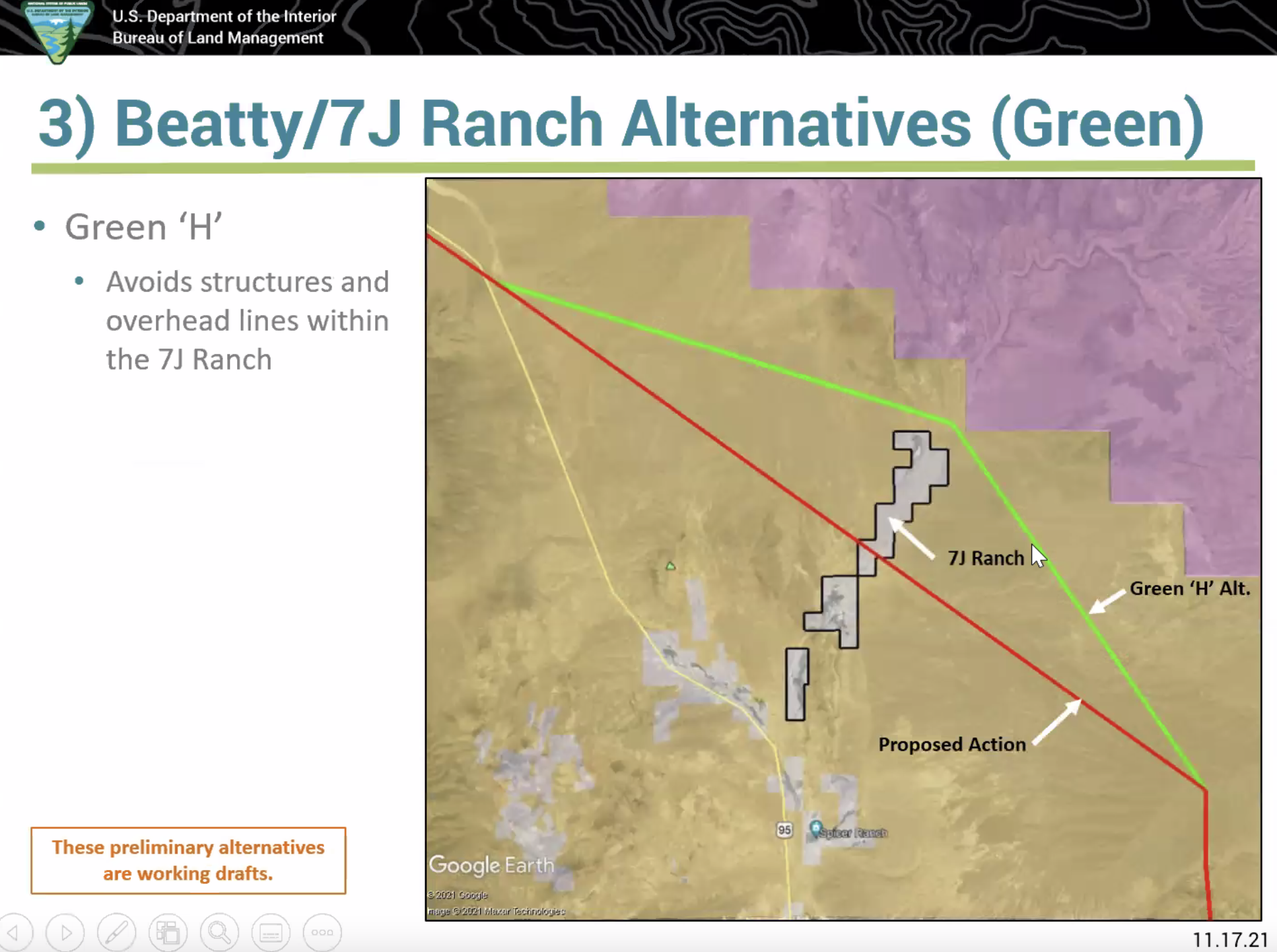
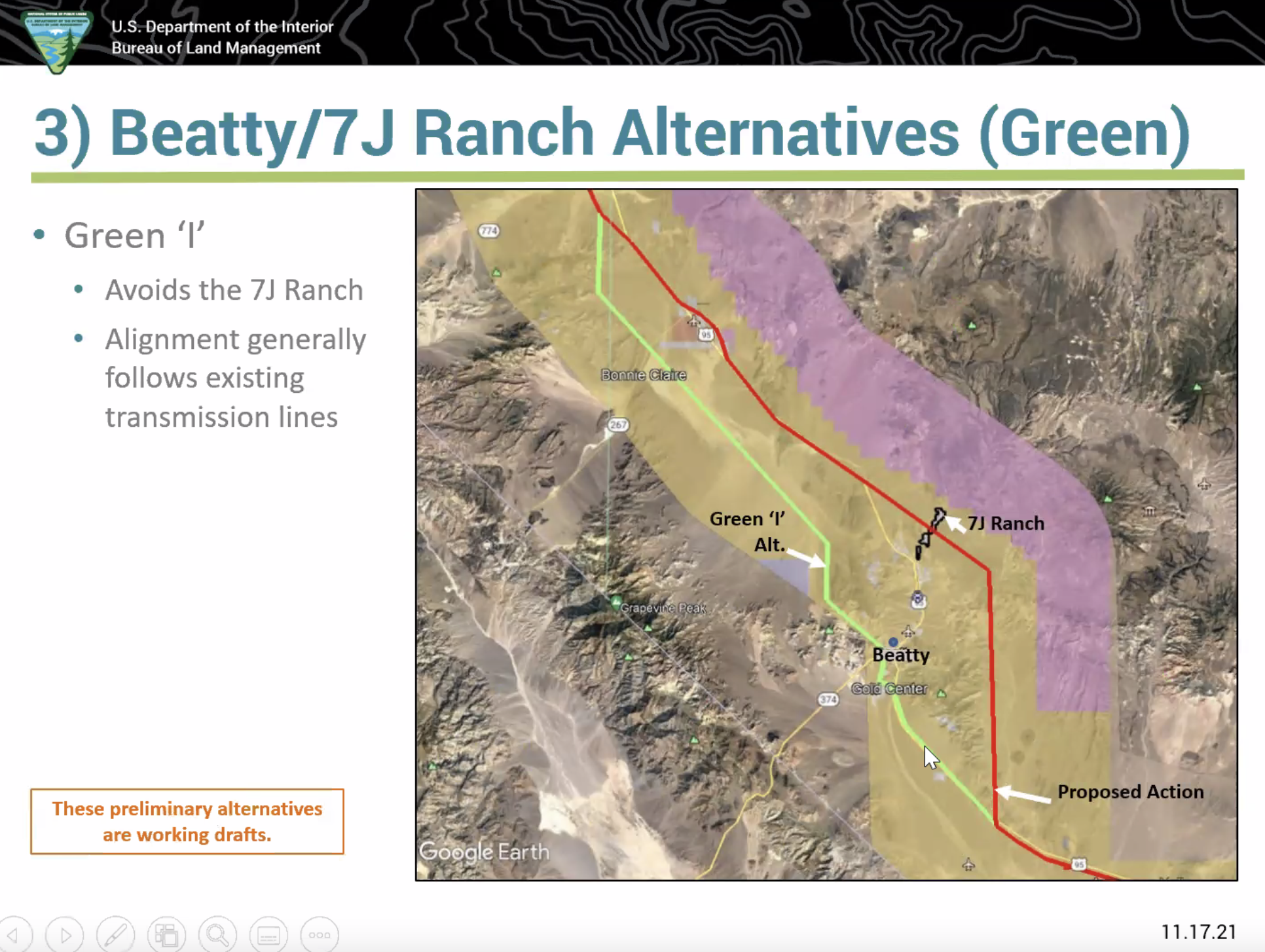
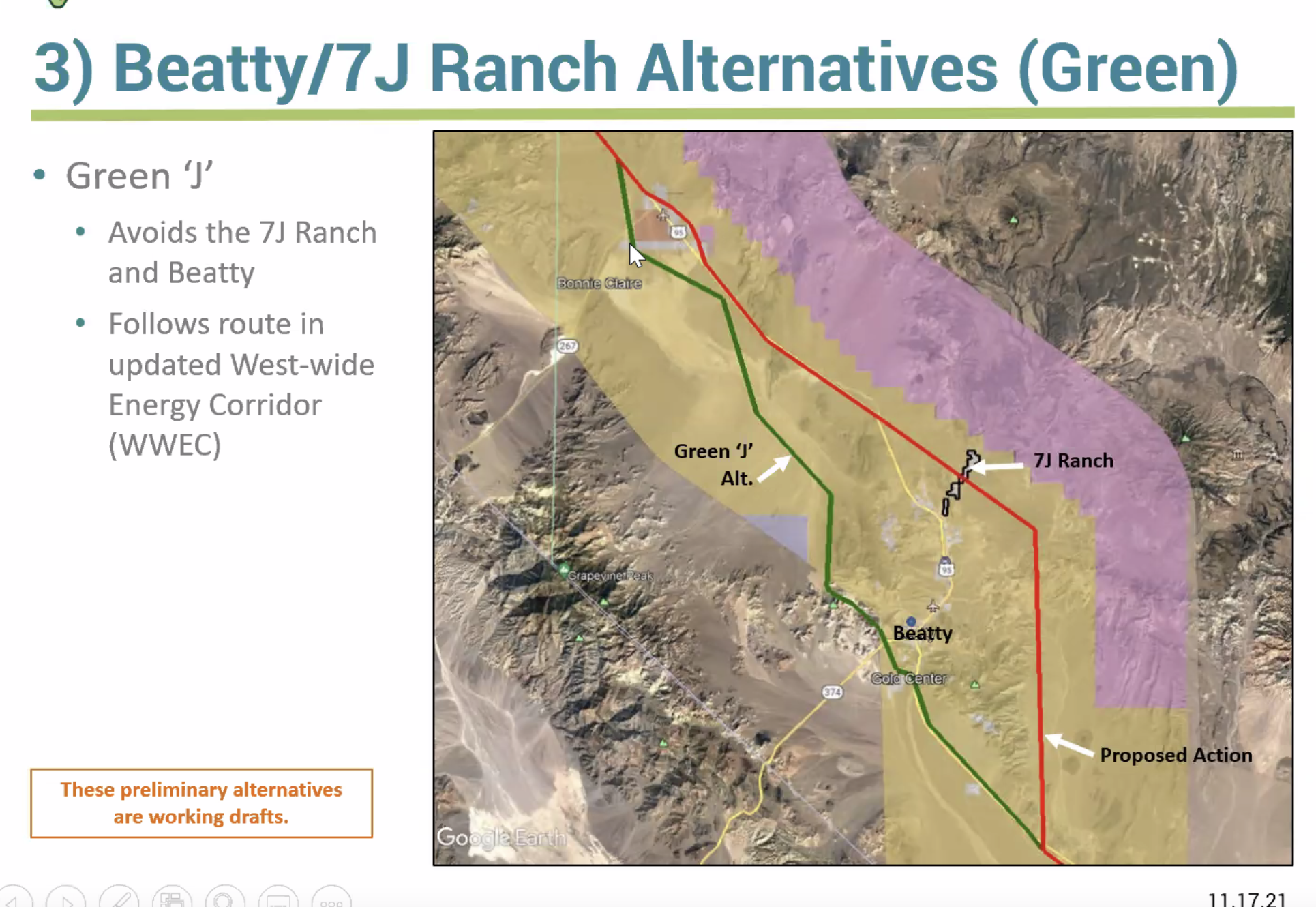
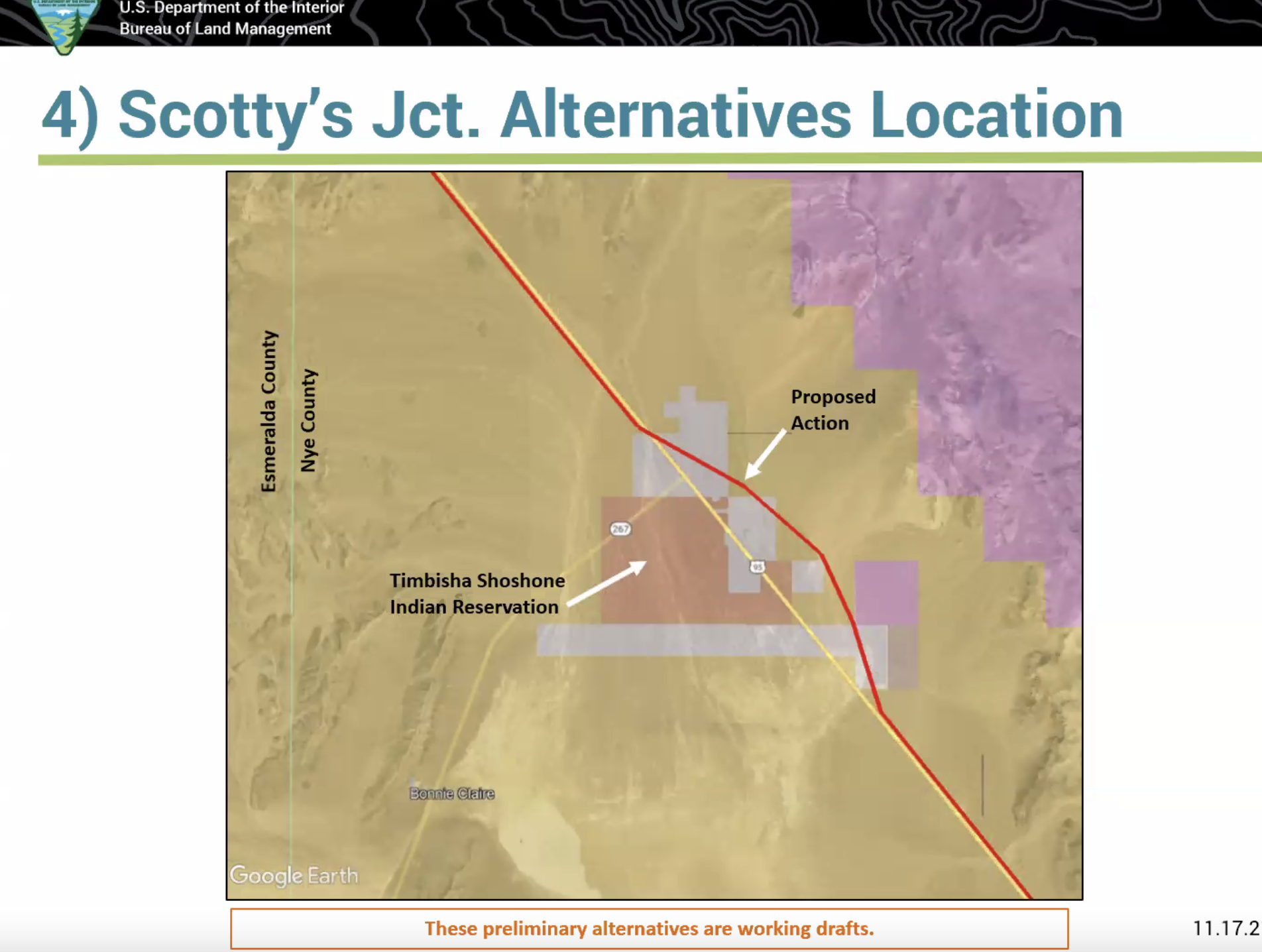
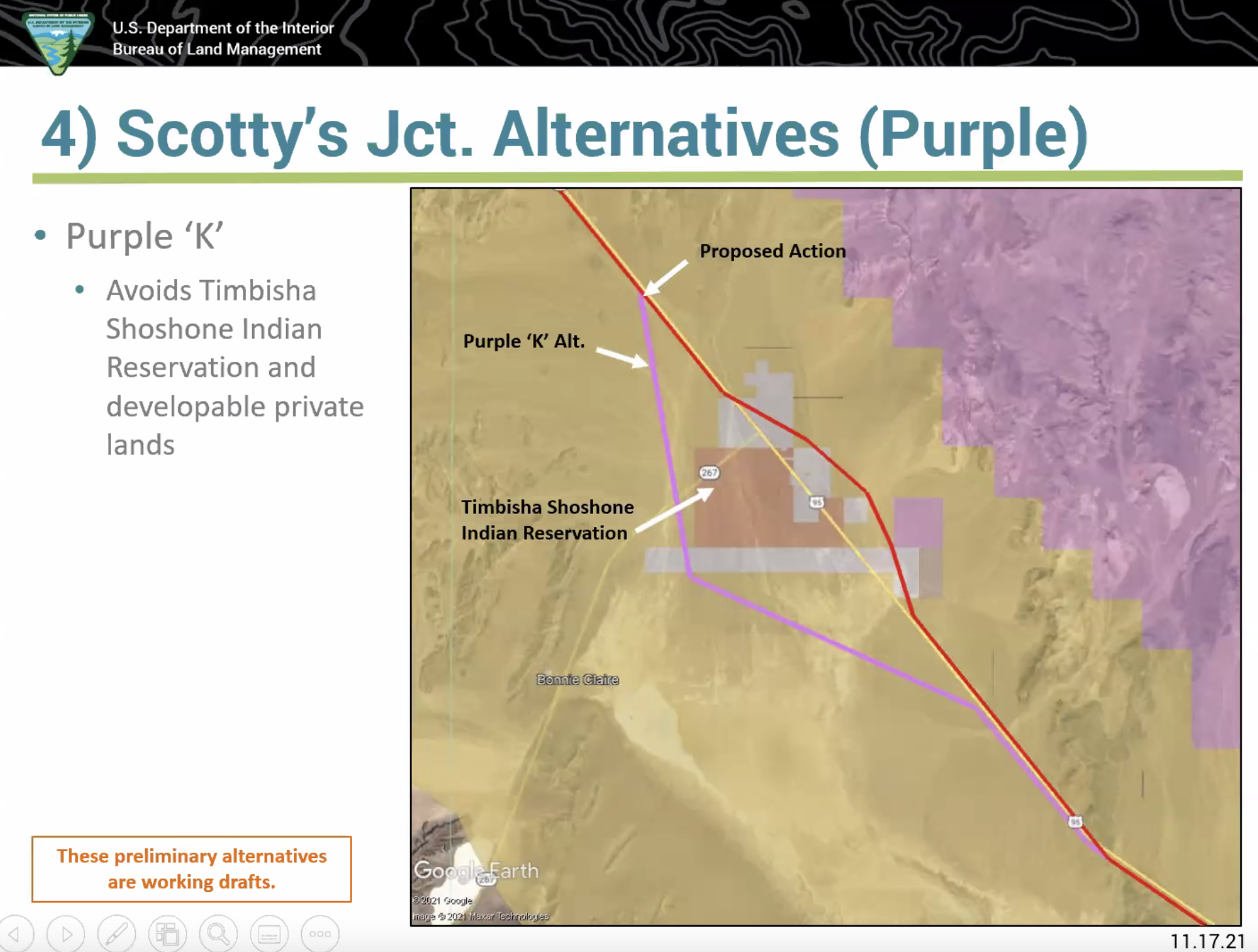
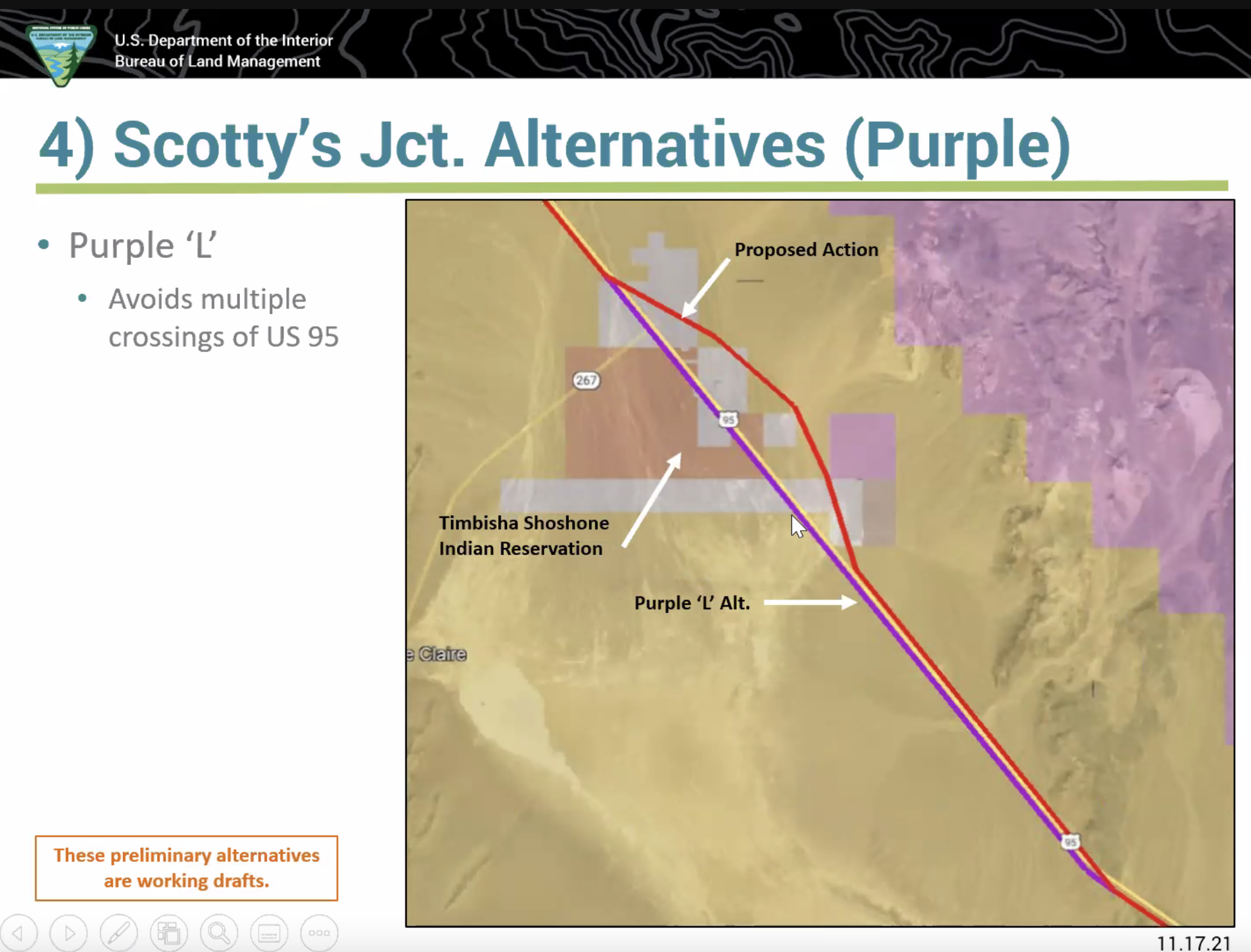
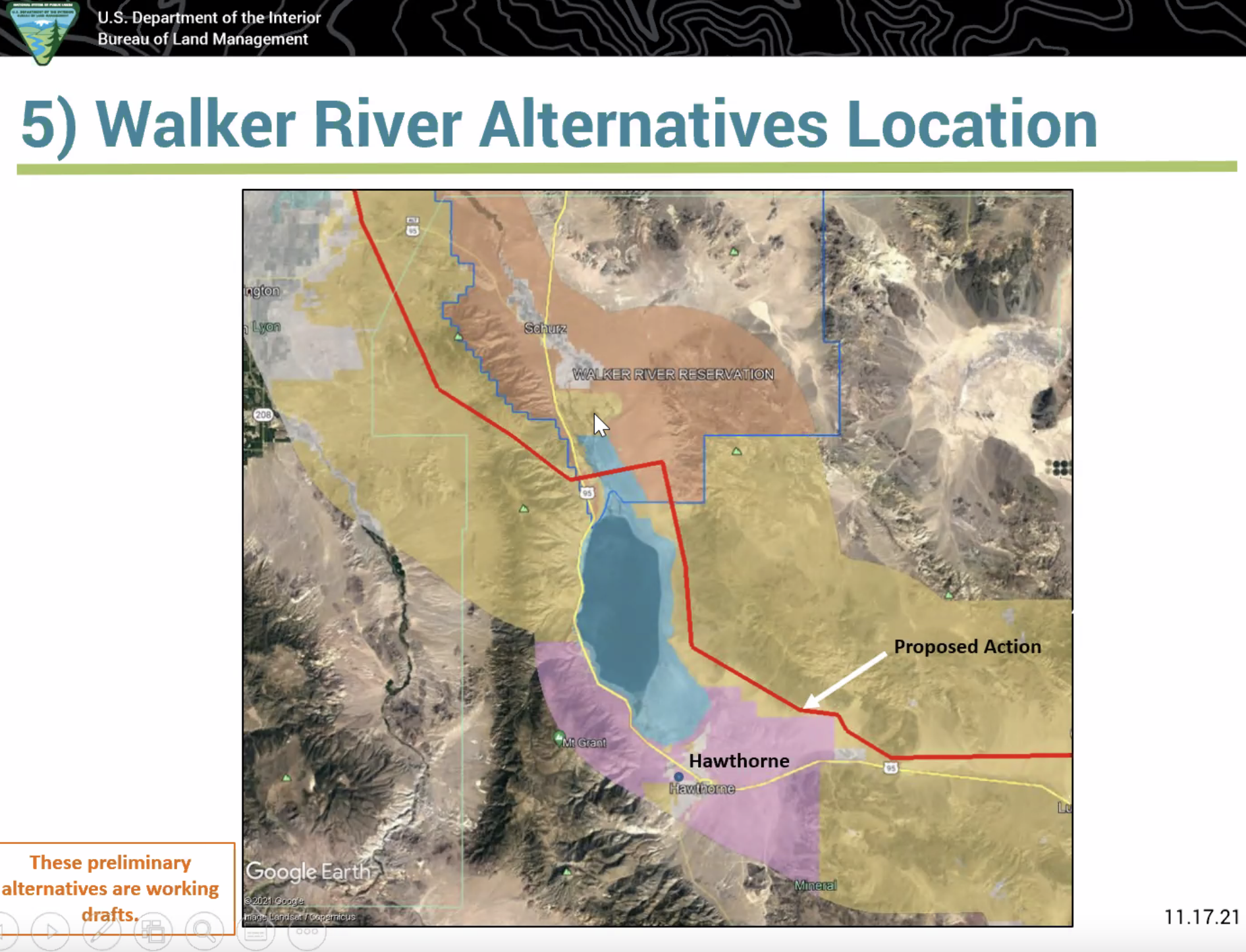
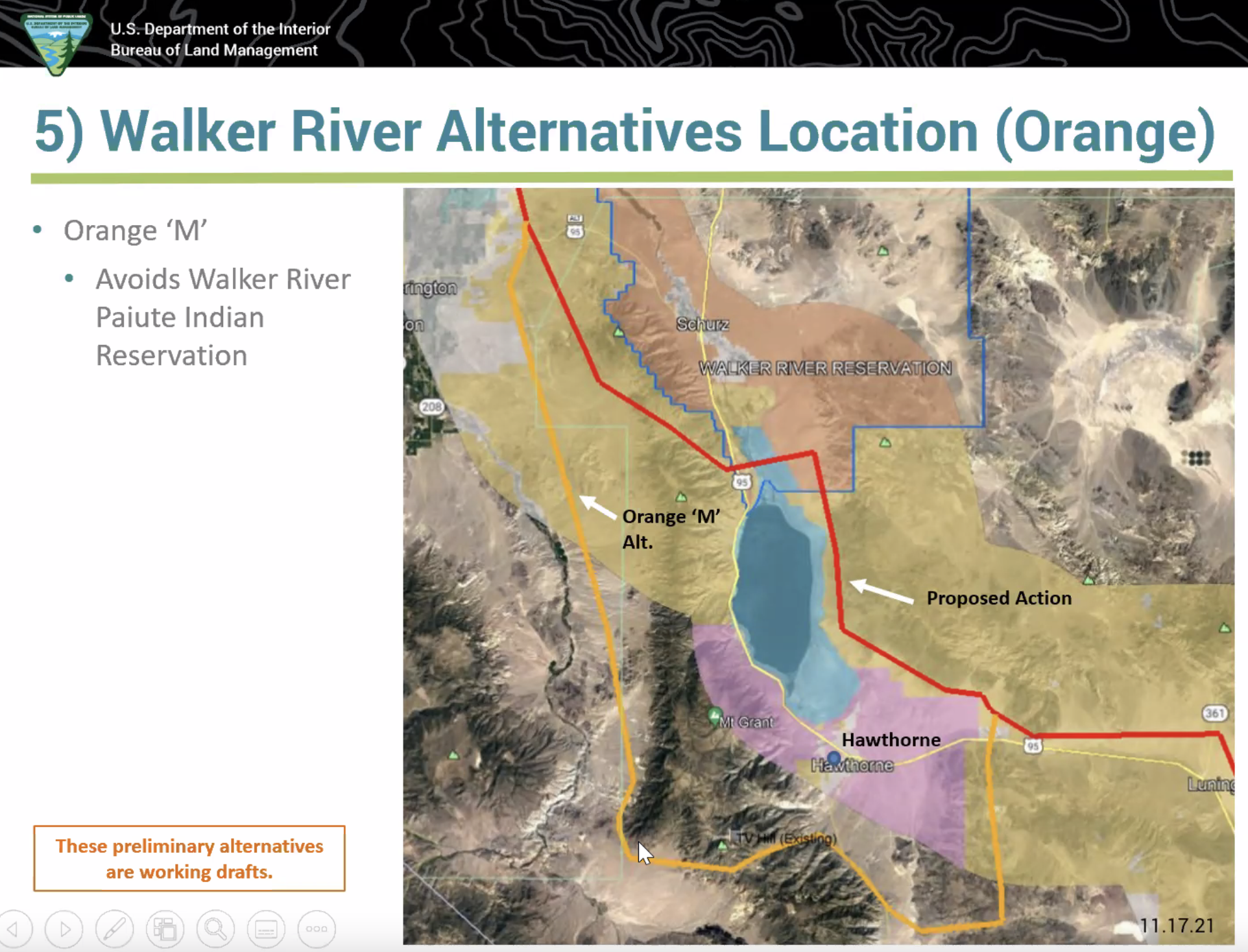
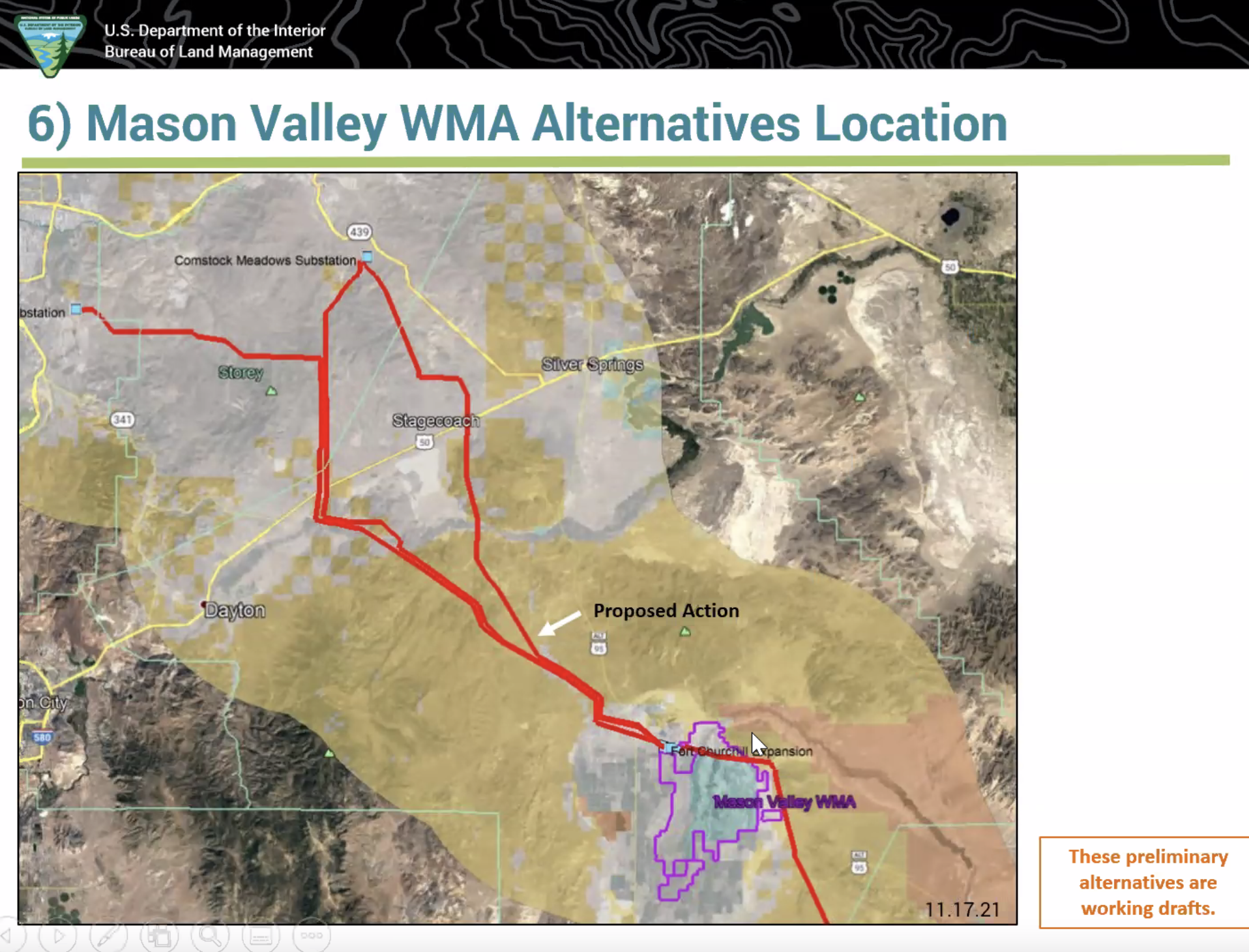
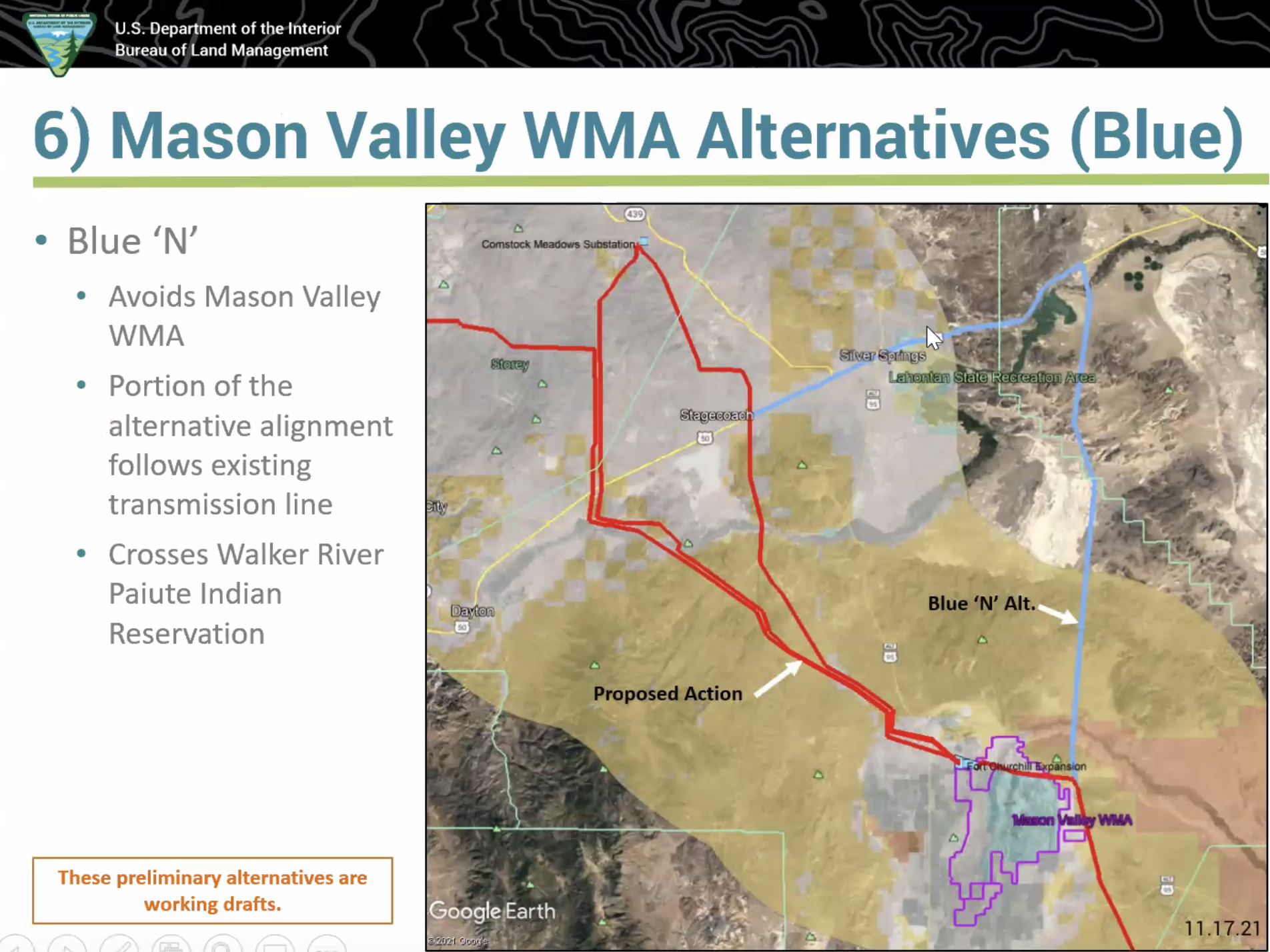
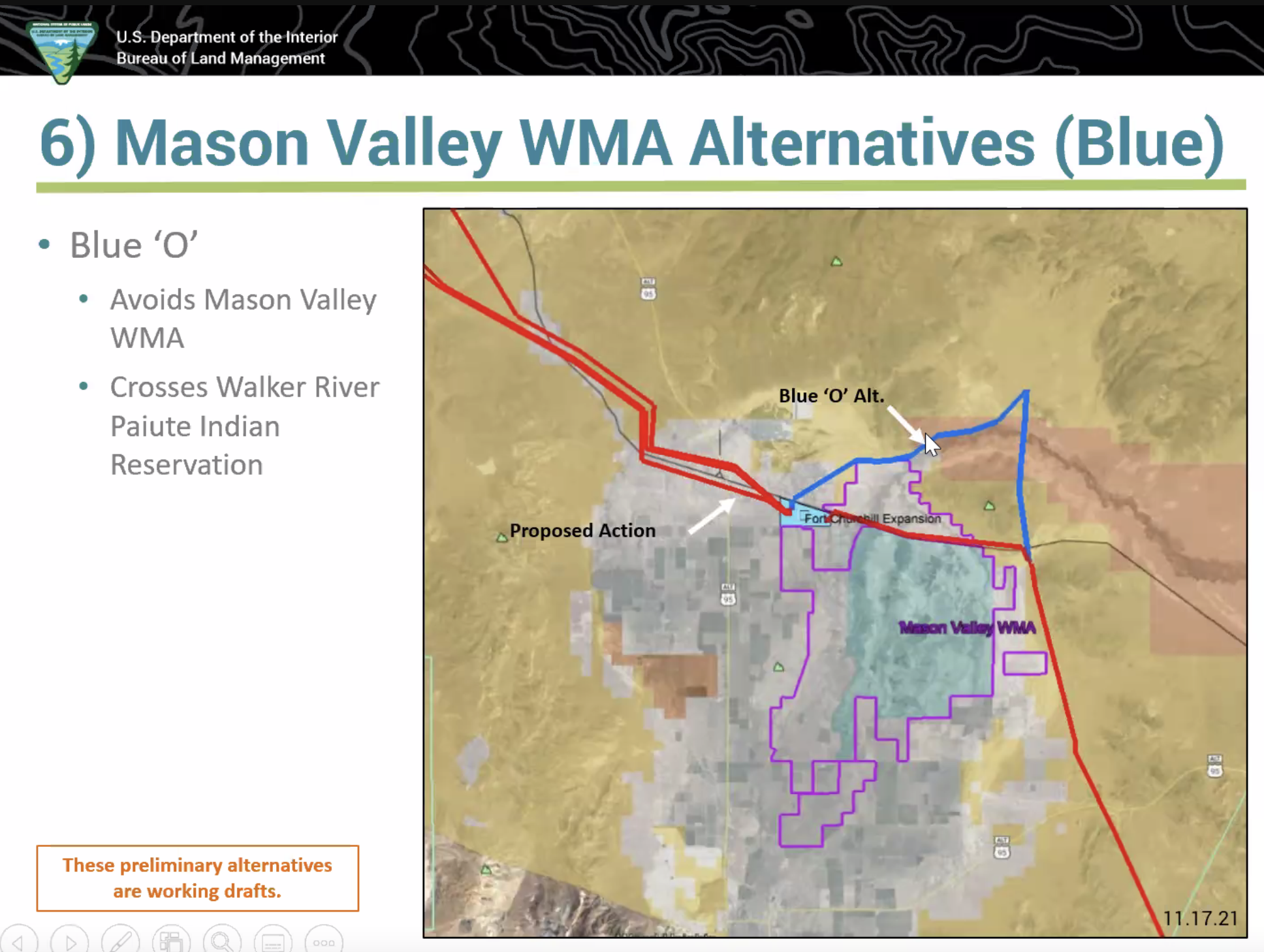
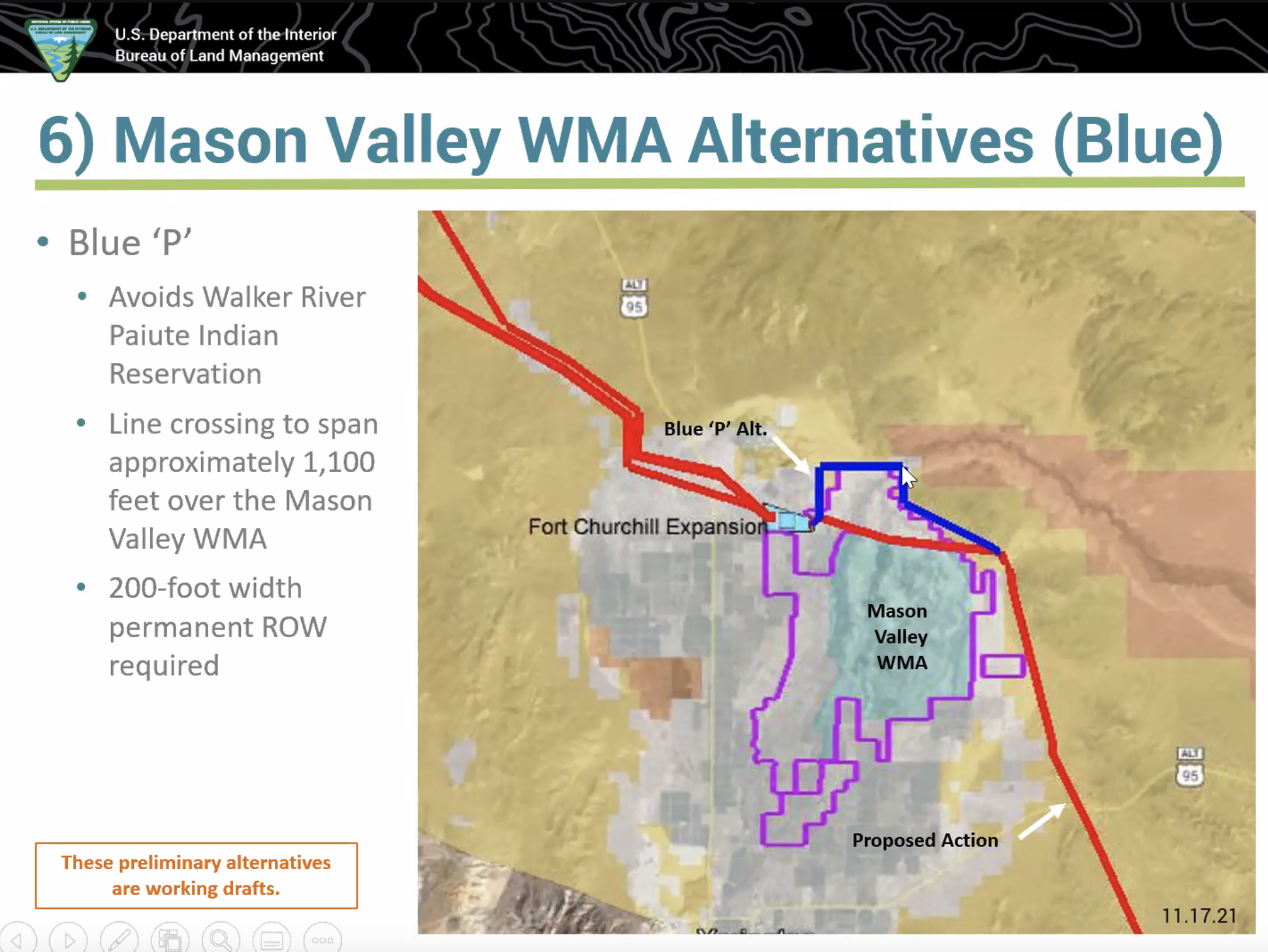
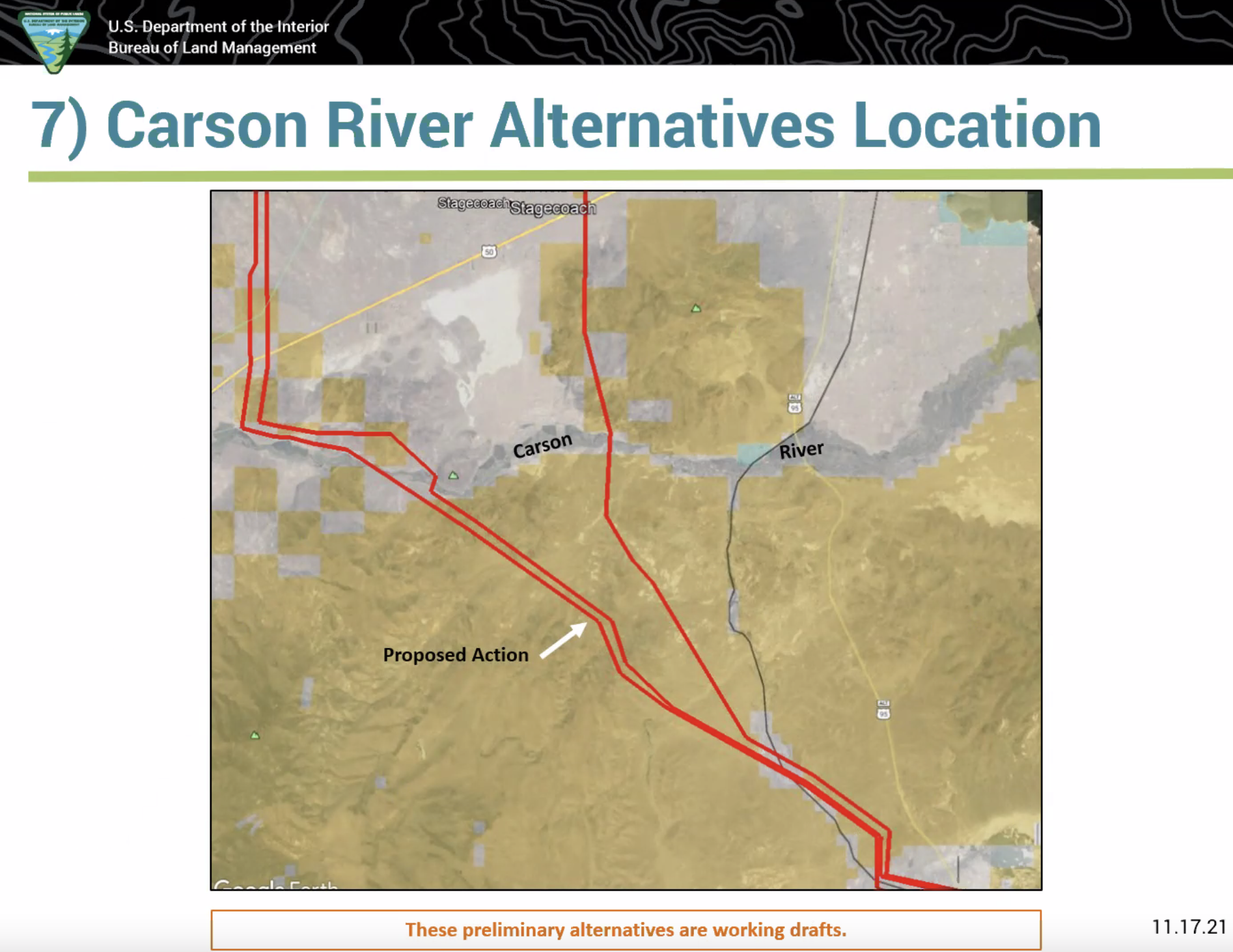
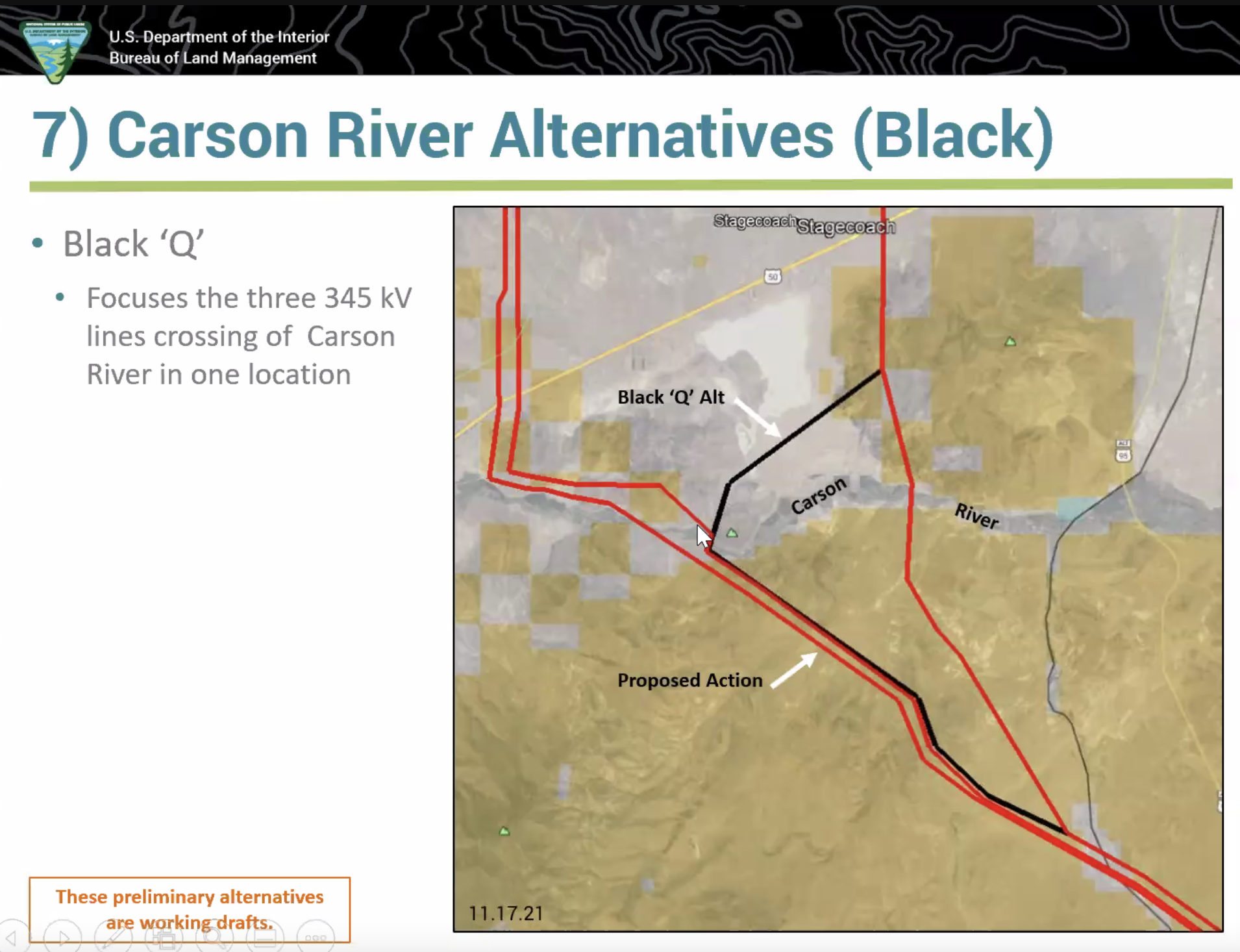
June Public Meetings
Monday, June 21 - Centennial Hills Library, Multipurpose Room, 6711 North Buffalo Dr., Las Vegas, NV 89131.
Tuesday, June 22 - Beatty Town Community Center, 100 Avenue South, Beatty NV 89003
Wednesday June 23 - Mineral County Library, 110 First St., Hawthorne, NV 89415.
Thursday June 24 - Yerington City Hall Building, 102 South Main St., Yerington NV89447.
Each meeting workshop will start at 5:00 PM, and repeat at 6:00 PM Pacific.
The Greenlink West Transmission Project environmental review under the National Environmental Policy Act is due in April 2022--this is fast-tracked since we still have not been able to see detailed maps or other information from BLM.
Oppose Nevada Senate Bill 448 and the Green Link West Transmission Line
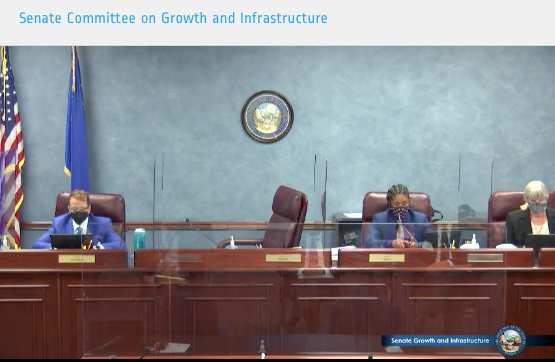
^Livestream screenshot of the Nevada Senate Committee on Growth and Infrastructure hearing Senate Bill 448.
May 18, 2021 - Carson City, NV - Democracy in action? Or corporate influence on display.... Back in the state capitol at the Nevada State Legistature, on Thursday, May 17th, the Senate Committee on Growth and Infrastructure debated the hastily-introduced Senate Bill 448, revising provisions governing public utilities. The bill will require NV Energy to outline plans to construct high voltage transmission infrastructure in Nevada by 2029 and forms a task force to expedite planning for transmission in Nevada.
The Nevada Public Utilities Commission approved the Greenlink West line in March 2021. The Bureau of Land Management has told us that the Environmental Impact Statement will be released in 2023 and the project may be COMPLETE by 2026.
We listened in to the livestream of the committee hearing late in the day on May 17, which was a confusing process and not publicly friendly. Several commenters on this agenda item who sought to oppose, were cut off on the phone and could not speak.
SB 448 -- Revises provisions governing public utilities -- was introduced quietly and quickly just before a weekend into the Nevada state Senate by Chris Brooks (Democratic Nevada state Senator of District 3) and several co-sponsors. The bill was referred to the Committee on Growth and Infrastructure with barely any time for the public to read the bill and participate in a fair Democratic process.
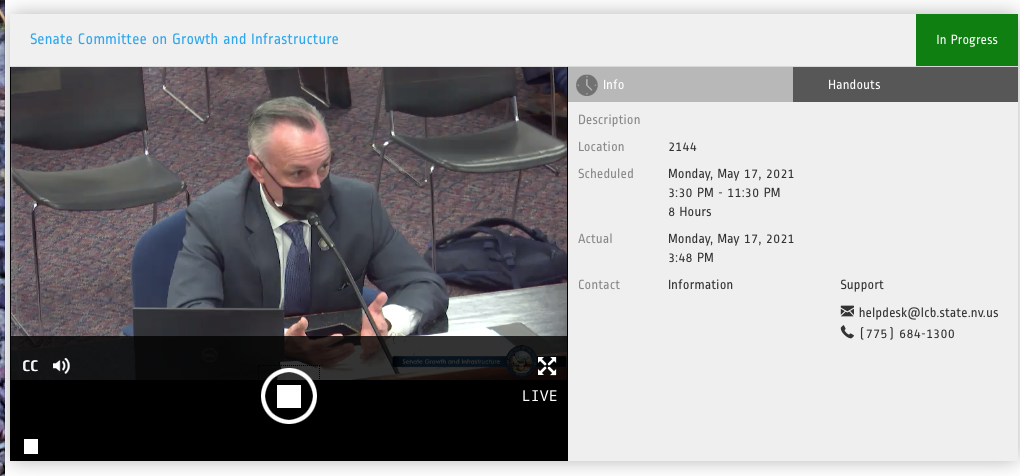
^Nevada Senator Chris Brooks answering questions about SB448 in the hearing on the Senate Floor during a livestream. Supporting commentors described Brooks as a former electrician. (He is not, apparently, an environmentalist in our opinion).
Fielding questions from the committee about the bill, Brooks quickly tried to explain that "it's about leveraging ratepayer funds," in order to build out transmission in Nevada.
But this reveals the crux of the problem: ratepayers under boht Investor-owned utlities such as NV Energy and even cooperative utilities will be handed a very large bill to pay for such giant and expensive transmission line projects proposed to be constructed across the remote Nevada public lands. Electicity bills will go up, as was revealed during the hearing.
During the hgearing this Nevada "Electric Highway" or "Electric Avenue" was debated -- the name was not even agreed upon.
A representative from NV Energy testified in person that they were going to the Nevada Public Utilities Commission with numerous large-scale solar projects paired with Lithium battery storage projects. He referreed to 1,028 megawatts (MW) of of storage Power Purchase Agreements (PPAs) in the works. They are seeking to shift solar production from midday to later in the day when peak energy usage is now occurring--from 4-9 PM. But no discussion of the overgeneration problem of large-scale solar projects was discussed, and how Distributed Generation could truly alleviate this problem.
It was pointed out that Lithium battery storage is short-term, and will only provide 4 hours-maximin of storahe on thre grid. Hydrogen energy can be stored for much longer times.
Committe Chair Dallas Harris (Democrat-District 11 in Las Vegas) asked about the impacts of the bill to transmission-only customers, who might not see the benefits of this bill.
A transmission-only utility allows energy producers to focus solely on transporting electric power from where its generated to where its needed. This could incude a massive build-out of rooftop and carport solar energy in Las Vegas and Reno, avoiding high-cost environmental impacts to Nevada's remote wildlands, rural communities, and rare species habitats.
One thing is clear: utility customers may not see any benefits from this bill. Cahir Harris reiterated that ratepayers will be taking on all the costs for this large-scale trasnmsiion construction. She asked, what is the utility willing to do to protect ratepayers? The costs for this high-voltage transmission line appear to be passed on to ratepayers, Harris said.
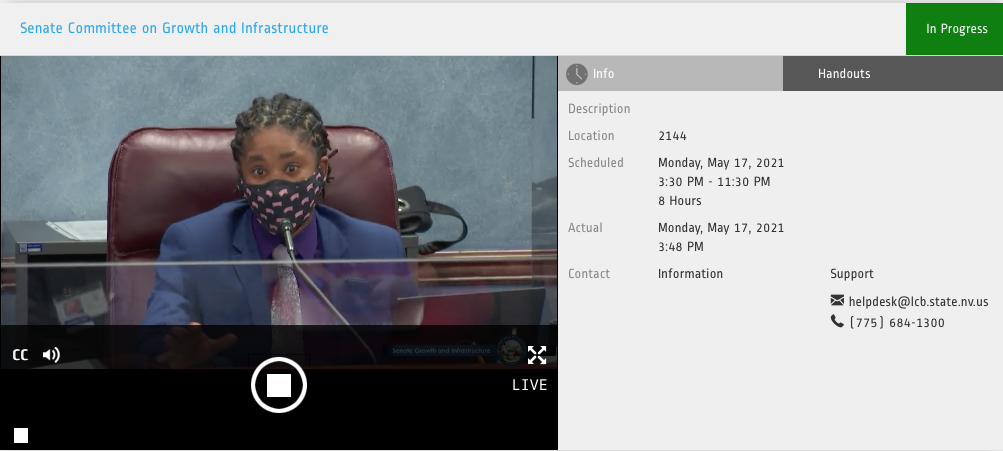
^Committe Chair Dallas Harris asks hard questions to Senator Brooks.
Our email alert that went out last week included these points to help the public understand the impacts of the bill.
About the Green Link Large High-Voltage Transmission Projects:
• Greenlink West would be a 525 kV line that spans approximately 350 miles from Las Vegas, NV to Yerington, NV. This one is the first priority.
• Greenlink North would be a 525 kV line that spans approximately 235 miles from Ely, NV to Yerington, NV.
• Greenlink Nevada will also include three 345 kV lines from Yerington, NV to the Reno, NV area and creates a renewable energy highway that allows access to Nevada’s remote public lands ecosystems, with the potential of about 5,000 megawatts of undeveloped renewable resources that could not previously be developed due to the lack of transmission infrastructure. This is Nevada's Outback -- it should not be opened up to utility-scale solar, wind, and geothermal development.
The Green Link West Project is being pushed first. TOP TEN REASONS to Say NO:
1. The Green Link West Project will be located on 80 percent Federal Land, but on 20 percent private land and require property seizure or eminent domain in the Mira Loma area near Reno, Nevada.
2. The project will also most likely require eminent domain is regions around Yerington, Hawthorn, Goldfield, Beatty and Las Vegas, Nevada.
3. The transmission line would be built near and enable huge solar projects next to Death Valley National Park.
4. The Green West Line will have to traverse part of Walker Lake. A large transmission line can kill birds through collision and electrocution. Walker Lake is an important Bald Eagle wintering area.
5. The Green Link West line will go through important habitat for pronghorn, including slicing through an antelope fawning ground. The line will use big guy wires to keep itself standing. These big wires have killed large game animals like wild horses by decapitating them.
^Pronghorn antelope mother and her newborn fawn, in a northern Mojave Desert fawning ground apparently right in the path of the proposed large high-voltage Greenlink West transmission line in Nye County, NV. Photo: Kevin Emmerich.
6. The Green Link lines will traverse Priority Sage Grouse habitat. Transmission harms habitat, causes wildfire risk, causes collision risk and creates perches for ravens which prey on sage grouse.
7. The Green Link Lines will go through important desert tortoise habitat. They will damage the habitat and create perches for ravens which prey on young tortoises.
8. The Green Link Lines will go over many ridges and vegetated areas. As we know, climate change induced droughts and heat are getting worse and transmission lines are now the cause of catastrophic wildfires. The recent Camp Fire in California was started by a faulty PG&E transmission line and killed over 100 people.
9 . There is concern that Greenlink West transmission will be very expensive and the cost passed on to ratepayers. See the article in The Nevada Independent.
The Green Link Lines are being built to enable dozens of new solar, wind and geothermal projects. These will:
- Create fugitive dust.
- Impact thousands of acres if habitat for the Federally Threatened Mojave desert tortoise.
- Lower property values in Amargosa Valley, Nevada, and elsewhere.
- Impact sage-grouse habitat.
- Create visual eyesores.
- Destroy Native American cultural sites and landscapes.
- Destroy Joshua tree habitat. The Joshua tree is now protected as state Endangered in California.
- Use too much water for construction.
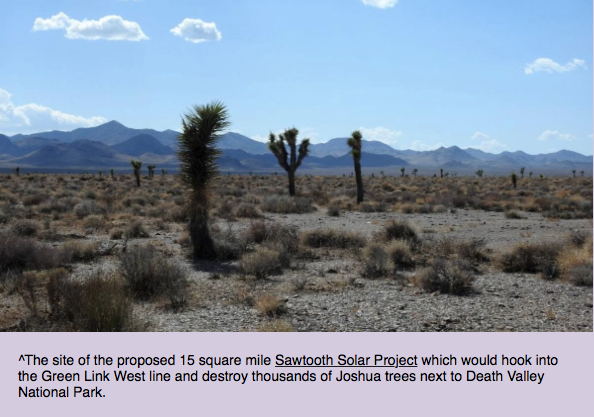
What you can do:
Share your opinion with Nevada Legislators on this page and Oppose SB 448 and the Green Link Transmission Lines. Type in the Bill Number and vote "AGAINST".
In the comments section, explain that the Green Link Lines will harm wildlife, wilderness values, hurt private property and change the character of rural Nevada. Say NO to the Green Link Transmission Lines! (You do not need to be from Nevada to oppose this.)
Greenlink West and North Transmission Lines: Opening Up Energy Development in Nevada Wildlands and Rural Areas
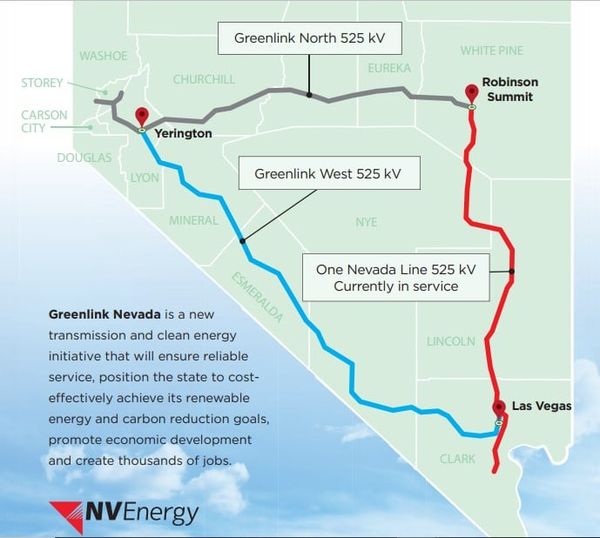
March 6, 2021 - Western Nevada public lands and private properties - New Nevada Transmission Lines: Greenlink West and North are coming to the wildlands and deserts near you.
Greenlink West will go from the Mira Loma Substation near Reno to Las Vegas. NV Energy has already hired contractors to do biology studies. The new Interior Department is using Secretarial Order 3355 issued by the Trump Administration to fast track this one. That means the entire review must be complete in one year. The Environmental Impact Statement will come out in 2023 and Bureau of Land Management says the project will be built by 2026. That is the Biden Administration falling back on the Trump Administration. We are told there will be a number of eminent domain cases just for the Greenlink West line. The goal of both projects is to enable tens of thousands of acres of new solar, wind, pumped storage and geothermal projects in remote Nevada locations.
Greenlink West would be a high-voltage large-scale transmission line that would slash through significant natural and cultural resource areas in Nevada, including Walker Lake, potential range of the Bi-State Distinct Population Segement of greater sage-grouse, the Amargosa River, oasis Valley full of endemic spring snails, the Amargosa toad, speckled dace, and riparian habitat for migratory birds and recovering species such as Bell's vireo. This badly-planned transmission line would also open up Amargosa Valley to widespread and uncontrolled solar development, on deserts that are a hotspot for burrowing owls and desert kit foxes.
http://clearinghouse.nv.gov/public/Notice/2021/E2021-098.pdf
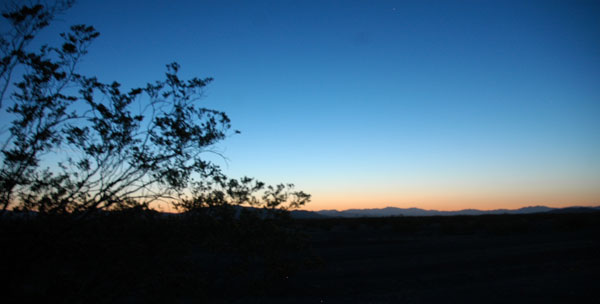
^Dusk in Amargosa Valley, Nevada.
Greenlink North would parallel the Loneliest Highway--US 50, opening up large swaths of rural areas and sagebrush steppe to solar projects and other development.
HOME.....Transmission.....Beatty Solar Energy Center.....Sawtooth Solar Project.....Sarcobatus Flat
